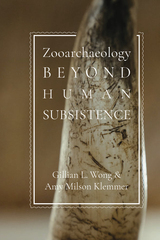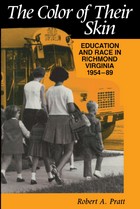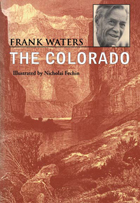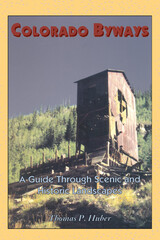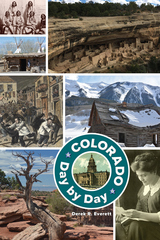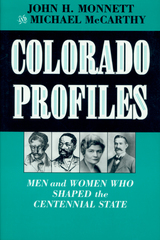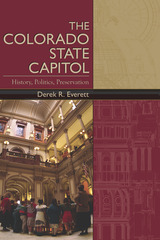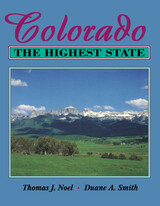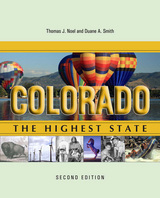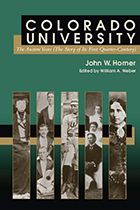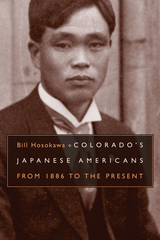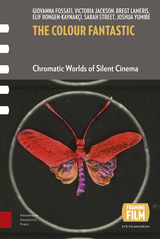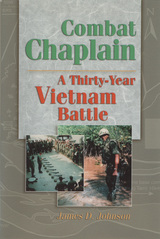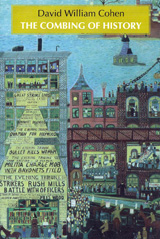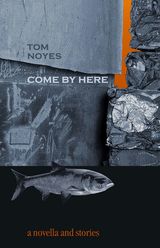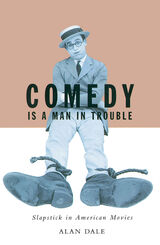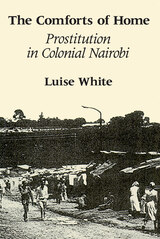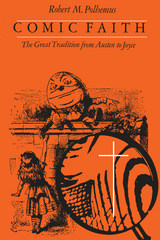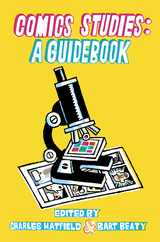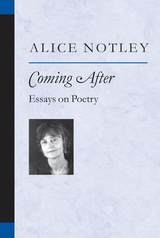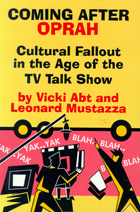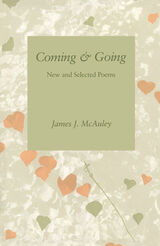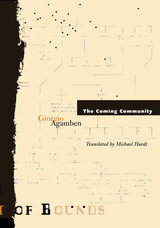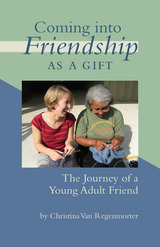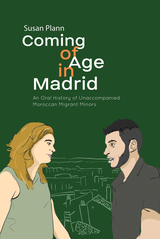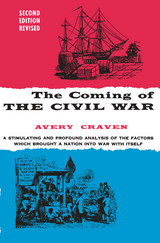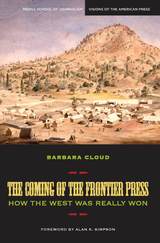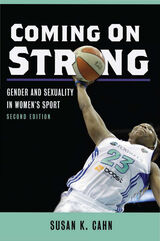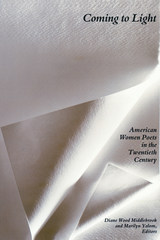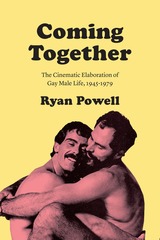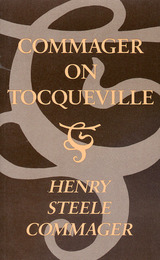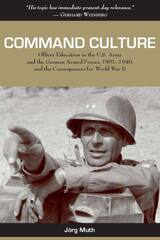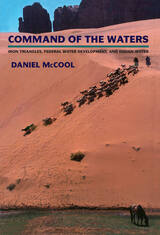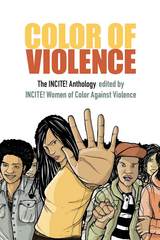 Color of Violence: The INCITE! Anthology
INCITE! Women of Color Against Violence, editor
Duke University Press, 2016 The editors and contributors to Color of Violence ask: What would it take to end violence against women of color? Presenting the fierce and vital writing of organizers, lawyers, scholars, poets, and policy makers, Color of Violence radically repositions the antiviolence movement by putting women of color at its center. The contributors shift the focus from domestic violence and sexual assault and map innovative strategies of movement building and resistance used by women of color around the world. The volume's thirty pieces—which include poems, short essays, position papers, letters, and personal reflections—cover violence against women of color in its myriad forms, manifestations, and settings, while identifying the links between gender, militarism, reproductive and economic violence, prisons and policing, colonialism, and war. At a time of heightened state surveillance and repression of people of color, Color of Violence is an essential intervention.
Contributors. Dena Al-Adeeb, Patricia Allard, Lina Baroudi, Communities Against Rape and Abuse (CARA), Critical Resistance, Sarah Deer, Eman Desouky, Ana Clarissa Rojas Durazo, Dana Erekat, Nirmala Erevelles, Sylvanna Falcón, Rosa Linda Fregoso, Emi Koyama, Elizabeth "Betita" Martínez, maina minahal, Nadine Naber, Stormy Ogden, Julia Chinyere Oparah, Beth Richie, Andrea J. Ritchie, Dorothy Roberts, Loretta J. Ross, s.r., Puneet Kaur Chawla Sahota, Renee Saucedo, Sista II Sista, Aishah Simmons, Andrea Smith, Neferti Tadiar, TransJustice, Haunani-Kay Trask, Traci C. West, Janelle White
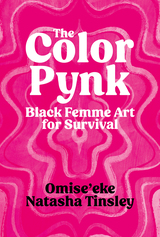 The Color Pynk: Black Femme Art for Survival
Omise'eke Natasha Tinsley
University of Texas Press, 2022 2023 John Leo & Dana Heller Award for Best Single Work, Anthology, Multi-Authored, or Edited Book in LGBTQ Studies, Popular and American Culture Association (PACA) / Popular Culture Association (PCA) 2023 Honorable Mention, Harry Shaw and Katrina Hazzard-Donald Award for Outstanding Work in African-American Popular Culture Studies, Popular and American Culture Association (PACA) / Popular Culture Association (PCA)
2024 MPCA/ACA Best Single Work by One or More Authors, Midwest Popular Culture Association / Midwest American Culture Association (MPCA/ACA)
A celebration of the distinctive and politically defiant art of Black queer, cis-, and transfemmes, from the work of Janelle Monáe and Janet Mock to that of Indya Moore and Kelsey Lu.
The Color Pynk is a passionate exploration of Black femme poetics of survival. Sidelined by liberal feminists and invisible to mainstream civil rights movements, Black femmes spent the Trump years doing what they so often do best: creating politically engaged art, entertainment, and ideas. In the first full-length study of Black queer, cis-, and trans-femininity, Omise’eke Natasha Tinsley argues that this creative work offers a distinctive challenge to power structures that limit how we color, gender, and explore freedom.
Tinsley engages 2017–2020 Black femme cultural production that colorfully and provocatively imagines freedom in the stark white face of its impossibility. Looking to the music of Janelle Monáe and Kelsey Lu, Janet Mock’s writing for the television show Pose, the fashion of Indya Moore and (F)empower, and the films of Tourmaline and Juliana Huxtable, as well as poetry and novels, The Color Pynk conceptualizes Black femme as a set of consciously, continually rescripted cultural and aesthetic practices that disrupts conventional meanings of race, gender, and sexuality. There is an exuberant defiance in queer Black femininity, Tinsley finds—so that Black femmes continue to love themselves wildly in a world that resists their joy.
The Colorado
Frank Waters
Ohio University Press, 1985
The vast Colorado River collects water from the highest Rocky Mountain peaks and traverses the widest plateaus, the deepest canyons, and the lowest deserts before emptying into the delta of northern Mexico. This austere land and mighty river resist exploration, settlement, and description. But in the hands of one of the West’s great writers, Frank Waters, the history and lore of its past make irresistible reading and a resounding case for mankind’s respect for the environment.
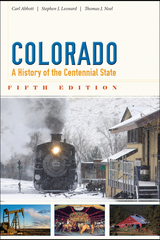 Colorado: A History of the Centennial State, Fifth Edition
Carl Abbott
University Press of Colorado, 2013 Since 1976, newcomers and natives alike have learned about the rich history of the magnificent place they call home from Colorado: A History of the Centennial State. In the fifth edition, coauthors Carl Abbott, Stephen J. Leonard, and Thomas J. Noel incorporate recent events, scholarship, and insights about the state in an accessible volume that general readers and students will enjoy.
The fifth edition tells of conflicts, shifting alliances, and changing ways of life as Hispanic, European, and African American settlers flooded into a region that was already home to Native Americans. Providing a balanced treatment of the entire state’s history—from Grand Junction to Lamar and from Trinidad to Craig—the authors also reveal how Denver and its surrounding communities developed and gained influence.
While continuing to elucidate the significant impact of mining, agriculture, manufacturing, and tourism on Colorado, this edition broadens and focuses its coverage by consolidating material on Native Americans into one chapter and adding a new chapter on sports history. The authors also expand their discussion of the twentieth century with updated sections on the environment, economy, politics, and recent cultural conflicts. New illustrations, updated statistics, and an extensive bibliography including Internet resources enhance this edition.
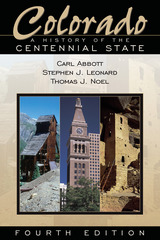 Colorado: A History of the Centennial State, Fourth Edition
Carl Abbott
University Press of Colorado, 2005 Since 1976 newcomers and natives alike have learned about the rich history of the magnificent place they call home from Colorado: A History of the Centennial State. In this revised edition, co-authors Carl Abbott, Stephen J. Leonard, and Thomas J. Noel incorporate more than a decade of new events, findings, and insights about Colorado in an accessible volume that general readers and students will enjoy.
The new edition tells of conflicts, new alliances, and changing ways of life as Hispanic, European, and African American settlers flooded into a region that was already home to Native Americans. Providing balanced coverage of the entire state's history - from Grand Junction to Lamar and from Trinidad to Craig - the authors also reveal how Denver and its surrounding communities developed and gained influence.
While continuing to elucidate the significant impact of mining, agriculture, manufacturing, and tourism on Colorado, this new edition broadens its coverage. The authors expand their discussion of the twentieth century with several new chapters on the economy, politics, and cultural conflicts of recent years. In addition, they address changes in attitudes toward the natural environment as well as the contributions of women, Hispanics, African Americans, and Asian Americans to the state. Dozens of new illustrations, updated statistics, and an extensive bibliography of the most recent research on Colorado history enhance this edition.
Colorado Day by Day
Derek Everett
University Press of Colorado, 2019 Copublished with History Colorado
Colorado Day by Day is an engaging, this-day-in-history approach to the key figures and forces that have shaped Colorado from ancient times to the present. Historian Derek R. Everett presents a vignette for each day of the calendar year, exploring Colorado’s many facets through distilled tales of people, places, events, and trends.
Entries incorporate tales from each of the state’s sixty-four counties and feature both well-known and obscure cultural moments, including events in Native American, African American, Asian American, Hispano, and women’s history. Allowing the reader to explore the state’s heritage as individual threads or as part of the greater tapestry, Colorado Day by Day recovers much lost history and will be an entertaining and useful source of lore for anyone who enjoys or is curious about Colorado history.
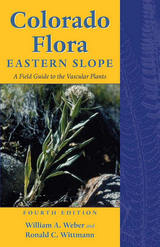 Colorado Flora: Eastern Slope, Fourth Edition
A Field Guide to the Vascular Plants
William A. Weber
University Press of Colorado, 2011 Colorado Flora: Eastern Slope describes the remarkable flora of the state—distinctive in its altitudinal range, numerous microhabitats, and ancient and rare plants— and educates local amateurs and professionals in the recognition of vascular plant species and encourage informed stewardship of our biological heritage. When used alongside Colorado Flora: Western Slope, the full scope of the flora of the front range is at your fingertips. The revised and updated editions reflect current taxonomic knowledge. The authors describe botanical features of this unparalleled biohistorical region and its mountain ranges, basins, and plains and discuss plant geography, giving detailed notes on habitat, ecology, and range. The keys recount interesting anecdotes and introductions for each plant family. The book is rounded out with historical background of botanical work in the state, suggested readings, glossary, index to scientific and common names, references, and hundreds of illustrations. The books also contain a new contribution from Donald R. Farrar and Steve J. Popovich on moonworts. The fourth editions of both Colorado Flora: Eastern Slope and Colorado Flora: Western Slope are ideal for both student and scientist and essential for readers interested in Colorado's plant life.
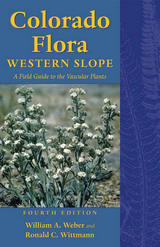 Colorado Flora: Western Slope, Fourth Edition
A Field Guide to the Vascular Plants
William A. Weber
University Press of Colorado, 2011 Colorado Flora: Western Slope describes the remarkable flora of the state, distinctive in its altitudinal range, numerous microhabitats, and ancient and rare plants. Together with Colorado Flora: Eastern Slope, Fourth Edition, these volumes are designed to educate local amateurs and professionals in the recognition of vascular plant species and encourage informed stewardship of our biological heritage. These thoroughly revised and updated editions reflect current taxonomic knowledge. The authors describe botanical features of this unparalleled biohistorical region and its mountain ranges, basins, and plains and discuss plant geography, giving detailed notes on habitat, ecology, and range. The keys contain interesting anecdotes and introductions for each plant family. The book is rounded out with historical background of botanical work in the state, suggested readings, glossary, index to scientific and common names, references, and hundreds of illustrations. The books also contain a new contribution from Donald R. Farrar and Steve J. Popovich on moonworts. The fourth editions of Colorado Flora: Eastern Slope and Colorado Flora: Western Slope are ideal for both student and scientist and essential for readers interested in Colorado's plant life.
Colorado Gem Trails: And Mineral Guide
Richard M. Pearl
Ohio University Press, 1972 This famous book takes you on an extensive gem and mineral collecting tour of Colorado, revealing the interesting places where Nature has stored her treasures.
Detailed directions are given for reaching the noted as well as the little-known localities in all sections of this great mineral-producing state. Included are numerous mileage logs never before published, and many sketch maps made especially for this book. A unique system arranges the localities along segments of the main highways.
Latest information is given on local travel and collecting conditions and land ownership, so much desired by collectors who want to make the best use of their time. Gem and mineral societies that welcome visitors — museums that display outstanding collections — are all described. Official maps and references to the literature are listed.
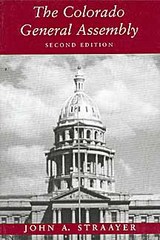 The Colorado General Assembly, Second Edition
John A. Straayer
University Press of Colorado, 2000 The Legislature is the dominant branch of government in Colorado. Yet until now, there has been no single study that so richly portrays this powerful institution and the nature of its membership. The Colorado General Assembly is based on years of author John Straayer's first-hand observations, his review of original documents and secondary sources, and hundred of conversations with lawmakers, lobbyists, members of the legislative staff, executive branch personnel, and journalists. In this lively, informative book, Straayer describes the formal structure of the Legislature, as well as the all-important process by which bills become or do not become law, and how the power center within the institution can move or kill legislative initiatives. He also examines the clout of the lobby corps, which outnumbers the elected lawmakers five to one; the way the Legislature dominates the budget process; and the manner by which divisions between the two parties, the two houses, and the legislative and executive branches impact the conduct of the public's business under Colorado's gold dome. The Colorado General Assembly fills a major gap in our knowledge of state government. It will appeal to students and practitioners of politics as well as to those with general interest in civic life.
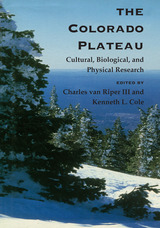 The Colorado Plateau: Cultural, Biological, and Physical Research
Charles van Riper
University of Arizona Press, 2004 Stretching from the four corners of Arizona, New Mexico, Colorado, and Utah, the Colorado Plateau is a natural laboratory for a wide range of studies. This volume presents 23 original articles drawn from more than 100 research projects presented at the Sixth Biennial Conference of Research on the Colorado Plateau. This scientific gathering revolved around research, inventory, and monitoring of lands in the region. The book's contents cover management techniques for cultural, biological, and physical resources, representing collaborative efforts among federal, university, and private sector scientists and land managers. Chapters on cultural concerns cover benchmarks of modern southwestern anthropological knowledge, models of past human activity and impact of modern visitation at newly established national monuments, challenges in implementing the 1964 Wilderness Act, and opportunities for increased federal research on Native American lands. The section on biological resources comprises sixteen chapters, with coverage that ranges from mammalian biogeography to responses of elk at the urban-wildland interface. Additional biological studies include the effects of fire and grazing on vegetation; research on bald eagles at Grand Canyon and tracking wild turkeys using radio collars; and management of palentological resources. Two final chapters on physical resources consider a proposed rerouting of the Rio de Flag River in urban Flagstaff, Arizona, and an examination of past climate patterns over the Plateau, using stream flow records and tree ring data. In light of similarities in habitat and climate across the Colorado Plateau, techniques useful to particular management units have been found to be applicable in many locations. This volume highlights an abundance of research that will prove useful for all of those working in the region, as well as for others seeking comparative studies that integrate research into land management actions.
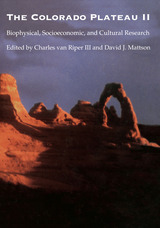 The Colorado Plateau II: Biophysical, Socioeconomic, and Cultural Research
Edited by Charles van Riper III and David J. Mattson
University of Arizona Press, 2005 The publication of The Colorado Plateau: Cultural, Biological, and Physical Research in 2004 marked a timely summation of current research in the Four Corners states. This new volume, derived from the seventh Biennial Conference on the Colorado Plateau in 2003, complements the previous book by focusing on the integration of science into resource management issues. The 32 chapters range in content from measuring human impacts on cultural resources, through grazing and the wildland-urban interface issues, to parameters of climate change on the Plateau. The book also introduces economic perspectives by considering shifting patterns and regional disparities in the Colorado Plateau economy. A series of chapters on mountain lions explores the human-wildland interface. These chapters deal with the entire spectrum of challenges associated with managing this large mammal species in Arizona and on the Colorado Plateau, conveying a wealth of timely information of interest to wildlife managers and enthusiasts. Another provocative set of chapters on biophysical resources explores the management of forest restoration, from the micro scale all the way up to large-scale GIS analyses of ponderosa pine ecosystems on the Colorado Plateau. Given recent concerns for forest health in the wake of fires, severe drought, and bark-beetle infestation, these chapters will prove enlightening for forest service, park service, and land management professionals at both the federal and state level, as well as general readers interested in how forest management practices will ultimately affect their recreation activities. With broad coverage that touches on topics as diverse as movement patterns of rattlesnakes, calculating watersheds, and rescuing looted rockshelters, this volume stands as a compendium of cutting-edge research on the Colorado Plateau that offers a wealth of insights for many scholars.
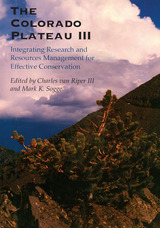 The Colorado Plateau III: Integrating Research and Resources Management for Effective Conservation
Edited by Charles van Riper III and Mark K. Sogge
University of Arizona Press, 2008 Roughly centered on the Four Corners region of the southwestern United States, the Colorado Plateau covers an area of 130,000 square miles. The relatively high semi-arid province boasts nine national parks, sixteen national monuments, many state parks, and dozens of wilderness areas. With the highest concentration of parklands in North America and unique geological and ecological features, the area is of particular interest to researchers. Derived from the Eighth Biennial Conference of Research on the Colorado Plateau, this third volume in a series of research on the Colorado Plateau expands upon the previous two books. This volume focuses on the integration of science into resource management issues, summarizes what criteria make a successful collaborative effort, outlines land management concerns about drought, provides summaries of current biological, sociological, and archaeological research, and highlights current environmental issues in the Four Corner States of Arizona, New Mexico, Colorado, and Utah. With broad coverage that touches on topics as diverse as historical aspects of pronghorn antelope movement patterns through calculating watershed prescriptions to the role of wind-blown sand in preserving archaeological sites on the Colorado River, this volume stands as a compendium of cuttingedge management-oriented research on the Colorado Plateau. The book also introduces, for the first time, tools that can be used to assist with collaboration efforts among landowners and managers who wish to work together toward preserving resources on the Colorado Plateau and offers a wealth of insights into land management questions for many readers, especially people interested in the natural history, biology, anthropology, wildlife, and cultural management issues of the region.
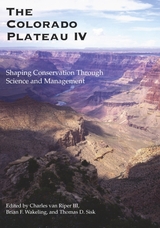 The Colorado Plateau IV: Shaping Conservation Through Science and Management
Charles van Riper
University of Arizona Press, 2010 Roughly centered on the Four Corners region of the southwestern United States, the Colorado Plateau covers some 130,000 square miles of sparsely vegetated plateaus, mesas, canyons, arches, and cliffs in Arizona, Utah, Colorado, and New Mexico. With elevations ranging from 3,000 to 14,000 feet, the natural systems found within the plateau are dramatically varied, from desert to alpine conditions.
This book focuses on the integration of science and resource management issues in this unique and highly varied environment. Broken into three subsections, this volume addresses conservation biology, biophysical resources, and inventory and monitoring concerns. The chapters range in content, addressing conservation issues—past, present, and future—on the Colorado Plateau, measurement of human impacts on resources, grazing and wildland-urban interfaces, and tools and methods for monitoring habitats and species.
An informative read for people interested in the conservation and natural history of the region, the book will also serve as a valuable reference for those people engaged in the management of cultural and biological resources of the Colorado Plateau, as well as scientists interested in methods and tools for land and resource management throughout the West.
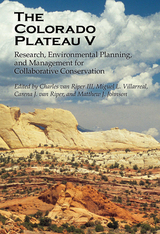 The Colorado Plateau V: Research, Environmental Planning, and Management for Collaborative Conservation
Edited by Charles van Riper III, Miguel L. Villarreal, Carena J. van Riper, and Matthew J. Johnson
University of Arizona Press, 2012 Roughly centered on the Four Corners region of the southwestern United States, the Colorado Plateau covers some 130,000 square miles of sparsely vegetated plateaus, mesas, canyons, arches, and cliffs in Arizona, Utah, Colorado, and New Mexico. With elevations ranging from 3,000 to 14,000 feet, the natural systems found within the plateau are dramatically varied, from desert to alpine conditions.
This volume, the fifth from the University of Arizona Press and the tenth overall, focuses on adaptation of resource management and conservation to climate change and water scarcity, protecting biodiversity through restructured energy policies, ensuring wildlife habitat connectivity across barriers, building effective conservation networks, and exploring new opportunities for education and leadership in conservation science.
An informative read for people interested in the conservation and natural history of the region, the book will also serve as a valuable reference for those people engaged in the management of cultural and biological resources of the Colorado Plateau, as well as scientists interested in methods and tools for land and resource management throughout the West.
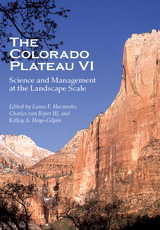 The Colorado Plateau VI: Science and Management at the Landscape Scale
Edited by Laura Foster Huenneke, Charles van Riper, and Kelley Ann Hays-Gilpin
University of Arizona Press, 2015 Covering 130,000 square miles and a wide range of elevations from desert to alpine in Arizona, Utah, Colorado, and New Mexico, the Colorado Plateau has long fascinated researchers. The Colorado Plateau VI provides readers with a plethora of updates and insights into land conservation and management questions currently surrounding the region.
The Colorado Plateau VI’s contributors show how new technologies for monitoring, spatial analysis, restoration, and collaboration improve our understanding, management, and conservation of outcomes at the appropriate landscape scale for the Colorado Plateau. The volume’s chapters fall into five major themes: monitoring as a key tool for addressing management challenges, restoration approaches to improving ecosystem condition and function, collaboration and organizational innovations to achieve conservation and management objectives, landscape-scale approaches to understanding, and managing key species and ecological communities.
Focusing on the integration of science into resource management issues over the Colorado Plateau, this volume includes contributions from dozens of leading scholars of the region. The Colorado Plateau VI proves a valuable resource to all interested in the conservation management, natural history, and cultural biological resources of the Colorado Plateau.
Colorado Profiles: Men and Women Who Shaped the Centennial State
John H. Monnett
University Press of Colorado, 1996 This popular volume presents the exciting history of Colorado through the lives of thirty-two of its most noteworthy citizens, both famous and obscure, who helped to shape Colorado as we know it today. Among those featured are: Black Kettle, David Day, Anne Bassett, Lewis Price, Casimiro Barela, Josephine Roche, Jefferson Randolph "Soapy" Smith, and Enos Mills.
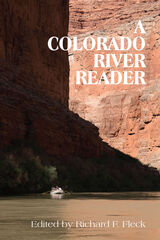 Colorado River Reader
Richard F. Fleck
University of Utah Press, 2000 "This canyon world where water yearns toward the ocean is a place so large I can’t take it in. Instead, I am taken in, traveling a near dream as we journey by water, contained by rock walls. In order to see this shorn-away world, I narrow my vision to the small and nearly secret. Never mind the stone’s illusion of permanence or the great strength of water. I look to the most fragile of things here, to the plant world of the canyon. The other river travelers seem taken in by stone, time, and water, and do not see the small things that tempt my attention, the minute fern between stones, the tiny black snails in a pond of water. I am drawn in by the growing life and not by the passing."
- from 'Plant Journey' by Linda Hogan
The mystique of the Colorado River is no less enduring and powerful than is its physical presence in the landscape of the West. Little wonder that narratives about the Colorado still arouse and intrigue readers, or that the river continues to inspire new writing among contemporary authors. What is surprising is that no anthology offering a comprehensive introduction to these works existed - until now.
A Colorado River Reader spans hundreds of years and many cultures and voices to capture an array of responses to this mighty river and tributaries. The collection opens with a Paiute creation myth set in the Grand Canyon and progresses through time, encompassing the Spanish and American exploration narratives of the eighteenth and nineteenth centuries and culminating in the adventure and nature writings of the twentieth.
This is a book that deserves a place next to every armchair and in a pocket of every backpack.
The Colorado State Capitol: History, Politics, Preservation
Derek Everett
University Press of Colorado, 2005 As the representative building of the state, the Capitol has served as a silent witness to the evolving needs and interests of all Colorado citizens. The statehouse provided a proud testament for nineteenth-century Coloradoans who wanted to prove their state's potential through grand architecture and it represents "the heart of Colorado" to this day. In one comprehensive volume historian Derek Everett traces the establishment, planning, construction, and history of Colorado's state capitol - including a discussion on the importance of restoring and preserving the building for current and future generations of Coloradoans.
Colorado: The Highest State
Thomas J. Noel
University Press of Colorado, 1995 Colorado's history, like the state itself, has had many ups and downs, booms and busts in farming and ranching, in mining and railroading, in water and oil have made Colorado's past a cycle of ups and downs as high as the state's peaks and as low as its canyons.
In each chapter of this book, you will find some questions, activities, and suggested reading to help you learn more of Colorado's story than we can present here. In these pages. you will discover a high, dry state with rugged natural beauty and an awesome history.
Colorado: The Highest State, Second Edition
Thomas J. Noel
University Press of Colorado, 2011 Chronicling the people, places, and events of the state's colorful history, Colorado: The Highest State is the story of how Colorado grew up. Through booms and busts in farming and ranching, mining and railroading, and water and oil, Colorado's past is a cycle of ups and downs as high as the state's peaks and as low as its canyons. The second edition is the result of a major revision, with updates on all material, two new chapters, and ninety new photos. Each chapter is followed by questions, suggested activities, recommended reading, a "Did you know?" trivia section, and recommended websites, movies, and other multimedia that highlight the important concepts covered and lead the reader to more information. Additionally, the book is filled with photographs, making Colorado: The Highest State a fantastic text for middle and high school Colorado history courses.
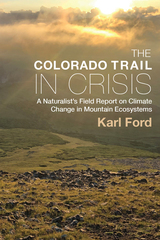 The Colorado Trail in Crisis: A Naturalist’s Field Report on Climate Change in Mountain Ecosystems
Karl Ford
University Press of Colorado, 2024 The Colorado Trail in Crisis addresses the sweeping transformation of western forests and wilderness ecosystems affected by climate change. This book is equal parts trail journal and synthesis of natural and human history. Karl Ford uses research on climate impacts to forests, wildlife, hydrology, and more to stress the urgent need for an action plan to reduce greenhouse gases and save forests and watersheds.
Using his hike along the popular five-hundred-mile Colorado Trail to present his personal observations about more than a hundred miles of dead and dying forest, Karl Ford presents a brief environmental history of these areas of the state, weaving in scientific studies about forest mortality caused by insect infestations, wildfire, drought, and loss of snowpack, and describes the poor current prospects for reforestation as the climate continues to warm. His own Lakota ancestry, as well as historical references to local Tabeguache Ute Chief Ouray and displaced Ute populations, meaningfully frames important conversations about caretaking and connection to place. Ford also proposes potential solutions to drought and forest mortality problems, as well as varying approaches and limitations to mitigation efforts.
The Colorado Trail in Crisis appeals to hikers and nature lovers seeking to learn about the natural history, beauty, and serenity of the Colorado Trail, as well as students, conservationists, and scientists researching climate change effects on Colorado mountain ecosystems.
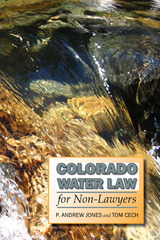 Colorado Water Law for Non-Lawyers
P. Andrew Jones
University Press of Colorado, 2009 Why do people fight about water rights? Who decides how much water can be used by a city or irrigator? Does the federal government get involved in state water issues? Why is water in Colorado so controversial? These questions, and others like them, are addressed in Colorado Water Law for Non-Lawyers. This concise and understandable treatment of the complex web of Colorado water laws is the first book of its kind. Legal issues related to water rights in Colorado first surfaced during the gold mining era in the 1800s and continue to be contentious today with the explosive population growth of the twenty-first century. Drawing on geography and history, the authors explore the flashpoints and water wars that have shaped Colorado’s present system of water allocation and management. They also address how this system, developed in the mid-1800s, is standing up to current tests—including the drought of the past decade and the competing interests for scarce water resources—and predict how it will stand up to new demands in the future. This book will appeal to at students, non-lawyers involved with water issues, and general readers interested in Colorado’s complex water rights law.
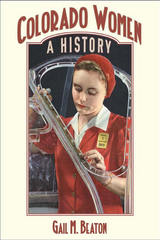 Colorado Women: A History
Gail M. Beaton
University Press of Colorado, 2012 Colorado Women is the first full-length chronicle of the lives, roles, and contributions of women in Colorado from prehistory through the modern day. A national leader in women's rights, Colorado was one of the first states to approve suffrage and the first to elect a woman to its legislature. Nevertheless, only a small fraction of the literature on Colorado history is devoted to women and, of those, most focus on well-known individuals. The experiences of Colorado women differed greatly across economic, ethnic, and racial backgrounds. Marital status, religious affiliation, and sexual orientation colored their worlds and others' perceptions and expectations of them. Each chapter addresses the everyday lives of women in a certain period, placing them in historical context, and is followed by vignettes on women's organizations and notable individuals of the time. Native American, Hispanic, African American, Asian and Anglo women's stories hail from across the state--from the Eastern Plains to the Front Range to the Western Slope--and in their telling a more complete history of Colorado emerges. Colorado Women makes a significant contribution to the discussion of women's presence in Colorado that will be of interest to historians, students, and the general reader interested in Colorado, women's and western history.
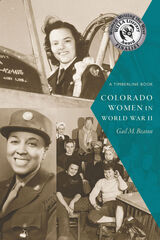 Colorado Women in World War II
Gail M. Beaton
University Press of Colorado, 2023 Four months before the attack on Pearl Harbor on December 7, 1941, Mildred McClellan Melville, a member of the Denver Woman’s Press Club, predicted that war would come for the United States and that its long arm would reach into the lives of all Americans. And reach it did. Colorado women from every corner of the state enlisted in the military, joined the workforce, and volunteered on the home front. As military women, they served as nurses and in hundreds of noncombat positions. In defense plants they riveted steel, made bullets, inspected bombs, operated cranes, and stored projectiles. They hosted USO canteens, nursed in civilian hospitals, donated blood, drove Red Cross vehicles, and led scrap drives; and they processed hundreds of thousands of forms and reports. Whether or not they worked outside the home, they wholeheartedly participated in a kaleidoscope of activities to support the war effort. In Colorado Women in World War II Gail M. Beaton interweaves nearly eighty oral histories—including interviews, historical studies, newspaper accounts, and organizational records—and historical photographs (many from the interviewees themselves) to shed light on women’s participation in the war, exploring the dangers and triumphs they felt, the nature of their work, and the lasting ways in which the war influenced their lives. Beaton offers a new perspective on World War II—views from field hospitals, small steel companies, ammunition plants, college classrooms, and sugar beet fields—giving a rare look at how the war profoundly transformed the women of this state and will be a compelling new resource for readers, scholars, and students interested in Colorado history and women’s roles in World War II.
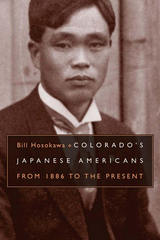 Colorado's Japanese Americans: From 1886 to the Present
Bill Hosokawa
University Press of Colorado, 2005 In Colorado's Japanese Americans, renowned journalist and author Bill Hosokawa pens the first history of this significant minority in the Centennial State. From 1886, when the young aristocrat Matsudaira Tadaatsu settled in Denver, to today, when Colorado boasts a population of more than 11,000 people of Japanese ancestry, Japanese Americans have worked to build homes, businesses, families, and friendships in the state. Hosokawa traces personal histories, such as Bob Sakata's journey from internment in a relocation camp to his founding of a prosperous truck farm; the conviction of three sisters for assisting the escape of German POWs; and the years of initiative and determination behind Toshihiro Kizaki's ownership of Sushi Den, a beloved Denver eatery. In addition to personal stories, the author also relates the larger history of the interweave of cultures in Colorado, from the founding of the Navy's Japanese language school at the University of Colorado to the merging of predominantly white and Japanese American congregations at Arvada's Simpson United Methodist Church. With the author's long view and sharp eye, Colorado's Japanese Americans creates a storied document of lasting legacy about the Issei and Nisei in Colorado.
 The Color-Blind Constitution
Andrew Kull
Harvard University Press, 1998 From 1840 to 1960 the profoundest claim of Americans who fought the institution of segregation was that the government had no business sorting citizens by the color of their skin. During these years the moral and political attractiveness of the antidiscrimination principle made it the ultimate legal objective of the American civil rights movement. Yet, in the contemporary debate over the politics and constitutional law of race, the vital theme of antidiscrimination has been largely suppressed. Thus a strong line of argument laying down one theoretical basis for the constitutional protection of civil rights has been lost.
Andrew Kull provides us with the previously unwritten history of the color-blind idea. From the arguments of Wendell Phillips and the Garrisonian abolitionists, through the framing of the Fourteenth Amendment and Justice Harlan's famous dissent in Plessy, civil rights advocates have consistently attempted to locate the antidiscrimination principle in the Constitution. The real alternative, embraced by the Supreme Court in 1896, was a constitutional guarantee of reasonable classification. The government, it said, had the power to classify persons by race so long as it acted reasonably; the judiciary would decide what was reasonable.
In our own time, in Brown v. Board of Education and the decisions that followed, the Court nearly avowed the rule of color blindness that civil rights lawyers continued to assert; instead, it veered off for political and tactical reasons, deciding racial cases without stating constitutional principle. The impoverishment of the antidiscrimination theme in the Court's decision prefigured the affirmative action shift in the civil rights agenda. The social upheaval of the 1960s put the color-blind Constitution out of reach for a quartercentury or more; but for the hard choices still to be made in racial policy, the colorblind tradition of civil rights retains both historical and practical significance.
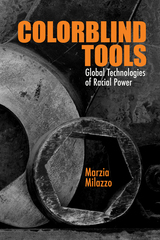 Colorblind Tools: Global Technologies of Racial Power
Marzia Milazzo
Northwestern University Press, 2023 Winner of the 2023 Association for Ethnic Studies Outstanding Book Award
A study of anti-Blackness and white supremacy across four continents demonstrates that colorblindness is neither new nor a subtype of racist ideology, but a constitutive technology of racism
In Colorblind Tools, Marzia Milazzo offers a transnational account of anti-Blackness and white supremacy that pushes against the dominant emphasis on historical change pervading current racial theory. This emphasis on change, she contends, misses critical lessons from the past.
Bringing together a capacious archive of texts on race produced in Brazil, Cuba, Mexico, Panama, the United States, and South Africa from multiple disciplines and genres, Milazzo uncovers transnational continuities in structural racism and white supremacist discourse from the inception of colonial modernity to the present. In the process, she traces the global workings of what she calls colorblind tools: technologies and strategies that at once camouflage and reproduce white domination. Whether examining Rijno van der Riet’s defense of slavery in the Cape Colony, discourses of racial mixture in Latin American eugenics and their reverberations in contemporary scholarship, the pitfalls of white “antiracism,” or Chicana indigenist aesthetics, Milazzo illustrates how white people collectively disavow racism to maintain power across national boundaries, and how anti-Black and colonial logics can be reproduced even in some decolonial literatures. Milazzo’s groundbreaking study proves that colorblindness is not new, nor is it a subtype of racist ideology or a hallmark of our era. It is a constitutive technology of racism—a tool the master cannot do without.
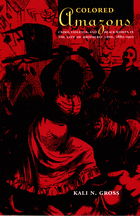 Colored Amazons: Crime, Violence, and Black Women in the City of Brotherly Love, 1880–1910
Kali N. Gross
Duke University Press, 2006 Colored Amazons is a groundbreaking historical analysis of the crimes, prosecution, and incarceration of black women in Philadelphia at the turn of the twentieth century. Kali N. Gross reconstructs black women’s crimes and their representations in popular press accounts and within the discourses of urban and penal reform. Most importantly, she considers what these crimes signified about the experiences, ambitions, and frustrations of the marginalized women who committed them. Gross argues that the perpetrators and the state jointly constructed black female crime. For some women, crime functioned as a means to attain personal and social autonomy. For the state, black female crime and its representations effectively galvanized and justified a host of urban reform initiatives that reaffirmed white, middle-class authority. Gross draws on prison records, trial transcripts, news accounts, and rare mug shot photographs. Providing an overview of Philadelphia’s black women criminals, she describes the women’s work, housing, and leisure activities and their social position in relation to the city’s native-born whites, European immigrants, and elite and middle-class African Americans. She relates how news accounts exaggerated black female crime, trading in sensationalistic portraits of threatening “colored Amazons,” and she considers criminologists’ interpretations of the women’s criminal acts, interpretations largely based on notions of hereditary criminality. Ultimately, Gross contends that the history of black female criminals is in many ways a history of the rift between the political rhetoric of democracy and the legal and social realities of those marginalized by its shortcomings.
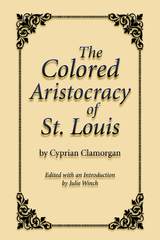 The Colored Aristocracy of St. Louis
Cyprian Clamorgan, Edited & Intro by Julie Winch
University of Missouri Press, 2018 In 1858, Cyprian Clamorgan wrote a brief but immensely readable book entitled The Colored Aristocracy of St. Louis. The grandson of a white voyageur and a mulatto woman, he was himself a member of the "colored aristocracy." In a setting where the vast majority of African Americans were slaves, and where those who were free generally lived in abject poverty, Clamorgan's "aristocrats" were exceptional people. Wealthy, educated, and articulate, these men and women occupied a "middle ground." Their material advantages removed them from the mass of African Americans, but their race barred them from membership in white society. The Colored Aristocracy of St. Louis is both a serious analysis of the social and legal disabilities under which African Americans of all classes labored and a settling of old scores. Somewhat malicious, Clamorgan enjoyed pointing out the foibles of his friends and enemies, but his book had a serious message as well. "He endeavored to convince white Americans that race was not an absolute, that the black community was not a monolith, that class, education, and especially wealth, should count for something." Despite its fascinating insights into antebellum St. Louis, Clamorgan's book has been virtually ignored since its initial publication. Using deeds, church records, court cases, and other primary sources, Winch reacquaints readers with this important book and establishes its place in the context of African American history. This annotated edition of The Colored Aristocracy of St. Louis includes an introductory essay on African Americans in St. Louis before the Civil War, as well as an account of the lives of the author and the members of his remarkable family—a family that was truly at the heart of the city's "colored aristocracy" for four generations. A witty and perceptive commentary on race and class, The Colored Aristocracy of St. Louis is a remarkable story about a largely forgotten segment of nineteenth-century society. Scholars and general readers alike will appreciate Clamorgan's insights into one of antebellum America's most important communities.
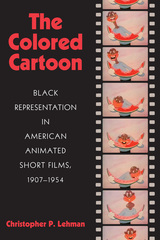 The Colored Cartoon: Black Presentation in American Animated Short Films, 1907-1954
Christopher P. Lehman
University of Massachusetts Press, 2007 From the introduction of animated film in the early 1900s to the 1950s, ethnic humor was a staple of American-made cartoons. Yet as Christopher Lehman shows in this revealing study, the depiction of African Americans in particular became so inextricably linked to the cartoon medium as to influence its evolution through those five decades. He argues that what is in many ways most distinctive about American animation reflects white animators' visual interpretations of African American cultural expression.
The first American animators drew on popular black representations, many of which were caricatures rooted in the culture of southern slavery. During the 1920s, the advent of the sound-synchronized cartoon inspired animators to blend antebellum-era black stereotypes with the modern black cultural expressions of jazz musicians and Hollywood actors. When the film industry set out to desexualize movies through the imposition of the Hays Code in the early 1930s, it regulated the portrayal of African Americans largely by segregating black characters from others, especially white females. At the same time, animators found new ways to exploit the popularity of African American culture by creating animal characters like Bugs Bunny who exhibited characteristics associated with African Americans without being identifiably black.
By the 1950s, protests from civil rights activists and the growing popularity of white cartoon characters led animators away from much of the black representation on which they had built the medium. Even so, animated films today continue to portray African American characters and culture, and not necessarily in a favorable light.
Drawing on a wide range of sources, including interviews with former animators, archived scripts for cartoons, and the films themselves, Lehman illustrates the intimate and unmistakable connection between African Americans and animation.Choice
 Colored Cosmopolitanism: The Shared Struggle for Freedom in the United States and India
Nico Slate
Harvard University Press, 2011 A hidden history connects India and the United States, the world’s two largest democracies. From the late nineteenth century through the 1960s, activists worked across borders of race and nation to push both countries toward achieving their democratic principles. At the heart of this shared struggle, African Americans and Indians forged bonds ranging from statements of sympathy to coordinated acts of solidarity. Within these two groups, certain activists developed a colored cosmopolitanism, a vision of the world that transcended traditional racial distinctions. These men and women agitated for the freedom of the “colored world,” even while challenging the meanings of both color and freedom.
“Slate exhaustively charts the liberation movements of the world’s two largest democracies from the 19th century to the 1960s. There’s more to this connection than the Rev. Martin Luther King Jr.’s debt to Mahatma Gandhi, and Slate tells this fascinating tale better than anyone ever has.”
—Tony Norman, Pittsburgh Post-Gazette
“Slate does more than provide a fresh history of the Indian anticolonial movement and the U.S. civil rights movement; his seminal contribution is his development of a nuanced conceptual framework for later historians to apply to studying other transnational social movements.”
—K. K. Hill, Choice
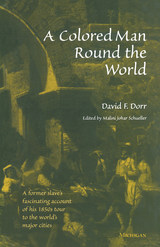 A Colored Man Round the World
David F. Dorr
University of Michigan Press, 1999 This remarkable book, written by former slave David F. Dorr, published in the mid-nineteenth century and only recently rediscovered, is an uncommon travel narrative. In the 1850s Dorr accompanied Louisiana plantation owner Cornelius Fellowes on a tour of the world's major cities, with the promise that when they returned to the United States, Dorr would be given his freedom. When that promise was broken, Dorr escaped to Ohio and wrote of his experiences in A Colored Man Round the World.
Malini Johar Schueller has edited and annotated the 1858 text and added a critical introduction that provides a useful context for understanding and appreciating this important but heretofore neglected document. Her edition of A Colored Man Round the World provides a fascinating account of Dorr's negotiation of the conflicting roles of slave versus man, taking into account all of the racial complexities that existed at the time. As a traveler abroad, Dorr claimed an American selfhood that allowed him mobility in Europe, and he benefited from the privileges accorded American "Orientalists" venturing in the near East. However, any empowerment that Dorr experienced while a tourist vanished upon his return to America.
The book will be welcomed for the rare perspective it provides of the mid-nineteenth century, through the eyes of an African-American slave and for the light it casts on world and U.S. history as well as on questions of racial and national identity.
Malini Johar Schueller is Professor of English, University of Florida.
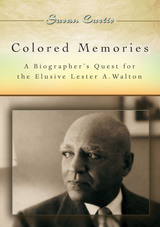 Colored Memories: A Biographer's Quest for the Elusive Lester A. Walton
Susan Curtis
University of Missouri Press, 2008 Lester A. Walton was a well-known public figure in his day. An African American journalist, cultural critic, diplomat, and political activist, he was an adviser to presidents and industrialists in a career that spanned the first six decades of the twentieth century. He was a steadfast champion of democracy and lived to see the passage of major civil rights legislation. But one word best describes Walton today: forgotten. Exploring the contours of this extraordinary life, Susan Curtis seeks to discover why our collective memory of Walton has failed. In a unique narrative of historical research, she recounts a fifteen-year journey, from the streets of Harlem and “The Ville” in St. Louis to scattered archives and obscure public records, as she uncovers the mysterious circumstances surrounding Walton’s disappearance from national consciousness. And despite numerous roadblocks and dead ends in her quest, she tells how she came to know this emblematic citizen of the American Century in surprising ways. In this unconventional book—a postmodern ghost story, an unprecedented experiment in life-writing—Curtis shares her discoveries as a researcher. Relating her frustrating search through long-overlooked documents to discover this forgotten man, she offers insight into how America’s obsession with race has made Walton’s story unwelcome. She explores the treachery, duplicity, and archival accidents that transformed a man dedicated to the fulfillment of American democracy into a shadowy figure. Combining anecdotal memories with the investigative instincts of the historian, Curtis embraces the subjectivity of her research to show that what a society forgets or suppresses is just as important as what it includes in its history. Colored Memories is a highly original work that not only introduces readers to a once-influential figure but also invites us to reconsider how we view, understand, and preserve the past.
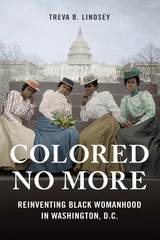 Colored No More: Reinventing Black Womanhood in Washington, D.C.
Treva B. Lindsey
University of Illinois Press, 2017 Home to established African American institutions and communities, Washington, D.C., offered women in the New Negro movement a unique setting for the fight against racial and gender oppression. Colored No More traces how African American women of the late-nineteenth and early twentieth century made significant strides toward making the nation's capital a more equal and dynamic urban center.
Treva B. Lindsey presents New Negro womanhood as a multidimensional space that included race women, blues women, mothers, white collar professionals, beauticians, fortune tellers, sex workers, same-gender couples, artists, activists, and innovators. Drawing from these differing but interconnected African American women's spaces, Lindsey excavates a multifaceted urban and cultural history of struggle toward a vision of equality that could emerge and sustain itself. Upward mobility to equal citizenship for African American women encompassed challenging racial, gender, class, and sexuality status quos. Lindsey maps the intersection of these challenges and their place at the core of New Negro womanhood.
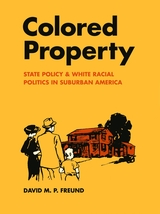 Colored Property: State Policy and White Racial Politics in Suburban America
David M. P. Freund
University of Chicago Press, 2007 Northern whites in the post–World War II era began to support the principle of civil rights, so why did many of them continue to oppose racial integration in their communities? Challenging conventional wisdom about the growth, prosperity, and racial exclusivity of American suburbs, David M. P. Freund argues that previous attempts to answer this question have overlooked a change in the racial thinking of whites and the role of suburban politics in effecting this change. In Colored Property, he shows how federal intervention spurred a dramatic shift in the language and logic of residential exclusion—away from invocations of a mythical racial hierarchy and toward talk of markets, property, and citizenship. Freund begins his exploration by tracing the emergence of a powerful public-private alliance that facilitated postwar suburban growth across the nation with federal programs that significantly favored whites. Then, showing how this national story played out in metropolitan Detroit, he visits zoning board and city council meetings, details the efforts of neighborhood “property improvement” associations, and reconstructs battles over race and housing to demonstrate how whites learned to view discrimination not as an act of racism but as a legitimate response to the needs of the market. Illuminating government’s powerful yet still-hidden role in the segregation of U.S. cities, Colored Property presents a dramatic new vision of metropolitan growth, segregation, and white identity in modern America.
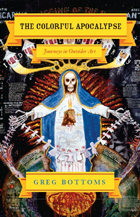 The Colorful Apocalypse: Journeys in Outsider Art
Greg Bottoms
University of Chicago Press, 2007 The Reverend Howard Finster was twenty feet tall, suspended in darkness. Or so he appeared in the documentary film that introduced a teenaged Greg Bottoms to the renowned outsider artist whose death would help inspire him, fourteen years later, to travel the country. Beginning in Georgia with a trip to Finster’s famous Paradise Gardens, his journey—of which The Colorful Apocalypse is a masterly chronicle—is an unparalleled look into the lives and visionary works of some of Finster’s contemporaries: the self-taught evangelical artists whose beliefs and oeuvres occupy the gray area between madness and Christian ecstasy.
With his prodigious gift for conversation and quietly observant storytelling, Bottoms draws us into the worlds of such figures as William Thomas Thompson, a handicapped ex-millionaire who painted a 300-foot version of the book of Revelation; Norbert Kox, an ex-member of the Outlaws biker gang who now lives as a recluse in rural Wisconsin and paints apocalyptic visual parables; and Myrtice West, who began painting to express the revelatory visions she had after her daughter was brutally murdered. These artists’ works are as wildly varied as their life stories, but without sensationalizing or patronizing them, Bottoms—one of today’s finest young writers—gets at the heart of what they have in common: the struggle to make sense, through art, of their difficult personal histories.
In doing so, he weaves a true narrative as powerful as the art of its subjects, a work that is at once an enthralling travelogue, a series of revealing biographical portraits, and a profound meditation on the chaos of despair and the ways in which creativity can help order our lives.
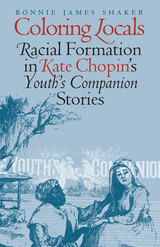 Coloring Locals: Racial Formation in Katie Chopin's "Youth's Companion" Stories
Bonnie James Shaker
University of Iowa Press, 2003 Coloring Locals examines how the late nineteenth-century politics of gender, class, race, and ethnicity influenced Kate Chopin's writing for the major family periodical of her time.
Chopin's canonical status as a feminist rebel and reformer conflicts with the fact that one of her most supportive publishers throughout her life was the Youth's Companion, a juvenile periodical whose thoroughly orthodox “family values” contributed to its success as the longest-running and, at one time, most widely circulating periodical in nineteenth-century America. Not surprisingly, Chopin’s Youth’s Companion stories differ from her canonical texts in that they embrace and advance ideals of orthodox white femininity and masculinity. Rather than viewing these two representations as being at odds with each other, Bonnie Shaker asserts that Chopin's endorsement of conventional gender norms is done in the service of a second political agenda beyond her feminism, one that can help the reader appreciate nuances of identity construction previously misunderstood or overlooked in the body of her work.
Shaker articulates this second agenda as “the discursive act of coloring locals,” the narrative construction of racial difference for Louisiana peoples of African American, Native American, and French American ancestry. For Chopin, “coloring locals” meant transforming non-Louisianans’ general understanding of the Creole and Cajun as mixed-race people into “purely” white folks, this designation of whiteness being one that conferred not only social preferment but also political protections and enfranchisement in one of the most racially violent decades of U.S. history. Thus, when Chopin is concerned with coloring her beloved Louisiana Creoles and Cajuns “white,” she strategically deploys conventional femininity for the benefits it affords as a sign of middle-class respectability and belonging. Making significant contributions both to the scholarship on Kate Chopin and on race and gender construction, this sophisticated study will be of great interest to scholars and students of nineteenth-century ethnic and cultural studies as well as Chopin scholars.
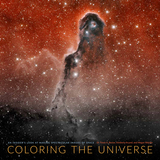 Coloring the Universe: An Insider's Look at Making Spectacular Images of Space
Travis Rector, Kimberly Arcand, and Megan Watzke
University of Alaska Press, 2015 With a fleet of telescopes in space and giant observatories on the ground, professional astronomers produce hundreds of spectacular images of space every year. These colorful pictures have become infused into popular culture and can found everywhere, from advertising to television shows to memes. But they also invite questions: Is this what outer space really looks like? Are the colors real? And how do these images get from the stars to our screens?
Coloring the Universe uses accessible language to describe how these giant telescopes work, what scientists learn with them, and how they are used to make color images. It talks about how otherwise un-seeable rays, such as radio waves, infrared light, X-rays, and gamma rays, are turned into recognizable colors. And it is filled with fantastic images taken in far-away pockets of the universe. Informative and beautiful, Coloring the Universe will give space fans of all levels an insider’s look at how scientists bring deep space into brilliant focus.
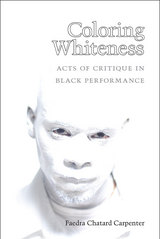 Coloring Whiteness: Acts of Critique in Black Performance
Faedra Chatard Carpenter
University of Michigan Press, 2014 Coloring Whiteness pays homage to the ways that African American artists and performers have interrogated tropes and mythologies of whiteness to reveal racial inequalities, focusing on comedy sketches, street theater, visual art, video, TV journalism, and voice-over work since 1964. By investigating enactments of whiteness—from the use of white makeup and suggestive masks, to literary motifs and cultural narratives regarding “white” characteristics and qualities—Faedra Chatard Carpenter explores how artists have challenged commonly held notions of racial identity. Through its layered study of expressive culture, her book considers how artistic and performance strategies are used to “color” whiteness and complicate blackness in our contemporary moment. Utilizing theories of performance and critical race studies, Coloring Whiteness is also propelled by Carpenter’s dramaturgical sensibilities. Her analysis of primary performance texts is informed not only by traditional print and visual materials, but also by her interviews with African American theater artists, visual artists, and cultural critics. The book is an invaluable contribution to the fields of theater and performance studies, African American studies, cultural studies, critical race studies, and American studies.
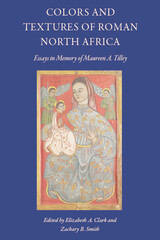 Colors and Textures of Roman North Africa: Essays in Memory of Maureen A. Tilley
Elizabeth A. Clark
Catholic University of America Press, 2023 This book serves two purposes: first, it celebrates the career of the late Maureen Tilley; second, it provides a “state of the field” look at some of the latest scholarship on Christian North Africa in late antiquity. The chapters, written by both senior scholars and the next generation of North African researchers, fills gaps in some of our understandings of the colorful people, places, and disputes that arose in the unique environment of Christian North Africa. The book centers around Augustine, Donatist studies, and North African biblical interpretation, representing Tilley’s major areas of interest, while also ensuring coverage of Tertullian (a major figure in the North African church and one of Tilley’s hobbyhorses) and the pilgrimages to North Africa and other places. It contributes to the field(s) by providing new scholarship from some of the biggest names in Christian North Africa studies (Patout Burns, Robin Jensen, Bill Tabbernee, Anthony Dupont, and Allan Fitzgerald) and in Patristic/early Christian studies writ large (Blake Leyerle and Geoffrey Dunn) while demonstrating the new trajectories of Christian North Africa research from early career (Alden Bass) and emerging (Colum Dever) scholars. The editors were Tilley’s dissertation director (the late Liz Clark) and one of her last mentees (Zach Smith), so the entire collection has a meta-view of academic genealogy – knowledge flowing from Tilley’s mentor, through colleagues and mentees, and down through and to the next generation who carry on those legacies.
 Colors Between Two Worlds: The Florentine Codex of Bernardino de Sahagún
Gerhard Wolf
Harvard University Press, 2012 For half a century the Franciscan friar Bernardino de Sahagún (1499–1590), often described as the first anthropologist of the New World, worked with his indigenous colleagues at the Collegio Imperial at Tlatelolco (now Mexico City) on an encyclopedic compendium of the beliefs, rituals, language, arts, and economy of the vanishing culture of the Aztecs. Colors Between Two Worlds examines the most richly illustrated manuscript of this great ethnographic work, the Florentine Codex, which is in the collection of the Biblioteca Medicea Laurenziana in Florence, through the issue of color.
The Codex reveals how the colors the Aztecs used in their artistic production and in everyday life, as well as the names they gave each color, illuminate their understanding of the world around them, from the weather to the curing of disease. The pigments and dyes that indigenous artists used to illustrate the Codex reflect a larger dialogue between native and European cultures, which the Florentine Codex records more fully than any surviving document from colonial New Spain.
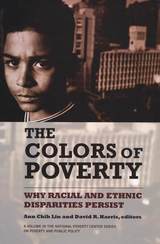 The Colors of Poverty: Why Racial and Ethnic Disparities Persist
Ann Chih Lin
Russell Sage Foundation, 2008 Given the increasing diversity of the nation—particularly with respect to its growing Hispanic and Asian populations—why does racial and ethnic difference so often lead to disadvantage? In The Colors of Poverty, a multidisciplinary group of experts provides a breakthrough analysis of the complex mechanisms that connect poverty and race. The Colors of Poverty reframes the debate over the causes of minority poverty by emphasizing the cumulative effects of disadvantage in perpetuating poverty across generations. The contributors consider a kaleidoscope of factors that contribute to widening racial gaps, including education, racial discrimination, social capital, immigration, and incarceration. Michèle Lamont and Mario Small grapple with the theoretical ambiguities of existing cultural explanations for poverty disparities. They argue that culture and structure are not competing explanations for poverty, but rather collaborate to produce disparities. Looking at how attitudes and beliefs exacerbate racial stratification, social psychologist Heather Bullock links the rise of inequality in the United States to an increase in public tolerance for disparity. She suggests that the American ethos of rugged individualism and meritocracy erodes support for antipoverty programs and reinforces the belief that people are responsible for their own poverty. Sociologists Darren Wheelock and Christopher Uggen focus on the collateral consequences of incarceration in exacerbating racial disparities and are the first to propose a link between legislation that blocks former drug felons from obtaining federal aid for higher education and the black/white educational attainment gap. Joe Soss and Sanford Schram argue that the increasingly decentralized and discretionary nature of state welfare programs allows for different treatment of racial groups, even when such policies are touted as "race-neutral." They find that states with more blacks and Hispanics on welfare rolls are consistently more likely to impose lifetime limits, caps on benefits for mothers with children, and stricter sanctions. The Colors of Poverty is a comprehensive and evocative introduction to the dynamics of race and inequality. The research in this landmark volume moves scholarship on inequality beyond a simple black-white paradigm, beyond the search for a single cause of poverty, and beyond the promise of one "magic bullet" solution. A Volume in the National Poverty Center Series on Poverty and Public Policy
 Colors of the Mind: Conjectures on Thinking in Literature
Angus Fletcher
Harvard University Press, 1991 Angus Fletcher is one of our finest theorists of the arts, the heir to I. A. Richards, Erich Auerbach, Northrop Frye. This, his grandest book since the groundbreaking Allegory of 1964, aims to open another field of study: how thought--the act, the experience of thinking--is represented in literature.
Recognizing that the field of formal philosophy is only one demonstration of the uses of thought, Fletcher looks for the ways other languages (and their framing forms) serve the purpose of certain thinking activities. What kinds of thinking accompany the writing of history? How does the gnomic sentence manage to represent some point of belief? The fresh insights Fletcher achieves at every turn suggest an anatomy of poetic and fictional strategies for representing thought--the hazards, the complications, the sufferings, the romance of thought. Fletcher's resources are large, and his step is sure. The reader samples his piercing vision of Milton's Satan, the original Thinker, leaving the pain of thinking as his legacy for mankind; Marvell's mysteriously haunting "green thought in a green shade"; Old Testament and Herodotus, Vico and Coleridge; Crane, Calvino, Stevens. Fletcher ranges over the heights of literature, poetry, music, and film, never losing sight of his central line of inquiry. He includes comments on the essential role of unclear, vague, and even irrational thinking to suggest that ideas often come alive as thoughts only in a process of considerable distress. In the end he gives us literature--not the content of thought, but its form, its shape, the fugitive colors taken on by the mind as represented in art.
 Colors of Veracity: A Quest for Truth in China and Beyond
Vera Schwarcz
University of Hawaii Press, 2014 In Colors of Veracity, Vera Schwarcz condenses four decades of teaching and scholarship about China to raise fundamental questions about the nature of truth and history. In clear and vivid prose, she addresses contemporary moral dilemmas with a highly personal sense of ethics and aesthetics.
Drawing on classical sources in Hebrew and Chinese (as well as several Greek and Japanese texts), Schwarcz brings deep and varied cultural references to bear on the question of truth and falsehood in human consciousness. An attentiveness to connotations and nuance is apparent throughout her work, which redefines both the Jewish understanding of emet (a notion of truth that encompasses authenticity) and the Chinese commitment to zhen (a vision of the real that comprises the innermost sincerity of the seeker’s heart-mind). Works of art, from contemporary calligraphy and installations to fake Chinese characters and a Jewish menorah from Roman times, shed light light on the historian’s task of giving voice to the dread-filled past. Following in the footsteps of literary scholar Geoffrey Hartman, Schwarcz expands on the “Philomela Project, which calls on historians to find new ways of conveying truth, especially when political authorities are bent on enforcing amnesia of past traumatic events.
Truth matters, even if it cannot be mapped in its totality. Veracity is shown again and again to be neither black nor white. Schwarcz’ accomplishment is a subtle depiction of “fractured luminosity,” which inspires and sustains the moral conviction of those who pursue truth against all odds.
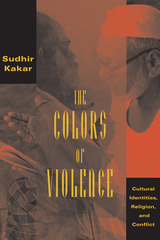 The Colors of Violence: Cultural Identities, Religion, and Conflict
Sudhir Kakar
University of Chicago Press, 1996 For decades India has been intermittently tormented by brutal outbursts of religious violence, thrusting thousands of ordinary Hindus and Muslims into bloody conflict. In this provocative work, psychoanalyst Sudhir Kakar exposes the psychological roots of Hindu-Muslim violence and examines with grace and intensity the subjective experience of religious hatred in his native land.
With honesty, insight, and unsparing self-reflection, Kakar confronts the profoundly enigmatic relations that link individual egos to cultural moralities and religious violence. His innovative psychological approach offers a framework for understanding the kind of ethnic-religious conflict that has so vexed social scientists in India and throughout the world.
Through riveting case studies, Kakar explores cultural stereotypes, religious antagonisms, ethnocentric histories, and episodic violence to trace the development of both Hindu and Muslim psyches. He argues that in early childhood the social identity of every Indian is grounded in traditional religious identifications and communalism. Together these bring about deep-set psychological anxieties and animosities toward the other. For Hindus and Muslims alike, violence becomes morally acceptable when communally and religiously sanctioned. As the changing pressures of modernization and secularism in a multicultural society grate at this entrenched communalism, and as each group vies for power, ethnic-religious conflicts ignite. The Colors of Violence speaks with eloquence and urgency to anyone concerned with the postmodern clash of religious and cultural identities.
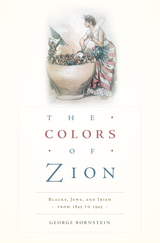 The Colors of Zion: Blacks, Jews, and Irish from 1845 to 1945
George Bornstein
Harvard University Press, 2011 A major reevaluation of relationships among Blacks, Jews, and Irish in the years between the Irish Famine and the end of World War II, The Colors of Zion argues that the cooperative efforts and sympathies among these three groups, each persecuted and subjugated in its own way, was much greater than often acknowledged today. For the Black, Jewish, and Irish writers, poets, musicians, and politicians at the center of this transatlantic study, a sense of shared wrongs inspired repeated outpourings of sympathy. If what they have to say now surprises us, it is because our current constructions of interracial and ethnic relations have overemphasized conflict and division. As George Bornstein says in his Introduction, he chooses “to let the principals speak for themselves.”
While acknowledging past conflicts and tensions, Bornstein insists on recovering the “lost connections” through which these groups frequently defined their plights as well as their aspirations. In doing so, he examines a wide range of materials, including immigration laws, lynching, hostile race theorists, Nazis and Klansmen, discriminatory university practices, and Jewish publishing houses alongside popular plays like The Melting Pot and Abie’s Irish Rose, canonical novels like Ulysses and Daniel Deronda, music from slave spirituals to jazz, poetry, and early films such as The Jazz Singer. The models of brotherhood that extended beyond ethnocentrism a century ago, the author argues, might do so once again today, if only we bear them in mind. He also urges us to move beyond arbitrary and invidious categories of race and ethnicity.
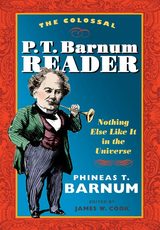 The Colossal P. T. Barnum Reader: Nothing Else Like It in the Universe
Phineas T. Barnum. Edited by James W. Cook
University of Illinois Press, 2005 The P. T. Barnum Reader reveals the trailblazing American showman P. T. Barnum as, by turns, a moral reformer, a habitual hoaxer, an insightful critic, a savvy "puffer," a master of images, a sparkling writer, a relentless provocateur, and an early advocate of "family" entertainments. Taken together, these selections paint a new and more complete portrait of this complex man than has ever been seen before.
James W. Cook's The Colossal P. T. Barnum Reader is the largest collection of Barnum's works ever produced. Included are excerpts from his pseudo-autobiographical novel The Adventures of an Adventurer (1841), his European letters from 1844-46 informing readers of the New York Atlas of his regal reception overseas, and a large selection from his Ancient and Modern Humbugs of the World, Barnum's 1864-65 insider's look into the frauds of nineteenth-century American culture. It offers a glimpse of Tom Thumb's minstrel and singing performances in front of Queen Victoria, Barnum's many fraudulent representations of the supposedly ancient Joice Heth, and a more immediate, less filtered sense of Barnum as cultural and social critic in his serialized writings and travelogues. This volume also features reproductions of difficult to find posters from Barnum's two-decade collaboration with the prominent New York lithographers, Currier and Ives, and vintage photographs.
Finally, the reader also helps us to understand Barnum's role in building the modern culture industry. We follow his career from itinerant hawker, hardly distinguishable from his pre-industrial forebears, to manager of the world's first show business empire, with a staff of thousands and brand recognition across four continents. The Colossal P. T. Barnum Reader tracks the shifting personas of the great showman, his representational choices, and his publics across the nineteenth century.
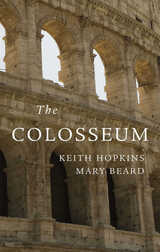 The Colosseum
Keith Hopkins and Mary Beard
Harvard University Press, 2011 Byron and Hitler were equally entranced by Rome’s most famous monument, the Colosseum. Mid-Victorians admired the hundreds of varieties of flowers in its crannies and occasionally shuddered at its reputation for contagion, danger, and sexual temptation. Today it is the highlight of a tour of Italy for more than three million visitors a year, a concert arena for the likes of Paul McCartney, and a national symbol of opposition to the death penalty. Its ancient history is chock full of romantic but erroneous myths. There is no evidence that any gladiator ever said “Hail Caesar, those about to die…” and we know of not one single Christian martyr who met his finish here.
Yet the reality is much stranger than the legend as the authors, two prominent classical historians, explain in this absorbing account. We learn the details of how the arena was built and at what cost; we are introduced to the emperors who sometimes fought in gladiatorial games staged at the Colosseum; and we take measure of the audience who reveled in, or opposed, these games. The authors also trace the strange afterlife of the monument—as fortress, shrine of martyrs, church, and glue factory. Why are we so fascinated with this arena of death?
The Colour Fantastic: Chromatic Worlds of Silent Cinema
Edited by Giovanna Fossati et al.
Amsterdam University Press, 2018 Sparked by a groundbreaking Amsterdam workshop titled "Disorderly Order: Colours in Silent Film," scholarly and archival interest in colour as a crucial aspect of film form, technology and aesthetics has enjoyed a resurgence in the past twenty years. In the spirit of the workshop, this anthology brings together international experts to explore a diverse range of themes that they hope will inspire the next twenty years of research on colour in silent film. Taking an interdisciplinary approach, the book explores archival restoration, colour film technology, colour theory, and experimental film alongside beautifully saturated images of silent cinema.
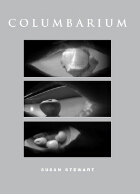 Columbarium
Susan Stewart
University of Chicago Press, 2003 Winner of the 2003 National Book Critics Circle Award in the category of poetry.
In her long-awaited fourth book of poetry, Susan Stewart gives us a series of splendid, numinous poems about truths learned with the mind but set free through the senses. Modeled on the seventeenth-century practice of century forms, or books of one hundred pages, Columbarium expresses the bond between the living and the dead in voices of parent to child, lover to beloved, and mortal to the gods. The book arrives as a meditative gift from one of our most respected poet-critics.
Stewart frames her Columbarium with four poems paying homage to the elements-to their destructive and creative aspects and to their roles in the human and more than human worlds. Both nest and crypt, the book's center holds an alphabet of "shadow georgics," poems of instruction and doubt that link knowledge and the unconscious. Questions of mortality, of goodness and suffering, and of the fragility and power of memory animate these poems. In one poem an apple calls the narrator back from the dead to savor the echoes of its varieties in myth and literature. In another, the seeds of a pear tree reveal the essential unity that makes the diversity of existence possible.
Stewart's Columbarium is both a memorial to the dead and a testament to life.
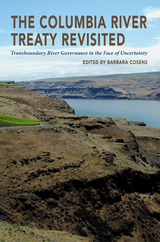 The Columbia River Treaty Revisited: Transboundary River Governance in the Face of Uncertainty
Edited by Barbara Cosens
Oregon State University Press, 2012 The Columbia River Treaty, concluded in 1961 and ratified in 1964, split hydropower and flood control regulation of the river between Canada and the United States. Some of its provisions will expire in 2024, and either country must give ten years’ notice of any desired alteration or termination.
The Columbia River Treaty Revisited, with contributions from historians, geographers, environmental scientists, and other experts, is intended to facilitate conversation about the impending expiration. It allows the reader, through the close inspection of the Columbia River Basin, to better grasp the uncertainty of water governance. It aids efforts, already underway, to understand changes in the basin since the treaty was passed, to predict future changes, and to determine whether alteration of the treaty is ultimately advisable.
The Columbia River Treaty Revisited will appeal to those interested in water basin management–scholars, stakeholders, and residents of the Columbia River basin alike.
A Project of the Universities Consoritum on Columbia River Governance
The Universities Consortium on Columbia River Governance, with representatives from universities in the U.S. and Canada, formed to offer a nonpartisan platform to facilitate an informed, inclusive, international dialogue among key decision-makers and other interested people and organizations; to connect university research to problems faced within the basin; and to expose students to a complex water resources problem. The Consortium organized the symposium on which this volume is based.
 Columbo: A Rhetoric of Inquiry with Resistant Responders
Christyne Berzsenyi
Intellect Books, 2019 An analysis of the hit television series Columbo and the investigative methods of its eponymous main character.
In the iconic detective show, which aired from 1968 to 2003, Lieutenant Columbo was known for his Socratic method of rhetorical inquiry. Feigning ignorance and employing a barrage of questions about minute details, the detective enacts a persona of “antipotency,” or counter authoritativeness, to affect the villains' underestimation of his attention to inconsistencies, abductive reasoning, and rhetorical efficacy. In his predominantly dialogue-based investigations, Columbo exhausts his suspects by asking a battery of questions concerning all minor details of the case—an aggravating, tedious provocation for the killer trying to maintain innocence.
In this engaging interdisciplinary study, Christyne Berzsenyi explores the character and his influences, dissects his methods of investigation, and assesses the show’s enduring legacy in academia and popular culture. While critical and theoretical, the text is also accessible to interdisciplinary readers, practical in application, and amusing for Columbo buffs.
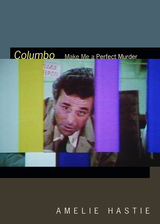 Columbo: Make Me a Perfect Murder
Amelie Hastie
Duke University Press, 2024 For decades, generations of television fans have been enraptured by Lt. Columbo, played by Peter Falk, as he unravels clues to catch killers who believe they are above the law. In her investigation of the 1970s series cocreated by Richard Levinson and William Link, Amelie Hastie explores television history through an emphasis on issues of stardom, authorship, and its interconnections with classical and New Hollywood cinema. Through close textual analysis, attentive to issues of class relations and connections to other work by Falk as well as Levinson and Link, Columbo: Make Me a Perfect Murder sees American television as an intertextual system, from its origins as a commercial broadcast medium to its iterations within contemporary streaming platforms. Ultimately, Hastie argues, in the titular detective’s constant state of learning about cultural trends and media forms, Columbo offers viewers the opportunity to learn with him and, through his tutelage, to become detectives of television itself.
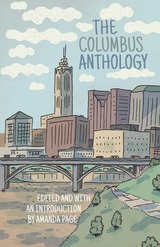 The Columbus Anthology
Amanda Page
Ohio State University Press, 2020 Columbus, Ohio, is a place whose identity centers on its supposed lack of identity—an American “every place” that has launched countless chain dining concepts. Enter the contributors to this wide-ranging volume, who are all too happy to fight back against that reputation, even as they recognize it as an inevitable facet of the ever-growing city they call home. “Maybe we’re not having trouble designing a definitive identity,” writes Amanda Page in her introduction. “Maybe we are a city that is constantly considering what it will become.” Race, sports, the endless squeeze of gentrification, the city’s booming literary and comics scenes, its reputation as a haven for queer life, the sometimes devastating differences in perspective among black and white, native and transplant residents—and more than one tribute to Buckeye Donuts—make this anthology a challenging and an energizing read. From Hanif Abdurraqib’s sparkling and urgent portrait of Columbus’s vital immigrant culture as experienced through Crew games to Nick Dekker’s insights into breakfast as a vehicle for getting to know a city to the poetry of Maggie Smith and Ruth Awad, the pieces gathered here show us a Columbus far more textured than any test marketer could dream up.
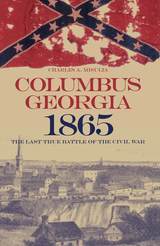 Columbus, Georgia, 1865: The Last True Battle of the Civil War
Charles A. Misulia
University of Alabama Press, 2010 A thoroughly researched account of a memorable Civil War battle
Columbus, Georgia, 1865 is a comprehensive study of the Easter Sunday, April 16, 1865, conflict, which occurred in the dark of night and extended over a mile and half through a series of forts and earthworks and was finally decided in an encounter on a bridge a thousand feet in length. This volume offers the first complete account of this battle, examining and recounting in depth not only the composition and actions of the contending forces, which numbered some three thousand men on each side, but meticulously detailing the effect of the engagement on the city of Columbus and its environs.
Misulia’s study fills in an omission in the grand account of our cataclysmic national struggle and adds a significant chapter to the history of an important regional city. In addition, Misulia takes on the long-vexing question of which encounter should be recognized as the last battle of the Civil War and argues persuasively that Columbus, Georgia, qualifies for this distinction on a number of counts.
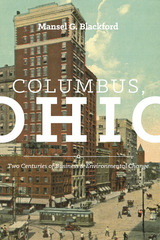 Columbus, Ohio: Two Centuries of Business and Environmental Change
Mansel G. Blackford
Ohio State University Press, 2016 Columbus, Ohio: Two Centuries of Business and Environmental Change examines how a major midwestern city developed economically, spatially, and socially, and what the environmental consequences have been, from its founding in 1812 to near the present day. The book analyzes Columbus’s evolution from an isolated frontier village to a modern metropolis, one of the few thriving cities in the Midwest. No single factor explains the history of Columbus, but the implementation of certain water-use and land-use policies, and interactions among those policies, reveal much about the success of the city.
Precisely because they lived in a midsize, midwestern city, Columbus residents could learn from the earlier experiences of their counterparts in older, larger coastal metropolises, and then go beyond them. Not having large sunk costs in pre-existing water systems, Columbus residents could, for instance, develop new, world-class, state-of-the-art methods for treating water and sewage, steps essential for urban expansion. Columbus, Ohio explores how city residents approached urban challenges—especially economic and environmental ones—and how they solved them.
Columbus, Ohio: Two Centuries of Business and Environmental Change concludes that scholars and policy makers need to pay much more attention to environmental issues in the shaping of cities, and that they need to look more closely at what midwestern metropolises accomplished, as opposed to simply examining coastal cities.
The Column of Antoninus Pius
Lise Vogel
Harvard University Press, 1973 Shortly after the death in 161 of Antoninus Pius, his sons dedicated a column to him as a funerary monument. The form of the column in general and the reliefs on the pedestal in particular raise problems central to the understanding of Roman art. In this first thorough study, illustrated with nearly 100 photographs, Lise Vogel restores the column to its rightful place as one of the major monuments of Roman art. In addition, she re-evaluates the meaning of the column of Antoninus Pius in the context of the development of second century Roman imperial sculpture.
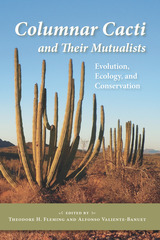 Columnar Cacti and Their Mutualists: Evolution, Ecology, and Conservation
Edited by Theodore H. Fleming and Alfonso Valiente-Banuet
University of Arizona Press, 2002 Although cacti such as the saguaro and organ pipe have come to define the Sonoran Desert for many people, they represent some 170 species of columnar cacti found in many parts of the Americas. These giant plants are so dominant in some ecosystems that many species of animals rely on them for food and shelter. They are pollinated by bats in central Mexico and Venezuela, by birds and bees in northern Mexico and Peru.
This book summarizes our current knowledge about the ecology, evolution, and conservation of columnar cacti and their vertebrate mutualists to show that the very survival of these cacti depends on animals who pollinate them and disperse their seeds. Contributors from the United States, Mexico, Venezuela, and Colombia explore aspects of geology and evolution that have forged this relationship, review findings in anatomy and physiology, and discuss recent research in population and community ecology as well as conservation issues. Ranging from the Sonoran Desert to the northern Andes, these studies reflect recent progress in understanding how abiotic and biotic factors interact to influence the evolution, distribution, and abundance of cacti and mutualists alike.
In addition, this book examines the ways in which humans, through the process of domestication, have modified these plants for economic benefit. The contributors also review phylogenetic relationships between cacti and nectar-feeding bats in an effort to understand how bat-plant interactions have influenced the evolution of diversity and ecological specialization of both. Because of the number of migratory pollinators feeding on columnar cacti, the authors make conservation recommendations aimed at preserving fully functional ecosystems in arid portions of the New World tropics and subtropics.
No other book treats the pollination ecology of cacti in such depth or offers such a wealth of up-to-date material on the nectar-feeding bats of the New World. As scientists become increasingly concerned with the need to protect biotic interactions, Columnar Cacti and Their Mutualists provides a benchmark for both conservation efforts and future research.
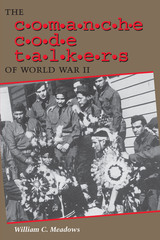 The Comanche Code Talkers of World War II
By William C. Meadows
University of Texas Press, 2003 Among the allied troops that came ashore in Normandy on D-Day, June 6, 1944, were thirteen Comanches in the 4th Infantry Division, 4th Signal Company. Under German fire they laid communications lines and began sending messages in a form never before heard in Europe—coded Comanche. For the rest of World War II, the Comanche Code Talkers played a vital role in transmitting orders and messages in a code that was never broken by the Germans. This book tells the full story of the Comanche Code Talkers for the first time. Drawing on interviews with all surviving members of the unit, their original training officer, and fellow soldiers, as well as military records and news accounts, William C. Meadows follows the group from their recruitment and training to their active duty in World War II and on through their postwar lives up to the present. He also provides the first comparison of Native American code talking programs, comparing the Comanche Code Talkers with their better-known Navajo counterparts in the Pacific and with other Native Americans who used their languages, coded or not, for secret communication. Meadows sets this history in a larger discussion of the development of Native American code talking in World Wars I and II, identifying two distinct forms of Native American code talking, examining the attitudes of the American military toward Native American code talkers, and assessing the complex cultural factors that led Comanche and other Native Americans to serve their country in this way.
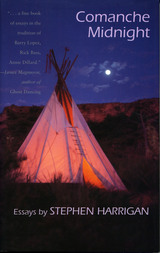 Comanche Midnight
Essays by Stephen Harrigan
University of Texas Press, 1995 Writing timeless essays that capture vanished worlds and elusive perceptions, Stephen Harrigan is emerging as a national voice with an ever-expanding circle of enthusiastic readers. For those who have already experienced the pleasures of his writing—and especially for those who haven't—Comanche Midnight collects fifteen pieces that originally appeared in the pages of Texas Monthly, Travel Holiday, and Audubon magazines.
The worlds Harrigan describes in these essays may be vanishing, but his writing invests them with an enduring reality. He ranges over topics from the past glories and modern-day travails of America's most legendary Indian tribe to the poisoning of Austin's beloved Treaty Oak, from the return-to-the-past realism of the movie set of Lonesome Dove to the intimate, off-season languor of Monte Carlo.
If the personal essay can be described as journalism about that which is timeless, then Stephen Harrigan is a reporter of people, events, and places that will be as newsworthy years from now as they are today. Read Comanche Midnight and see if you don't agree.
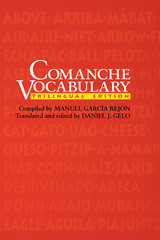 Comanche Vocabulary: Trilingual Edition
Compiled by Manuel García Rejón
University of Texas Press, 1995 The Comanche Vocabulary collected in Mexico during the years 1861-1864 by Manuel García Rejón is by far the most extensive Comanche word list compiled before the establishment of the Kiowa-Comanche-Apache Reservation in 1867. It preserves words and concepts that have since changed or even disappeared from the language, thus offering a unique historical window on earlier Comanche culture. This translation adds the English equivalents to the original Spanish-Comanche list of 857 words, as well as a Comanche-English vocabulary and comparisons with later Comanche word lists. Daniel J. Gelo's introduction discusses the circumstances in which García Rejón gathered his material and annotates significant aspects of the vocabulary in light of current knowledge of Comanche language and culture. The book also includes information on pictography, preserving a rare sample of Comanche scapula drawing. This information will help scholars understand the processes of language evolution and cultural change that occurred among all Native American peoples following European contact. The Comanche Vocabulary will also hold great interest for the large public fascinated by this once-dominant tribe.
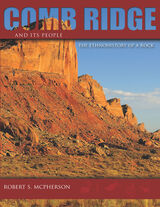 Comb Ridge and Its People: The Ethnohistory of a Rock
Robert McPherson
Utah State University Press, 2009 West of the Four Corners and east of the Colorado River, in southeastern Utah, a unique one-hundred-mile-long, two-hundred-foot-high, serrated cliff cuts the sky. Whether viewed as barrier wall or sheltering sanctuary, Comb Ridge has helped define life and culture in this region for thousands of years. Today, the area it crosses is still relatively remote, though an important part of a scenic complex of popular tourist destinations that includes Natural Bridges National Monument and Grand Gulch just to the west, Glen Canyon National Recreation Area and Lake Powell a bit farther west, Canyonlands National Park to the north, Hovenweep National Monument to the east, and the San Juan River and Monument Valley to the south. Prehistorically Comb Ridge split an intensively used Ancient Puebloan homeland. It later had similar cultural—both spiritual and practical—significance to Utes, Paiutes, and Navajos and played a crucial role in the history of European American settlement. To tell the story of this rock that is unlike any other rock in the world and the diverse people whose lives it has affected, Robert S. McPherson, author of multiple books on Navajos and on the Four Corners region, draws on the findings of a major, federally funded project to research the cultural history of Comb Ridge. He carries the story forward to contention over present and future uses of Comb Ridge and the spectacular country surrounding it. The book is the winner of the 2009 Utah Book Award for Nonfiction.
 Combat in an Age of Terror: The 7th Infantry Regiment in America's Modern Wars, Korea through Iraq
John C. Mcmanus
University of Missouri Press, 2025 The 7th Infantry Regiment’s motto, “Willing and Able,” speaks volumes about its past. Throughout America’s history the soldiers of this regiment have proven, by their sweat, their sacrifice, and their bloodshed, that they are willing and able to fight America’s wars. They have fought in more battles, in more places, than any other regiment in the United States Army. They boast more Medal of Honor winners than all but one other unit. At practically every crucial moment in America’s wars, the 7th has been there, shaping the future of the country and, by extension, the world.
In this in-depth history of the 7th, acclaimed combat historian John C. McManus takes readers from cold war campaigns through the global war on terror, chronicling the modern era of the regiment’s amazing history. Covering desperate fights for Korean hills, the struggle for control of steamy Vietnamese villages, and the lightning campaign of Desert Storm, the narrative culminates in the 7th’s toils in the Middle East. More than anything, McManus’s chronicle of the 7th portrays these unremarkable, ordinary individuals as the heart and soul of the United States Army. McManus gives a complete account of their struggles, anguish, fears, sacrifices, triumphs, and pride, providing a compelling glimpse not only of these soldiers’ journey through American history, but of the shaping of our nation as a whole.
Based on nearly a decade of research, from archives to battlefield visits to McManus’s personal interviews with countless 7th Infantry soldiers, and illustrated with maps and sixteen pages of photographs, this book is a definitive and moving story of Americans in combat.
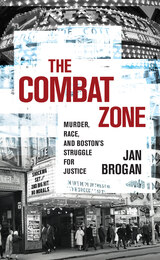 The Combat Zone: Murder, Race, and Boston's Struggle for Justice
Jan Brogan
University of Massachusetts Press, 2021 Shortlisted for the 2021 Agatha Award for Best Non-Fiction and the 2022 Anthony Award for Best Critical or Nonfiction Work
At the end of the 1976 football season, more than forty Harvard athletes went to Boston's Combat Zone to celebrate. In the city's adult entertainment district, drugs and prostitution ran rampant, violent crime was commonplace, and corrupt police turned the other way. At the end of the night, Italian American star athlete Andy Puopolo, raised in the city's North End, was murdered in a stabbing. Three African American men were accused of the crime. His murder made national news and led to the eventual demise of the city's red-light district.
Starting with this brutal murder, The Combat Zone tells the story of the Puopolo family's struggle with both a devastating loss and a criminal justice system that produced two trials with opposing verdicts, all within the context of a racially divided Boston. Brogan traces the contentious relationship between Boston’s segregated neighborhoods during the busing crisis; shines a light on a court system that allowed lawyers to strike potential jurors based purely on their racial or ethnic identity; and lays bare the deep-seated corruption within the police department and throughout the Combat Zone. What emerges is a fascinating snapshot of the city at a transitional moment in its recent past.
Combat Zoning: Military Land-Use Planning In Nevada
David Loomis
University of Nevada Press, 1993 Loomis provides a clear and disturbing picture of military land-use planning and how it has affected residents in Nevada. He contends that a lack of citizen participation in the development of land-use plans is a weakness in the planning process and that both the military and the citizenry should take an active role to avoid future conflicts.
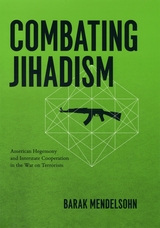 Combating Jihadism: American Hegemony and Interstate Cooperation in the War on Terrorism
Barak Mendelsohn
University of Chicago Press, 2009 Although terrorism is an age-old phenomenon, jihadi ideology is distinctive in its ambition to abandon the principle of state sovereignty, overthrow the modern state system, and replace it with an extremely radical interpretation of an Islamic world order. These characteristics reflect a radical break from traditional objectives promoted by terrorist groups. In Combating Jihadism Barak Mendelsohn argues that the distinctiveness of the al-Qaeda threat led the international community to change its approach to counterterrorism. Contrary to common yet erroneous conceptions, the United States, in its role as a hegemon, was critical for the formulation of a multilateral response. While most analyses of hegemony have focused on power, Mendelsohn firmly grounds the phenomenon in a web of shared norms and rules relating to the hegemon’s freedom of action. Consequently, he explains why US leadership in counterterrorism efforts was in some spheres successful, when in others it failed or did not even seek to establish multilateral collaborative frameworks. Tracing the ways in which international cooperation has stopped terrorist efforts, Combating Jihadism provides a nuanced, innovative, and timely reinterpretation of the war on terrorism and the role of the United States in leading the fight against al-Qaeda and its affiliates.
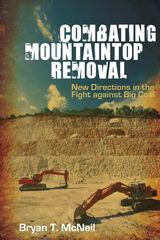 Combating Mountaintop Removal: New Directions in the Fight against Big Coal
Bryan T. McNeil
University of Illinois Press, 2012 Drawing on powerful personal testimonies of the hazards of mountaintop removal in southern West Virginia, Combating Mountaintop Removal critically examines the fierce conflicts over this violent and increasingly prevalent form of strip mining. Bryan T. McNeil documents the changing relationships among the coal industry, communities, environment, and economy from the perspective of local grassroots activist organizations and their broader networks. Focusing on Coal River Mountain Watch (CRMW), an organization composed of individuals who have personal ties to the coal industry in the region, the study reveals a turn away from once-strong traditional labor unions and the emergence of community-based activist organizations. By framing social and moral arguments in terms of the environment, these innovative hybrid movements take advantage of environmentalism's higher profile in contemporary politics. In investigating the local effects of globalization and global economics, McNeil tracks the profound reimagining of social and personal ideas such as identity, history, and landscape and considers their roles in organizing an agenda for progressive community activism.
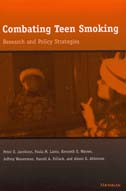 Combating Teen Smoking: Research and Policy Strategies
Peter D. Jacobson, Paula M. Lantz, Kenneth E. Warner, Jeffrey Wasserman, Harold A. Pollack, and Alexis K. Ahlstrom
University of Michigan Press, 2001 Every year, more than 400,000 Americans die prematurely because of tobacco use. Most began smoking during their teen years. Adolescent tobacco use remains our nation's most preventable threat to life and health. This public health crisis has generated widespread debate over how best to prevent young people from initiating smoking or using other tobacco products. Combating Teen Smoking is an invaluable guide for policymakers and communities on the front lines of this prevention effort.
Synthesizing recent research regarding the prevention and control of adolescent smoking, this book offers the reader a convenient compendium of what is known about adolescents and tobacco use; it also highlights areas where additional research is needed. Based on their assessment of the considerable amount of information presented, the authors recommend various ways to help slow--or even reverse--the recent rise in teenage smoking. A comprehensive antitobacco program might include, for example, antismoking media campaigns based on social marketing strategies, clean indoor air laws, and the increase of cigarette prices.
Combating Teen Smoking will appeal to a broad spectrum of readers concerned about the problem of adolescent tobacco use, including policymakers who are actively seeking ways to help reduce teen smoking.
Peter D. Jacobson is Associate Professor, University of Michigan School of Public Health. Paula Lantz is Assistant Professor, University of Michigan School of Public Health. Kenneth Warner is Richard D. Remington Collegiate Professor of Public Health and Director, University of Michigan Tobacco Research Network. Jeffrey Wasserman is Consultant, the RAND Corporation and Senior Project Director, The MEDSTAT Group. Harold Pollack is Assistant Professor, University of Michigan School of Public Health. Alexis Ahlstrom is Research Associate, University of Michigan School of Public Health.
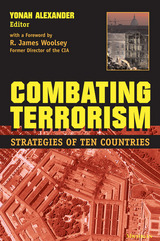 Combating Terrorism: Strategies of Ten Countries
Yonah Alexander, Editor
University of Michigan Press, 2002 The tragic events of September 11, 2001, and the consequent "war on terrorism" have made the question of effective counterterrorism policy a growing public concern. The original essays in Combating Terrorism offer a unique overview and evaluation of the counterterrorism policies of ten countries: the United States, Argentina, Peru, Colombia, the United Kingdom, Spain, Israel, Turkey, India, and Japan. Postscripts for each of the country chapters provide post-September 11 assessments of current counterterrorism practices. Most of the contributors to this volume have served in official governmental capacities and many continue to serve as consultants to governmental policy and decision makers.
All of the essays address the same set of questions to allow for cross-national comparison of strategies and an assessment of counterterrorism practices:
What is the governmental and public perception of the sources of terrorism? How successful have the policies of governments been in combating both domestic and international terrorism? What factors influence a government's willingness and ability to cooperate with other countries in combating terrorism? To what degree are the terrorist realities and the concerns of governments interconnected with global terrorism? To what degree are certain countries "natural hosts" of either terrorist groups or propensities that target Western or closely allied interests? To what degree are terrorist organizations mainly concerned about winning political participation in their target countries? Which counterterrorism strategies work, and which do not? What are the lessons of past experiences for future counterterrorism responses at the national, regional, and global levels?
The conclusion to the volume summarizes the lessons that may be learned from the experiences of the ten countries and discusses a list of best practices in counterterrorism.
This book will be of interest to policymakers, scholars, and other individuals with professional responsibilities in the area of terrorism and security studies. Written in clear, accessible prose, this book will also appeal to the general reader who is interested in gaining insight into the array of issues facing governments that endeavor to combat terrorism, and into the possible solutions to one of the foremost threats to world peace in our time.
Yonah Alexander is Professor and Director, Inter-University Center for Terrorism Studies; Senior Fellow and Director, International Center for Terrorism Studies, Potomac Institute for Policy Studies; and Co-Director, Inter-University Center for Legal Studies, International Law Institute.
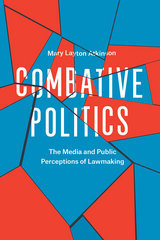 Combative Politics: The Media and Public Perceptions of Lawmaking
Mary Layton Atkinson
University of Chicago Press, 2017 From the Affordable Care Act to No Child Left Behind, politicians often face a puzzling problem: although most Americans support the aims and key provisions of these policies, they oppose the bills themselves. How can this be? Why does the American public so often reject policies that seem to offer them exactly what they want?
By the time a bill is pushed through Congress or ultimately defeated, we’ve often been exposed to weeks, months—even years—of media coverage that underscores the unpopular process of policymaking, and Mary Layton Atkinson argues that this leads us to reject the bill itself. Contrary to many Americans’ understandings of the policymaking process, the best answer to a complex problem is rarely self-evident, and politicians must weigh many potential options, each with merits and drawbacks. As the public awaits a resolution, the news media tend to focus not on the substance of the debate but on descriptions of partisan combat. This coverage leads the public to believe everyone in Washington has lost sight of the problem altogether and is merely pursuing policies designed for individual political gain. Politicians in turn exacerbate the problem when they focus their objections to proposed policies on the lawmaking process, claiming, for example, that a bill is being pushed through Congress with maneuvers designed to limit minority party input. These negative portrayals become linked in many people’s minds with the policy itself, leading to backlash against bills that may otherwise be seen as widely beneficial. Atkinson argues that journalists and educators can make changes to help inoculate Americans against the idea that debate always signifies dysfunction in the government. Journalists should strive to better connect information about policy provisions to the problems they are designed to ameliorate. Educators should stress that although debate sometimes serves political interests, it also offers citizens a window onto the lawmaking process that can help them evaluate the work their government is doing.
Combined Arms Warfare in Israeli Military History: From the War of Independence to Operation Protective Edge
David Rodman
Sussex Academic Press, 2022 Combined arms warfare (CAW)—the integration of different arms on the battlefield (e.g., armor, infantry, artillery, aircraft, and engineers—is as old as war itself. This book traces the Israeli experience with CAW from the country's War of Independence in 1947-49 through Operation Protective Edge in 2014. It describes and analyzes the IDF's practice of CAW in each conflict that Israel has fought since the country's establishment.
Combined Arms Warfare in Israeli Military History: From the War of Independence to Operation Protective Edge
David Rodman
Sussex Academic Press, 2022 Combined arms warfare (CAW)—the integration of different arms on the battlefield (e.g., armor, infantry, artillery, aircraft, and engineers—is as old as war itself. This book traces the Israeli experience with CAW from the country's War of Independence in 1947-49 through Operation Protective Edge in 2014. It describes and analyzes the IDF's practice of CAW in each conflict that Israel has fought since the country's establishment.
The Combing of History
David William Cohen
University of Chicago Press, 1994 How is historical knowledge produced? And how do silence and forgetting figure in the knowledge we call history? Taking us through time and across the globe, David William Cohen's exploration of these questions exposes the circumstantial nature of history. His investigation uncovers the conventions and paradigms that govern historical knowledge and historical texts and reveals the economic, social, and political forces at play in the production of history.
Drawing from a wide range of examples, including African legal proceedings, German and American museum exhibits, Native American commemorations, public and academic debates, and scholarly research, David William Cohen explores the "walls and passageways" between academic and non-academic productions of history.
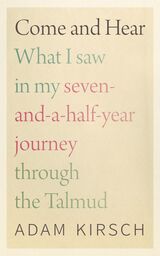 Come and Hear: What I Saw in My Seven-and-a-Half-Year Journey through the Talmud
Adam Kirsch
Brandeis University Press, 2021 A literary critic’s journey through the Talmud.
Spurred by a curiosity about Daf Yomi—a study program launched in the 1920s in which Jews around the world read one page of the Talmud every day for 2,711 days, or about seven and a half years—Adam Kirsch approached Tablet magazine to write a weekly column about his own Daf Yomi experience. An avowedly secular Jew, Kirsch did not have a religious source for his interest in the Talmud; rather, as a student of Jewish literature and history, he came to realize that he couldn’t fully explore these subjects without some knowledge of the Talmud. This book is perfect for readers who are in a similar position. Most people have little sense of what the Talmud actually is—how the text moves, its preoccupations and insights, and its moments of strangeness and profundity. As a critic and journalist Kirsch has experience in exploring difficult texts, discussing what he finds there, and why it matters. His exploration into the Talmud is best described as a kind of travel writing—a report on what he saw during his seven-and-a-half-year journey through the Talmud. For readers who want to travel that same path, there is no better guide.
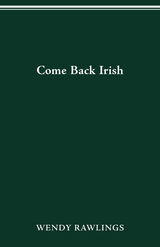 COME BACK IRISH
Wendy Rawlings
Ohio State University Press, 2001 Nine inhabitants of a sleepy Irish seaside town tell what they know about a visitor from out of town who is rumored to be both attractive and dangerous. A young mother in an affluent Long Island community finds herself strangely drawn to the woman she has hired as her housekeeper. After her small business venture fails, a woman is forced to move back in with her parents and discovers they aren't the couple she thought they were at all. In fourteen expertly crafted stories, Wendy Rawlings chronicles with comic sympathy what happens when American women and Irish men, parents and children, employers and employees, hurtle toward each other and crash headlong into cultural or generational roadblocks. Like the American in the title story, who can imagine only a "litter of claddagh rings and Erin go bragh, the high-stepping of Riverdance on videocassette" until she gets on a plane and goes to Ireland, Rawlings's fiction entreats us to toss out the picture-perfect images we have of American consumer culture, Irish tourist towns, and the institution of marriage and enter the world of her fictions—more contradictory, troubling, and true.
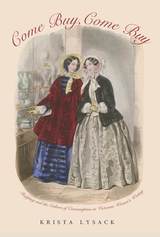 Come Buy, Come Buy: Shopping and the Culture of Consumption in Victorian Women’s Writing
Krista Lysack
Ohio University Press, 2008 From the 1860s through the early twentieth century, Great Britain saw the rise of the department store and the institutionalization of a gendered sphere of consumption. Come Buy, Come Buy considers representations of the female shopper in British women’s writing and demonstrates how women’s shopping practices are materialized as forms of narrative, poetic, and cultural inscription, showing how women writers emphasize consumerism as productive of pleasure rather than the condition of seduction or loss. Krista Lysack examines works by Christina Rossetti, Mary Elizabeth Braddon, George Eliot, and Michael Field, as well as the suffragette newspaper Votes for Women, in order to challenge the dominant construction of Victorian femininity as characterized by self-renunciation and the regulation of appetite. Come Buy, Come Buy considers not only literary works, but also a variety of archival sources (shopping guides, women’s fashion magazines, household management guides, newspapers, and advertisements) and cultural practices (department store shopping, shoplifting and kleptomania, domestic economy, and suffragette shopkeeping). With this wealth of sources, Lysack traces a genealogy of the woman shopper from dissident domestic spender to aesthetic connoisseur, from curious shop-gazer to political radical.
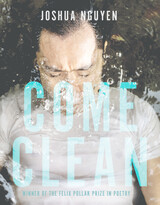 Come Clean
Joshua Nguyen
University of Wisconsin Press, 2021 Joshua Nguyen's sharp, songlike, and often experimental collection compartmentalizes past trauma—sexual and generational—through the quotidian. Poems aim to confront the speaker's past by physically, and mentally, cleaning up. Here, the Asian-American masculine interrogates the domestic space through the sensual and finds healing through family and in everyday rhythms: rinsing rice until the water runs clear, folding clean shirts, and attempts at re-creating an unwritten family recipe. Yet past wounds remain present like permanent marker under layers of paint or spilled fish sauce set into car upholstery. Infused with the Shinto-inspired organizing practices of KonMari and the catchy nihilism of Mitski's songs, the poems in Come Clean unpack, organize, and tidy up life's messy joys and hurtful chaos with intimacy, grace, and vulnerability.
No matter how smattered my insides,
I am relieved that I left my room tidy—
One less ugly sight.
I always wanted to die clean & pretty
while my dreams made music in the night. —Excerpt from "Last Words"
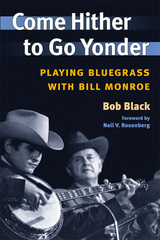 Come Hither to Go Yonder: Playing Bluegrass with Bill Monroe
Bob Black
University of Illinois Press, 2005 Bob Black was a member of Bill Monroe's Blue Grass Boys in the 1970s. Black's memoir of his time with the man he called the Chief offers the unique vantage point of a man who traveled and performed extensively with the Father of Bluegrass at a time when the music had opened up to new audiences--and Monroe had become a living legend. Both role model and taskmaster, Monroe exerted a profound influence on Black and the musicians who have carried on the bluegrass tradition. In addition to Black's one-of-a-kind story, Come Hither to Go Yonder includes complete listing of Black's appearances with Monroe, recollections of the memorable experiences they shared while working together, descriptions of other important musicians and bands, and suggestions for further reading and listening. Offering a rare perspective on the creative forces that drove one of America's greatest composers and musical innovators, Come Hither to Go Yonder rewards fans of Bill Monroe and bluegrass while offering an insider's view of a crucial time in the music's history.
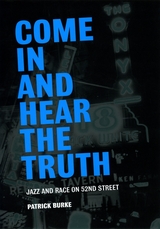 Come In and Hear the Truth: Jazz and Race on 52nd Street
Patrick Burke
University of Chicago Press, 2008 Between the mid-1930s and the late ’40s, the center of the jazz world was a two-block stretch of 52nd Street in Manhattan. Dozens of crowded basement clubs between Fifth and Seventh avenues played host to legends such as Billie Holiday and Charlie Parker, as well as to innumerable professional musicians whose names aren’t quite so well known. Together, these musicians and their audiences defied the traditional border between serious art and commercial entertainment—and between the races, as 52nd Street was home to some of the first nightclubs in New York to allow racially integrated bands and audiences. Patrick Burke argues that the jazz played on 52nd Street complicated simplistic distinctions between musical styles such as Dixieland, swing, and bebop. And since these styles were defined along racial lines, the music was itself a powerful challenge to racist ideology.
Come In and Hear the Truth uses a range of materials, from classic photographs to original interviews with musicians, to bring the street’s vibrant history to life and to shed new light on the interracial contacts and collaborations it generated.
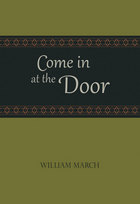 Come in at the Door
William March
University of Alabama Press, 1934 William March's debut novel, Company K, introduced him to the reading public as a gifted writer of modern fiction. Of that World War I classic, Graham Greene wrote: “It is the only war book I have read which has found a new form to fit the novelty of the protest. The prose is bare, lucid, without literary echoes.” After Company K, March brought his same unerring style to a cycle of novels and short stories—his “Pearl County” series—inspired in part by his childhood in the vicinity of Mobile, Alabama.
Come in at the Door is the first in March’s “Pearl County” collection, and it tells the story of Chester, a boy who lives with his withholding, widowed father, and Mitty, who keeps house and serves as a surrogate wife to Chester’s father and a mother to Chester. One morning before dawn, Mitty takes Chester to the Athlestan courthouse to watch the hanging of a man who’d killed “a grotesque, dwarflike creature” he thought had “laid a conjure” on him.
Throughout Chester’s rambunctious young manhood, the gruesome memory hovers just below the surface of his mind, recalled in detail only at his father’s death, when the book sweeps forward to its shattering denouement. A classic of Southern Gothic that illuminates family, class, race, and gender, Come in at the Door marks the homecoming of a Southern storyteller at the peak of his craft.
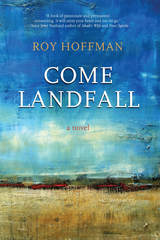 Come Landfall: A Novel
Roy Hoffman
University of Alabama Press, 2014 The worlds of three women and the men they love come together in this novel of war and hurricanes, loss and renewal. Christiane, or Nana, reliving the past in her eighties, her granddaughter Angela, working at a Biloxi casino in her twenties, and their teenage friend Cam, the daughter of a Vietnamese shrimper, form a deep connection. As they face heartbreak, their bonds nurture and sustain them. Ordinary people impacted by the shifts of history—Come Landfall is a southern story with a global sensibility.
The Gulf Coast serves as more than just a setting—it is a character unto itself. With casinos lining one side of the highway, antebellum homes along the other, and a Vietnamese neighborhood up the road, here the old South collides with the new. From households along this stretch of US 90, lineages and emotional connections stretch all over the world.
Inspired by true events, Roy Hoffman’s novel has its seeds in the saga of his uncle, Maj. Roy Robinton, US Marine Corps, a WWII prisoner of war in the Philippines who disappeared as captive on a Japanese “hellship.” His young bride, back home, was ground down, waiting.
Christiane returns in her mind to the man she married at twenty-one—Rosey, a flyer with the Army Air Corps who was in the Philippines at the outbreak of WWII. Angela meets Frank, an airman at Keesler Air Force base who is proudly patriotic, deeply religious, and a student of weather. Cam falls in love with Joe, a Biloxi cop, and her own tumultuous story begins to interweave with that of Angela’s and Nana’s. What’s taken from Nana, Angela, and Cam (and so many others when storms make their landfall), what’s given back, and what’s kept forever sit at the heart of this
intimate yet expansive novel.
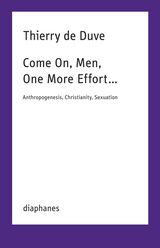 Come On, Men, One More Effort …: Anthropogenesis, Christianity, Sexuation
Thierry De Duve
Diaphanes, 2024 A theoretical exploration of possible ways out of concepts adopted by the Enlightenment.
Thierry de Duve outlines the main features of a critical theory of male, all-too-male sexuation and cross-gender emancipation, drawing on Marcel Gauchet’s theses on Christianity as an exit from religion, Jacques Lacan’s algebra of desire, and Geneviève Morel’s analysis of the “law of the mother.”
Wouldn’t it have required more than the translation of the three Christian maxims “faith, hope, love” into the revolutionary maxims “liberté, egalité, fraternité?” Is there more to the knot of incarnation, fatherhood, and the cult of Mary than just Christian mysticism? Can the uncertainty of fatherhood become an act of faith that acknowledges a fundamental uncertainty?
Come On, Men, One More Effort… explores ways out of the dead end of political concepts adopted by the Enlightenment and their continued impact today, since the only possibility seems to be to embrace the religious and reject it at the same time.
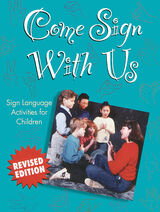 Come Sign With Us: Sign Language Activities for Children
Jan Hafer
Gallaudet University Press, 1990 A Newbridge Book Club Selection
"Discusses creative uses of signing to help children share what they have learned."
--Library Talk
Come Sign With Us Book
Now, the new, completely revised Come Sign With Us offers more follow-up activities, including many in context, to teach children sign language. The second edition of this fun, fully illustrated activities manual features more than 300 line drawings of both adults and children signing familiar words, phrases, and sentences using American Sign Language (ASL) signs in English word order. Twenty lively lessons each introduce ten selected "Target Vocabulary" words in a format familiar and exciting to children, including holidays, pets, cars and trucks, and more. All signs have equivalent words listed in both English and Spanish.
Come Sign With Us shows how to form each sign exactly, and also presents the origins of ASL, interesting facts about deafness, and how people live in the Deaf community. Used with reading and grammar studies, the sign language learned from this book can help children improve their vocabulary retention and reading comprehension.
ISBN 1-56368-051-3, 8 ½ x 11 softcover, 160 pages, line drawings, glossary
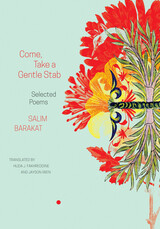 Come, Take a Gentle Stab: Selected Poems
Salim Barakat
Seagull Books, 2021 Introduces renowned Kurdish-Syrian writer Salim Barkat to an English audience for the first time, with translated selections from his most acclaimed works of poetry.
Although Salim Barakat is one of the most renowned and respected contemporary writers in Arabic letters, he remains virtually unknown in the English-speaking world. This first collection of his poetry in English, representing every stage of his career, remedies that startling omission. Come, Take a Gentle Stab features selections from his most acclaimed works of poetry, including excerpts from his book-length poems, rendered into an English that captures the exultation of language for which he is famous.
A Kurdish-Syrian man, Barakat chose to write in Arabic, the language of cultural and political hegemony that has marginalized his people. Like Paul Celan, he mastered the language of the oppressor to such an extent that the course of the language itself has been compelled to bend to his will. Barakat pushes Arabic to a point just beyond its linguistic limits, stretching those limits. He resists coherence, but never destroys it, pulling back before the final blow. What results is a figurative abstraction of struggle, as alive as the struggle itself. And always beneath the surface of this roiling water one can glimpse the deep currents of ancient Kurdish culture.
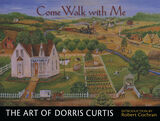 Come Walk with Me: The Art of Dorris Curtis
Dorris Curtis
University of Arkansas Press, 2004 Come Walk with Me: The Art of Dorris Curtis has enormous appeal both as a memoir and as a collection of wonderful paintings. Dorris Curtis, like Grandma Moses, began painting at a late age. She worked as a school teacher for over forty years and upon retirement at the age of sixty-five, began to study art. Curtis looked up to Grandma Moses and was heavily influenced by her achievements. This book includes 103 images of Curtis’s artwork, each with an extended caption, as well as an introduction by Robert Cochran which places Curtis’s art into the larger context of both Arkansas art and American folk art as a whole. Dorris Curtis began painting at the age of sixty-five. Since her start in 1973, Curtis’s work has been exhibited in Chicago and Washington, D.C., and she has appeared as a guest on the PBS series American Art Forum. Curtis recently donated her entire collection to the University of Central Arkansas.
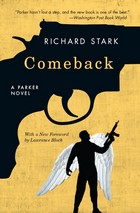 Comeback: A Parker Novel
Richard Stark
University of Chicago Press, 2011 An action-packed crime novel starring Parker, the heister starring in the forthcoming Shane Black film Play Dirty!
Richard Stark's Parker novels are the hardest of hard-boiled, classic crime novels where the heists are huge, the body counts are high, and the bad guys usually win.
The Parker novels have been a huge influence on countless writers and filmmakers, including Quentin Tarantino, Stephen King, George Pelecanos, Colson Whitehead, Lucy Sante, John Banville, and many more. Their stripped-down language and hard-as-nails amorality create an unforgettable world where the next score could be the big one, but your next mistake could also be your last. There's nothing else like them.
After the bloodbath of Butcher’s Moon, the action-filled blowout Parker adventure, Donald Westlake said, "Richard Stark proved to me that he had a life of his own by simply disappearing. He was gone." And for nearly twenty-five years, he stayed away, while readers waited.
But nothing bad is truly gone forever, and Parker’s as bad as they come. According to Westlake, one day in 1997, “suddenly, he came back from the dead, with a chalky prison pallor”—and the resulting novel, Comeback, showed that neither Stark nor Parker had lost a single step. Knocking over a highly lucrative religious revival show, Parker reminds us that not all criminals don ski masks—some prefer to hide behind the wings of fallen angels.
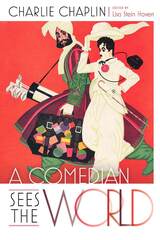 A Comedian Sees the World
Charlie Chaplin, Edited by Lisa Stein Haven
University of Missouri Press, 2014 Film star Charlie Chaplin spent February 1931 through June 1932 touring Europe, during which time he wrote a travel memoir entitled “A Comedian Sees the World.” This memoir was published as a set of five articles in Women’s Home Companion from September 1933 to January 1934 but until now had never been published as a book in the U.S. In presenting the first edition of Chaplin’s full memoir, Lisa Stein Haven provides her own introduction and notes to supplement Chaplin’s writing and enhance the narrative. Haven’s research revealed that “A Comedian Sees the World” may very well have been Chaplin’s first published composition, and that it was definitely the beginning of his writing career. It also marked a transition into becoming more vocally political for Chaplin, as his subsequent writings and films started to take on more noticeably political stances following his European tour. During his tour, Chaplin spent time with numerous politicians, celebrities, and world leaders, ranging from Winston Churchill and Mahatma Gandhi to Albert Einstein and many others, all of whom inspired his next feature films, Modern Times (1936), The Great Dictator (1940), Monsieur Verdoux (1947), and A King in New York (1957). His excellent depiction of his experiences, coupled with Haven’s added insights, makes for a brilliant account of Chaplin’s travels and shows another side to the man whom most know only from his roles on the silver screen. Historians, travelers, and those with any bit of curiosity about one of America’s most beloved celebrities will all want to have A Comedian Sees the World in their collections.
Available only in the USA and Canada.
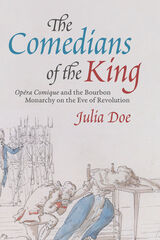 The Comedians of the King: "Opéra Comique" and the Bourbon Monarchy on the Eve of Revolution
Julia Doe
University of Chicago Press, 2021 Lyric theater in ancien régime France was an eminently political art, tied to the demands of court spectacle. This was true not only of tragic opera (tragédie lyrique) but also its comic counterpart, opéra comique, a form tracing its roots to the seasonal trade fairs of Paris. While historians have long privileged the genre’s popular origins, opéra comique was brought under the protection of the French crown in 1762, thus consolidating a new venue where national music might be debated and defined.
In The Comedians of the King, Julia Doe traces the impact of Bourbon patronage on the development of opéra comique in the turbulent prerevolutionary years. Drawing on both musical and archival evidence, the book presents the history of this understudied genre and unpacks the material structures that supported its rapid evolution at the royally sponsored Comédie-Italienne. Doe demonstrates how comic theater was exploited in, and worked against, the monarchy’s carefully cultivated public image—a negotiation that became especially fraught after the accession of the music-loving queen, Marie Antoinette. The Comedians of the King examines the aesthetic and political tensions that arose when a genre with popular foundations was folded into the Bourbon propaganda machine, and when a group of actors trained at the Parisian fairs became official representatives of the sovereign, or comédiens ordinaires du roi.
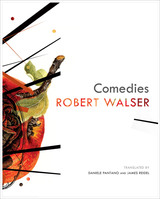 Comedies
Robert Walser
Seagull Books, 2018 This book brings English-language readers works by Walser in a rare form: dramolette.
Few writers have ever experienced such a steady rise in their reputation and public profile as Swiss writer Robert Walser (1878–1956) has seen in recent years. As more of his previously little-known work has been translated into English, readers have discovered a unique writer whose off-kilter sensibility and innovations in form are perfectly suited to our fragmented, distracted, bewildering era.
The short plays presented here, inspired by the German theater Walser enjoyed in his youth, while never meant to be performed, present scenes, characters, and situations that comment on the brutality of fairy tales, the impossibilities of love, the dark fate of the Christ child (and Walser himself), and more. At the same time, like all of Walser’s work they are shot through with a humor that is wholly genuine despite its shades of darkness. Gathering all of Walser’s plays, as well as his later, fragmentary dramatic writings, Comedies will be celebrated by the many devoted fans of this lately rediscovered master.
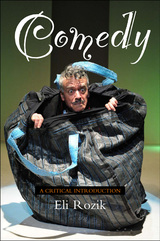 Comedy: A Critical Introduction
Eli Rozik
Sussex Academic Press, 2022 This book is an original approach to the study of comedy. While assimilating theoretical insights from Aristotle to the present day, the book contests, inter alia, the theory of comedy's ritual origin. It challenges the age-old and continuing attempts to determine the structure of action that characterizes comedy, suggesting instead that structures of action are shared by all genres, and that it is the specific mood that accounts for their differences. Mood is a prism through which a playwright wishes the spectator to perceive a fictional world. Comedy is characterized by its lighthearted mood, which generates a specific kind of laughter. If mood determines the genre of a fictional world - in contrast to current theory - comedy, satiric drama, and grotesque drama are different genres promoting different moods and aiming at different effects. Each genre should thus be read and experienced according to its inherent rules and not in terms of a theory that lumps these genres together. Comedy: A Critical Introduction discusses the pivotal role of commedia dell'arte in both reflecting comedy's classical tradition and influencing subsequent developments, especially in comedy's style of acting. It explores the relations between comedy and carnival and between comedy and joke-telling. It also probes the view that comedy is characterized by a unique vision and examines comedy in different media, such as cinema, comics, puppet theatre, radio drama, and TV drama. The book questions the traditional semiotic view that all meaning is in the text and suggests that, in generating comedic meaning, the spectator's contribution/reaction is no less vital than that of the text itself. Major contributions to a general theory of comedy - and to a sound methodology for the analysis of comedies - are presented. Ample references to comedies and/or pertinent analyses of such comedies - written over the course of 2,500 years of theatre recorded history - are provided, enabling readers to grasp ideas in their original terminology and logic. Each presentation is accompanied by critical comments which both introduce the problems involved and suggest possible solutions.
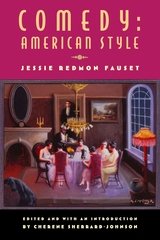 Comedy: American Style: Jessie Redmon Fauset
Sherrard-Johnson, Cherene
Rutgers University Press, 2009 Comedy: American Style, Jessie Redmon Fauset's fourth and final novel, recounts the tragic tale of a family's destructionùthe story of a mother who denies her clan its heritage. Originally published in 1933, this intense narrative stands the test of time and continues to raise compelling, disturbing, and still contemporary themes of color prejudice and racial self-hatred. Several of today's bestselling novelists echo subject matter first visited in Fauset's commanding work, which overflows with rich, vivid, and complex characters who explore questions of color, passing, and black identity. Cherene Sherrard-Johnson's introduction places this literary classic in both the new modernist and transatlantic contexts and will be embraced by those interested in earlytwentieth-century women writers, novels about passing, the Harlem Renaissance, the black/white divide, and diaspora studies. Selected essays and poems penned by Fauset are also included, among them "Yarrow Revisited" and "Oriflamme," which help highlight the full canon of her extraordinary contribution to literature and provide contextual background to the novel.
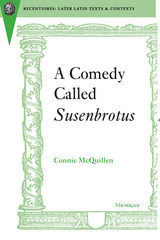 A Comedy Called Susenbrotus
Connie McQuillen
University of Michigan Press, 1998 The comedy Susenbrotus is a neo-Latin play, written by the students of Trinity College Cambridge and performed before King James I at Royston in March 1615/16. It has never before been edited or translated. This edition contains the Latin text (prepared from a collation of the two extant manuscript copies), an English translation with annotations to classical and contemporary allusions, and an introduction tracing the development of humanist Latin drama in the universities during the Elizabethan and Jacobean periods.
Susenbrotus is in many ways representative of later university comedy. It is a rowdy, bawdy farce with roots in the Roman comedies of Plautus and Terence. The wit and much of the humor in these plays is in the reworking of traditional themes with characters and situations adapted to contemporary types and topical satire. Almost every playwright for the professional stage (with the notable exception of Shakespeare) either wrote or acted in university plays. Moreover, they were popular forms of entertainment and were attended not only by members of the academic community but also by visiting dignitaries, courtiers, foreign ambassadors, and on occasion, the English monarchs.
Susenbrotus is special among later university plays because it was specifically written for King James I. It was meant to flatter the king, who prided himself on his humanist education, with a display of wit and erudition. It was also meant to entertain: the play itself is quite funny. It involves the antics of several contemporary types (the pedant, a poet, a Spanish dandy, and a braggart soldier) vying for the affection of a cross-dressed boy. Much of the wit in Susenbrotus is verbal: scholarly puns, sexual metaphors, classical allusions, and quotations that are explained in annotations. The sustained transvestitism of the character Fortunia distinguishes it from its classical sources as well as from other plays of its type. Unlike Latin texts that were submitted to publishing houses and therefore corrected or stylized by printers, Susenbrotus is an example of Latin as it was written in the seventeenth century.
Connie McQuillen is Associate Professor of Humanities, Southwest State University, Minnesota.
Comedy Is A Man In Trouble: Slapstick In American Movies
Alan Dale
University of Minnesota Press, 2002 An enthusiast’s look at the art of physical comedy—now in paperback! Legendary screen comedian Jerry Lewis once said, "The premise of all comedy is a man in trouble." The films that endeared Lewis and others to us hinged on the physical assault of their hero, the pie in the face or slip on the banana peel that reduced the movie star to the level of the audience. Alan Dale presents a lively and accessible look at slapstick, a form of comedy with roots in the circus and vaudeville that has been refashioned by actors ranging from Buster Keaton to the Marx Brothers, from Katharine Hepburn to Jim Carrey. Winner of the Theater Library Association’s Special Jury Prize for Distinguished Achievement
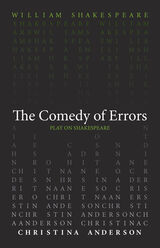 The Comedy of Errors
William Shakespeare
Arizona Center for Medieval and Renaissance Studies, 2022 Shakespeare’s archetypal slapstick comedy, now with updated jokes and wordplay.
One of Shakespeare’s earliest plays, The Comedy of Errors is a farcical tale of separated twins and mistaken identities. This slapstick play is a staple of the genre, including madcap bawdiness, love at first sight, reunions, and happily-ever-afters. Christina Anderson’s translation dives deep into the joy of the original text, reinterpreting the metaphor, antiquated slang, and double and triple entendre for a contemporary audience.
This translation of The Comedy of Errors was written as part of the Oregon Shakespeare Festival’s Play On! project, which commissioned new translations of thirty-nine Shakespeare plays. These translations present work from “The Bard” in language accessible to modern audiences while never losing the beauty of Shakespeare’s verse. Enlisting the talents of a diverse group of contemporary playwrights, screenwriters, and dramaturges from diverse backgrounds, this project reenvisions Shakespeare for the twenty-first century. These volumes make these works available for the first time in print—a new First Folio for a new era.
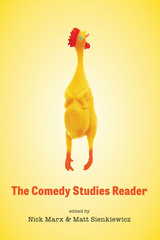 The Comedy Studies Reader
Edited by Nick Marx and Matt Sienkiewicz
University of Texas Press, 2018 From classical Hollywood film comedies to sitcoms, recent political satire, and the developing world of online comedy culture, comedy has been a mainstay of the American media landscape for decades. Recognizing that scholars and students need an authoritative collection of comedy studies that gathers both foundational and cutting-edge work, Nick Marx and Matt Sienkiewicz have assembled The Comedy Studies Reader. This anthology brings together classic articles, more recent works, and original essays that consider a variety of themes and approaches for studying comedic media—the carnivalesque, comedy mechanics and absurdity, psychoanalysis, irony, genre, race and ethnicity, gender and sexuality, and nation and globalization. The authors range from iconic theorists, such as Mikhail Bakhtin, Sigmund Freud, and Linda Hutcheon, to the leading senior and emerging scholars of today. As a whole, the volume traces two parallel trends in the evolution of the field—first, comedy’s development into myriad subgenres, formats, and discourses, a tendency that has led many popular commentators to characterize the present as a “comedy zeitgeist”; and second, comedy studies’ new focus on the ways in which comedy increasingly circulates in “serious” discursive realms, including politics, economics, race, gender, and cultural power.
Comets
Laurel L. Wilkening
University of Arizona Press, 1982 Over forty authorities present sections on the nucleus, dust, coma, and tails of comets, along with sections on their origin, and relationships to other solar system bodies. . . . An excellent book.—Space News
"The volume is highly recommended to all interested in comets and the Solar System."—Journal of the British Astronomical Association
"A good representation of the studies that are currently being done on comets, and it is an extremely good source of information on a wide variety of topics."—International Comet Quarterly
"Extremely well-written and informative. . . . A must for library collections."—The Observatory
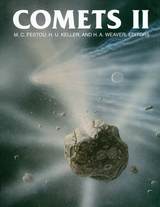 Comets II
Edited by M. C. Festou, H. U. Keller, and H. A. Weaver
University of Arizona Press, 2004 The study of comets is a field that has seen tremendous advances in recent years, far surpassing the knowledge reflected in the original Comets volume published as part of the Space Science Series in 1982. This new volume, with more than seventy contributing authors, represents the first complete overview of comet science in more than a decade and contains the most extensive collection of knowledge yet assembled in the field. Comets II situates comet science in the global context of astrophysics for the first time by beginning with a series of chapters that describe the connection between stars and planets. It continues with a presentation of the formation and evolution of planetary systems, enabling the reader to clearly see the key role played in our own solar system by the icy planetesimals that were the seeds of the giant planets and transneptunian objects. The book presents the key results obtained during the 1990s, in particular those collected during the apparition of the exceptional comets C/Hyakutake and C/Hale-Bopp in 1996-1997. The latest results obtained from the in situ exploration of comets P/Borrelly and P/Wild 2 are also discussed in detail. Each topic of is designed to be accessible to students or young researchers looking for basic, yet detailed, complete and accurate, information on comet science. With its emphasis on the origin of theories and the future of research, Comets II will enable scientists to make connections across disciplinary boundaries and will set the stage for discovery and new understanding in the coming years.
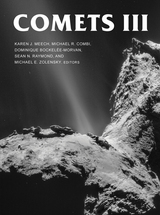 Comets III
Karen J. Meech, Michael R. Combi, Dominique Bockelée-Morvan, Sean N. Raymond, and Michael E. Zolensky
University of Arizona Press, 2024 Comets III brings a comprehensive update to the latest breakthroughs in comet science over the last twenty years and showcases how recent space missions and advancements in telescopic observations have revolutionized our understanding of these celestial bodies.
With the contributions of more than eighty authors spanning twenty-five chapters, Comets III investigates the early solar system origins of comets and the clues provided by the composition and distribution of their present population for their long-term dynamical evolution and interrelations with other members of the solar system. Organized thematically, each section is designed to enable connections across disciplinary boundaries in both planetary science and planetary formation astrophysics.
This comprehensive volume explores recent advancements in space missions, telescopic observations, and robotic surveys, providing new understandings of the origins and dynamics of comets. Intended for both researchers and students, Comets III offers insights into unresolved questions and sets the stage for future advancements.
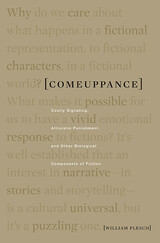 Comeuppance: Costly Signaling, Altruistic Punishment, and Other Biological Components of Fiction
William Flesch
Harvard University Press, 2009 With Comeuppance, William Flesch delivers the freshest, most generous thinking about the novel since Walter Benjamin wrote on the storyteller and Wayne C. Booth on the rhetoric of fiction. In clear and engaging prose, Flesch integrates evolutionary psychology into literary studies, creating a new theory of fiction in which form and content flawlessly intermesh.
Fiction, Flesch contends, gives us our most powerful way of making sense of the social world. Comeuppance begins with an exploration of the appeal of gossip and ends with an account of how we can think about characters and care about them as much as about persons we know to be real. We praise a storyteller who contrives a happy or at least an appropriate ending, and fault the writer who refuses us one. Flesch uses Darwinian theory to show how fiction satisfies our desire to see the good vindicated and the wicked get their comeuppance. He conveys the danger and excitement of reading fiction with nimble intelligence and provides wide reference to stories both familiar and little known.
Flesch has given us a book that is sure to claim a central place in the discussion of literature and the humanities.
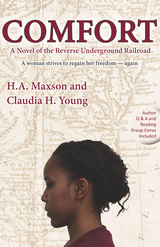 Comfort: A Novel of the Reverse Underground Railroad
H.A. Maxson and Claudia H. Young
Parkhurst Brothers, Inc., 2014 The year 1816 in Delaware and surrounding states was known as “the year without a summer” due to debris from the eruption of Mt. Tambora that tainted most of the Northern hemisphere with chill and darkness. This time of chill and darkness provides the setting for this ambitious tale of people divided by the institution of slavery, ignorance, greed and social isolation and the triumph of a few people of character over impossible odds. Historians H.A. Maxson and Claudia H. Young bring alive this little known time and place in America. Their collaboration results in a memorable tale of loyalty and betrayal, compassion and cruelty, and of dauntless courage and creativity. Comfort is a talented young seamstress who has worked to buy her freedom from slavery from her benevolent owner, an Irish immigrant and former indentured servant. Her husband Cuff is an unwise, irresponsible and weak man who sells his wife to pay his gambling debt. When Comfort falls into the hands of the reprehensible dealer of human flesh Joe Johnson, she is sold south to Virginia, to a cruel master and poor manager. Comfort’s stalwart friend Esther, is a slave whose skin is pale enough for her to pass as white. Esther possesses an extensive knowledge of “Roots”, the native art of using plants for therapeutic and not-so-therapeutic purposes. Esther pairs with Pompey, a mute freed slave who is clever and resourceful, to escape her sadistic owner, travel south to find Comfort and help her find her way back to freedom and her baby girl. Comfort tells the story of how shared morality and character can lead to unlikely partnerships in intrepid heroism. This extraordinary work by veteran authors sets a new standard for interpretation of the reverse underground railroad.
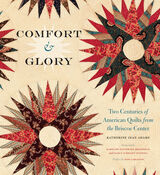 Comfort and Glory: Two Centuries of American Quilts from the Briscoe Center
By Katherine Jean Adams
University of Texas Press, 2016 Quilts bear witness to the American experience. With a history that spans the early republic to the present day, this form of textile art can illuminate many areas of American life, such as immigration and settlement, the development of our nation’s textile industry, and the growth of mass media and marketing. In short, each quilt tells a story that is integral to America’s history. Comfort and Glory introduces an outstanding collection of American quilts and quilt history documentation, the Winedale Quilt Collection at the Briscoe Center for American History at the University of Texas at Austin. This volume showcases 115 quilts—nearly one-quarter of the Winedale Collection—through stunning color photographs (including details) and essays about each quilt’s history and construction. The selections span more than two hundred years of American quiltmaking and represent a broad range of traditional styles and functions. Utility quilts, some worn or faded, join show quilts, needlework masterpieces, and “best” quilts saved for special occasions. Texas quilts, including those made in or brought to Texas during the nineteenth century, constitute a significant number of the selections. Color photographs of related documents and material culture objects from the Briscoe Center’s collections—quilting templates, a painted bride’s box, sheet music, a homespun dress, a brass sewing bird, and political ephemera, among them—enrich the stories of many of the quilts.
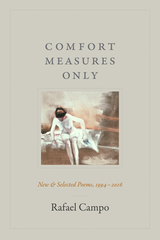 Comfort Measures Only: New and Selected Poems, 1994–2016
Rafael Campo
Duke University Press, 2018 In Comfort Measures Only, Rafael Campo bears witness to the unspeakable beauty bound up with human suffering. Gathered from his over twenty-year career as a poet-physician, these eighty-nine poems—thirty-one of which have never been previously published in a collection—pull back the curtain in the ER, laying bare our pain and joining us all in spellbinding moments of pathos. The poet, who is also truly a healer, revives language itself—its sounds channeled through our hearts and lungs, its rhythms amplified through the stethoscope—to make meaning of our bewilderment when our bodies so eloquently and yet wordlessly fail us. Campo’s transcendent poems, in all their modernity amidst the bleep of heart monitors and the wail of ambulance sirens, remind us of what the ancients understood: that poetry sustains us, and whether we live or die, through what we can imagine and create in our shared voices we may yet achieve immortality.
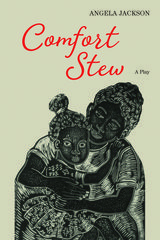 Comfort Stew: A Play
Angela Jackson
Northwestern University Press, 2019 What could be more painful than a missing child? And how might the community better support families—especially young, single mothers and their children? In Comfort Stew, acclaimed Chicago poet and playwright Angela Jackson addresses these questions in what she has called “a meditation on motherhood and what it means to love. It is a call to community to renew its vows to the ancestors and to children so that no child is ever truly lost.”
Hillary Robinson Clay, a self-reliant schoolteacher, is the first to notice when four-year-old Enjoli is absent from her preschool class. Guided by the memory of her mother and with support from Jake, a tough man who is capable of tenderness, Hillary parents her teenage daughter, Sojourner, who is the same age as Enjoli’s mother, Patrice. Jake is a storyteller and a “good cop” who follows Hillary’s intuition and goes looking for Enjoli.
As their stories weave together, Jackson explores parenting, generational conflict, and tradition in the context of contemporary African American family life. Maternal wisdom is embodied by succeeding generations of black women in the recipe for an African stew, a dish Hillary learns to honor while adding a spice that makes it her own.
 Comfort Women: Colonialism, War, and Sex, Volume 5
Chungmoo Choi, ed.
Duke University Press This special issue explores the devastated terrain where the peculiar form of East Asian colonial modernity and militarism intersects with gender and sexuality. The contributors suggest that in building the modern nation-state, through the inversion of public and domestic space, Japan created a state-administered system of licensed prostitution within itself and its colonies. The “Comfort Women” system that drafted over 200,000 Asian women into sexual slavery for the Japanese military during the Pacific War, is a testimony of the racial and gender contradictions of the Japanese Empire. While the essays in the issue attempt to untangle this grotesque history—repressed and misrepresented in the name of nationalism in both Japan and its former colonies—they also question the nationalistic inclination of the movement that aims to reaudit this history. Extending its interrogation to the Cold War power dynamics and contingent economic development that have contributed to the silencing of the colonial past in East Asia, these essays also examine “the Tokyo Trials” and the discourses of postwar compensation and apology. They not only reveal the capitalistic incentives behind the nominalism of compensation but also unmask the Janus face of humanism, which claims to be universal while excluding Asian women from the category of humanity. This exceptional collection includes artwork by two Korean comfort women, Tok-kyong Kang and Sun-dok Kim, as well as pieces by Japanese artists and Korean American artists. Other features include a narrative composed of several interviews with comfort women and a conversation between the Nobel laureate Kenzaburo Oe of Japan and South Korean dissident poet Chi-ha Kim. Contributors. Chungmoo Choi, Chin Sung Chung, Norma Field, Yuki Fujime, Tok-kyong Kang, Chi-ha Kim, Hyun Sook Kim, Daisil Kim-Gibson, Jin Kyung Lee, Sasha Y. Lee, Yong Soon Min, Kenzaburo Oe, Kerry Ross, Yoshiko Shimada, Youn Ok Song, Won Soon Park, Kyung sik Suh, Taeko Tomiyama, Melissa Wender, Hyanah Yang
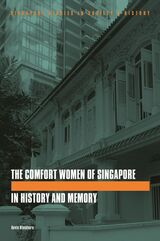 The Comfort Women of Singapore in History and Memory
Kevin Blackburn
National University of Singapore Press, 2022 A balanced, sensitive study of the history of comfort women in Singapore during World War II.
“Comfort women” or ianfu is the euphemism used by the Japanese military for the women they compelled to do sex work in the Second World War, and has become the term generally used in English to discuss the subject. The role of comfort women in the Japanese empire during World War II remains an important and emotional topic around the world. Most scholarship concentrates on Korean comfort women, with less on their counterparts in Japan, China, and Taiwan, and even less on Southeast Asia. That gap persists despite widespread knowledge of the elaborate series of comfort stations, or comfort houses, that were organized by the Japanese administration across Singapore during the Occupation from 1942 to 1945. So why, the author asks, did no former comfort women from Singapore come forward and tell their stories when others across Asia began to do publicly in the 1990s?
To understand this silence, this book offers a detailed examination of the sex industry serving the Japanese military during the wartime occupation of Singapore: the comfort stations, managers, procuresses, girls, and women who either volunteered or were forced into service and in many cases sexual slavery. Kevin Blackburn then turns from history to the public presence of the comfort women in Singapore’s memory, including newspapers, novels, plays, television, and touristic heritage sites, showing how comfort women became known in Singapore during the 1990s and 2000s. Bringing great care, balance, and sensitivity to a difficult subject, Blackburn helps to fill an important gap in our understanding of this period.
 The Comfort Women: Sexual Violence and Postcolonial Memory in Korea and Japan
C. Sarah Soh
University of Chicago Press, 2008 A powerful debunking of simplistic views of a wartime tragedy
In an era marked by atrocities perpetrated on a grand scale, the tragedy of the so-called comfort women—mostly Korean women forced into prostitution by the Japanese army—endures as one of the darkest events of World War II. These women have usually been labeled victims of a war crime, a simplistic view that makes it easy to pin blame on the policies of imperial Japan and therefore easier to consign the episode to a war-torn past. In this revelatory study, C. Sarah Soh provocatively disputes this master narrative.
Soh reveals that the forces of Japanese colonialism and Korean patriarchy together shaped the fate of Korean comfort women—a double bind made strikingly apparent in the cases of women cast into sexual slavery after fleeing abuse at home. Other victims were press-ganged into prostitution, sometimes with the help of Korean procurers. Drawing on historical research and interviews with survivors, Soh tells the stories of these women from girlhood through their subjugation and beyond to their efforts to overcome the traumas of their past. Finally, Soh examines the array of factors— from South Korean nationalist politics to the aims of the international women’s human rights movement—that have contributed to the incomplete view of the tragedy that still dominates today.
 Comfortable Everyday Life at the Swedish Eighteenth-Century Näs Manor
Carolina Brown
Amsterdam University Press, 2024 During the eighteenth century, comfortable everyday life becomes a new ideal. The good life was no longer about grand representation or the manifestation of material opulence. The new luxury was instead the comfortably arranged life at home. This book is about the traces of this change, its approach and consequences and its anchoring in the material and social life of the Swedish manor. The comfort revolution of the eighteenth century was clearly associated with both new types of furniture and new ways of furnishing. An important aspect of the development of comfort was the new mobility and flexibility in form and function that the home and its interior now showed. Through the home of the Wadenstierna family on the country estate of Näs, north of Stockholm, the comfortable everyday life is set by their various tables – at writing desks, sewing tables, dressing tables, coffee tables and games tables.
The Comforts of Home: Prostitution in Colonial Nairobi
Luise White
University of Chicago Press, 1990 "This history is . . . the first fully-fleshed story of African Nairobi in all of its complexity which foregrounds African experiences. Given the overwhelming white dominance in the written sources, it is a remarkable achievement."—Claire Robertson, International Journal of African Historical Studies
"White's book . . . takes a unique approach to a largely unexplored aspect of African History. It enhances our understanding of African social history, political economy, and gender studies. It is a book that deserves to be widely read."—Elizabeth Schmidt, American Historical Review
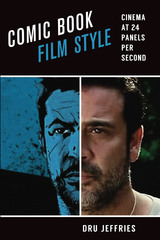 Comic Book Film Style: Cinema at 24 Panels per Second
By Dru Jeffries
University of Texas Press, 2017 Superhero films and comic book adaptations dominate contemporary Hollywood filmmaking, and it is not just the storylines of these blockbuster spectacles that have been influenced by comics. The comic book medium itself has profoundly influenced how movies look and sound today, as well as how viewers approach them as texts. Comic Book Film Style explores how the unique conventions and formal structure of comic books have had a profound impact on film aesthetics, so that the different representational abilities of comics and film are put on simultaneous display in a cinematic work. With close readings of films including Batman: The Movie, American Splendor, Superman, Hulk, Spider-Man 2, V for Vendetta, 300, Scott Pilgrim vs. the World, Watchmen, The Losers, and Creepshow, Dru Jeffries offers a new and more cogent definition of the comic book film as a stylistic approach rather than a genre, repositioning the study of comic book films from adaptation and genre studies to formal/stylistic analysis. He discusses how comic book films appropriate comics’ drawn imagery, vandalize the fourth wall with the use of graphic text, dissect the film frame into discrete panels, and treat time as a flexible construct rather than a fixed flow, among other things. This cinematic remediation of comic books’ formal structure and unique visual conventions, Jeffries asserts, fundamentally challenges the classical continuity paradigm and its contemporary variants, placing the comic book film at the forefront of stylistic experimentation in post-classical Hollywood.
Comic Book Movies
Davis, Blair
Rutgers University Press, 2018 Comic Book Movies explores how this genre serves as a source for modern-day myths, sometimes even incorporating ancient mythic figures like Thor and Wonder Woman’s Amazons, while engaging with the questions that haunt a post-9/11 world: How do we define heroism and morality today? How far are we willing to go when fighting terror? How can we resist a dystopian state?
Film scholar Blair Davis also considers how the genre’s visual style is equally important as its weighty themes, and he details how advances in digital effects have allowed filmmakers to incorporate elements of comic book art in innovative ways. As he reveals, comic book movies have inspired just as many innovations to Hollywood’s business model, with film franchises and transmedia storytelling helping to ensure that the genre will continue its reign over popular culture for years to come.
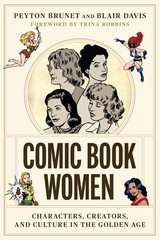 Comic Book Women: Characters, Creators, and Culture in the Golden Age
By Peyton Brunet and Blair Davis; foreword by Trina Robbins
University of Texas Press, 2022 2023 Ray and Pat Browne Best Single Work by One or More Authors in Popular and American Culture, Popular and American Culture Association (PACA) / Popular Culture Association (PCA)
2023 Ray and Pat Browne Best Edited Reference/Primary Source Work in Popular Culture Award (Honorable Mention), Popular and American Culture Association (PACA) / Popular Culture Association (PCA)
2023 Peter C. Rollins Book Award, Southwest Texas Popular Culture and American Culture Associations (SWPACA)
A revisionist history of women's pivotal roles as creators of and characters in comic books.
The history of comics has centered almost exclusively on men. Comics historians largely describe the medium as one built by men telling tales about male protagonists, neglecting the many ways in which women fought for legitimacy on the page and in publishers’ studios. Despite this male-dominated focus, women played vital roles in the early history of comics. The story of how comic books were born and how they evolved changes dramatically when women like June Tarpé Mills and Lily Renée are placed at the center rather than at the margins of this history, and when characters such as the Black Cat, Patsy Walker, and Señorita Rio are analyzed. Comic Book Women offers a feminist history of the golden age of comics, revising our understanding of how numerous genres emerged and upending narratives of how male auteurs built their careers. Considering issues of race, gender, and sexuality, the authors examine crime, horror, jungle, romance, science fiction, superhero, and Western comics to unpack the cultural and industrial consequences of how women were represented across a wide range of titles by publishers like DC, Timely, Fiction House, and others. This revisionist history reclaims the forgotten work done by women in the comics industry and reinserts female creators and characters into the canon of comics history.
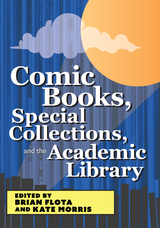 Comic Books, Special Collections, and the Academic Library
Brian Flota
Association of College & Research Libraries, 2023 Comic book properties continue to dominate popular culture, and there has been continued growth in the academic field of Comics Studies. Graphic novels and comic trade paperbacks populate the shelves of many academic libraries. Single issue collections of “floppy” comic books, however, tend to find their home in special collections libraries because their flimsy construction, highly acidic paper, and, occasionally, the scarcity of certain specific issues warrants special storage and handling. Thoughtful consideration must go into any decision to begin or sustain these collections. Comic Books, Special Collections, and the Academic Library collects best practices for the acquisition, preservation, storage, and cataloging of comics, particularly single-issue (or floppy) comics, within the special collections units of academic library collections. Four sections answer: - Why Should Your Institution Collect Comics?
- Your Library Collects or Wants to Collect Comics. Now What?
- How Do You Engage in Library Instruction and Outreach with Your Comics Collection?
- How Can Comics Be Used as Primary and Secondary Source Material by Students and Faculty?
Chapters address challenges specific to comic book collections in academic libraries, such as finding space and funds to build a collection, making diverse and inclusive collections, leading innovative library instruction sessions with comics, and working with undergraduate and graduate students on comics research. Comic Books, Special Collections, and the Academic Library can help you develop, cultivate, grow, catalog, and make use of comic book collections.
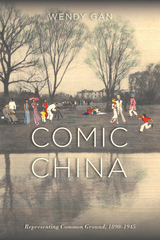 Comic China: Representing Common Ground, 1890-1945
Wendy Gan
Temple University Press, 2018 Wendy Gan’s Comic China investigates the circumstances and motivations of cross-cultural humor. How do works that trade in laughter shape our understanding of Western discourses about China? Is humor meant to be inclusive or exclusive? Does it protect or challenge the status quo? Gan suggests that the simple, straightforward laugh may actually be a far more intricate negotiation of power relations. Gan unpacks texts by authors who had little real contact with China as well as writers whose proximity to China influenced their representations. Looking beyond the familiar canon of serious modernist texts and the Yellow Peril classics of popular fiction, Gan analyzes turn-of-the-twentieth-century musical comedies set in the Far East, Ernest Bramah’s chinoiserie-inspired tales, and interwar travel writing. She also considers the comic works of the missionary Arthur Henderson Smith, the former Maritime Customs Officer J.O.P. Bland, and the Shanghai journalist and advertising man Carl Crow. Though it includes humor that is less than complimentary to the Chinese, Comic China reminds us that laughter is tied to our common humanity. Gan navigates the humor used in comic depictions ultimately to find, not superiority or ridicule, but common ground.
Comic Crime
Edited by Earl F. Bargainnier
University of Wisconsin Press, 1987 The humor of Sherlock Holmes, Donald Westlake, Agatha Christie, Michael Innes, and Edmund Crispin are just a few of those discussed. A major point highlighted by this book is simply that wit, slapstick. laughter, and an anything-can-happen motif appear in a significant amount of fiction about crime.
Comic Faith: The Great Tradition from Austen to Joyce
Robert M. Polhemus
University of Chicago Press, 1980 "Polhemus sketches several distinctions between nineteenth- and twentieth-century novelists and concludes that what most characterizes the nineteenth century, from the perspective of the twentieth, is the tendency in its comic fiction to criticize and to undermine the dogma and institutions of religion and to put faith instead of the existence of the comic perspective. Comic Faith is a virtuoso performance of impressive stature; I suspect the book will be influential for many years to come."—John Halperin, Modern Fiction Studies
 Comic Fascism: Ideology, Catholicism, and Americanism in Italian Children’s Periodicals
Zane Elward
Ohio State University Press, 2025 Comics in Italy—produced by Fascists, conservatives, Catholics, and, after World War II, youth groups on the political left—promoted competing yet sometimes convergent visions for Italian society to children in the first half of the twentieth century. In Comic Fascism, Zane Elward dives deep into the archives to reveal how Italian comics reflected transformations within Italian society during Fascist rule (1922–45) and how conservative and Catholic circles were entangled with Mussolini’s agenda, normalizing and promoting it through their own periodicals. At the same time, he offers new interpretations of American comics, demonstrating that despite Italian suspicion of US culture, these comics often aligned with Fascism and were co-opted by its proponents. Elward also identifies the persistence of Fascist political ideas after the fall of the Fascist state and highlights growing tensions between the right and the left in the lead-up to the Cold War. Ultimately, Elward broadens previous temporal and cultural frames to offer fresh insights into the origins and long tail of Fascist indoctrination and how it remained at the heart of the ongoing quest to redefine Italian society.
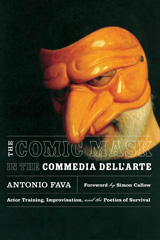 The Comic Mask in the Commedia dell'Arte: Actor Training, Improvisation, and the Poetics of Survival
Antonio Fava
Northwestern University Press, 2007 Winner, 2007 University & College Designers Association Design Award
Nobody says Shakespeare is dead, Antonio Fava tells us, but Commedia, they say, is dead. Why? Because clearly, he goes on, we have Shakespeare's texts, but nobody knows what to do with the improvisation that is the basis of the Commedia dell'Arte, despite massive documentation. This book by Fava, one of the few living master teachers of Commedia dell'Arte, is the first aesthetic and methodological study of the traditional Italian theater form--the first to describe, in a precise and practical way, what Commedia is and what it should be.
The mask--as object, symbol, character, theatrical practice, even spectacle itself--is the central metaphor around which Fava builds his discussion of structure, themes, characters, and methods. Drawing on twenty years of research conducted through his work as performer, director, mask maker, and scholar, he offers extensive practical, philosophical, and technical guidelines to performing the stock characters of Commedia, observing its structure, extracting its poetics, exploring its themes, and using the mask. A densely layered text combining historical fact, personal experience, philosophical speculation, and passionate opinion, and including copious illustrations--period drawings, prints, and color photographs of leather Commedia masks made by Fava himself--The Comic Mask in the Commedia dell'Arte is a rich work of singular insight into one of the world's most venerable forms of theater.
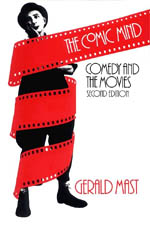 The Comic Mind: Comedy and the Movies
Gerald Mast
University of Chicago Press, 1979 Although books on the comedies of the silent era abound, few have attempted to survey film comedy as a whole—its history and evolution, how the philosophical visions of its greatest artists and directors have shaped its traditions, and how these visions have informed both the meaning and manner of their work.
Blending information with interpretation, description with analysis, Mast traces the development of screen comedy from the first crude efforts of Edison and Lumière to the subtlety and psychological complexity of Annie Hall. As he guides the reader through detailed discussions of specific films, Mast reveals the structures, the values, and the cinematic techniques which have appeared and reappeared in comic cinema.
The second edition of The Comic Mind treats the comic developments of the 1970s in terms of the traditions of film comedy set forth in the first edition, including a discussion of the evolution of Jacques Tati and the emergence of Mel Brooks and Woody Allen as the two greatest American comic stylists of the seventies.
"The most comprehensive study of film comedy yet written in English. . . .The book's extensive index with references to companies from which 16mm prints of many of the cited films may be rented will be of great value to the film teacher and audiovisual librarian."—Choice
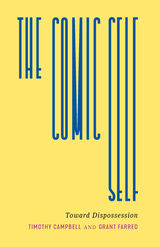 The Comic Self: Toward Dispossession
Timothy C. Campbell
University of Minnesota Press, 2023 A provocative and unconventional call to dispossess the self of itself
Challenging the contemporary notion of “self-care” and the Western mania for “self-possession,” The Comic Self deploys philosophical discourse and literary expression to propose an alternate and less toxic model for human aspiration: a comic self. Timothy Campbell and Grant Farred argue that the problem with the “care of the self,” from Foucault onward, is that it reinforces identity, strengthening the relation between I and mine. This assertion of self-possession raises a question vital for understanding how we are to live with each other and ourselves: How can you care for something that is truly not yours? The answer lies in the unrepresentable comic self. Campbell and Farred range across philosophy, literature, and contemporary comedy—engaging with Socrates, Burke, Hume, Hegel, Marx, Nietzsche, Heidegger, Derrida, Deleuze, and Levinas; Shakespeare, Cervantes, Woolf, Kafka, and Pasolini; and Stephen Colbert, David Chappelle, and the cast of Saturday Night Live. They uncover spaces where the dispossession of self and, with it, the dismantling of the regime of self-care are possible. Arguing that the comic self always keeps a precarious closeness to the tragic self, while opposing the machinations of capital endemic to the logic of self-possession, they provide a powerful and provocative antidote to the tragic self that so dominates the tenor of our times.
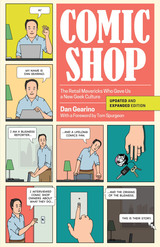 Comic Shop: The Retail Mavericks Who Gave Us a New Geek Culture
Dan Gearino
Ohio University Press, 2019 The modern comic book shop was born in the early 1970s. Its rise was due in large part to Phil Seuling, the entrepreneur whose direct market model allowed shops to get comics straight from the publishers. Stores could then better customize their offerings and independent publishers could access national distribution. Shops opened up a space for quirky ideas to gain an audience and helped transform small-press series, from Teenage Mutant Ninja Turtles to Bone, into media giants. Comic Shop is the first book to trace the history of these cultural icons. Dan Gearino brings us from their origins to the present-day, when the rise of digital platforms and a changing retail landscape have the industry at a crossroads. When the book was first published in 2017, Gearino had spent a year with stores around the country, following how they navigated the business. For this updated and expanded paperback edition, he covers the wild retail landscape of 2017 and 2018, a time that was brutal for stores and rich for comics as an art form. Along the way he interviews pioneers of comics retailing and other important players, including many women; top creators; and those who continue to push the business in new directions. A revised guide to dozens of the most interesting shops around the United States and Canada is a bonus for fans.
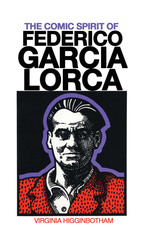 The Comic Spirit of Federico Garcia Lorca
By Virginia Higginbotham
University of Texas Press, 1976 During the years since his death, Federico García Lorca, Spain's best-known twentieth-century poet and playwright, has generally been considered a writer of tragedy. Three of his major plays are fatalistic stories of suffering and death, and his poetry is filled with dread. Yet most of Lorca's dramatic production consists of comedies and farces. Throughout his poetry and prose, as well as in his most somber plays, runs an undercurrent of humor—dark irony and satire—that is in no way contradictory to his tragic view of life. On the contrary, as Virginia Higginbotham demonstrates, through humor Lorca defines, intensifies, and tries to come to terms with what he sees as the essentially hopeless condition of humankind. Although Lorca's comic moments and techniques have been discussed in isolated articles, the importance of humor has largely been ignored in the fundamental studies of his work. Higginbotham is concerned with Lorca's total output: lyric poetry, tragicomedies and farces, avant-garde prose and plays, puppet farces, and master plays. She describes Lorca's place in the mainstream of the Spanish theater and shows his relationship to some relevant non-Spanish dramatists. Furthermore, she discusses ways in which Lorca's work anticipates the modern theater of the absurd. The result is a comprehensive study of an important, but previously ignored, aspect of Lorca's work. The Comic Spirit of Federico García Lorca includes a Lorca chronology and an extensive bibliography.
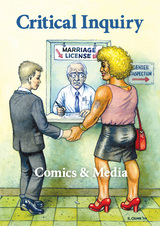 Comics & Media: A Special Issue of "Critical Inquiry"
Edited by Hillary L. Chute and Patrick Jagoda
University of Chicago Press, 2014 An exploration of the past, present, and future of comics from a gathering of top-tier critics
The twenty-first century has seen the medium of comics reach unprecedented heights of critical acclaim and commercial success. Comics & Media reflects that, bringing together an amazing array of contributors--creators and critics alike--to discuss the state, future, and potential of the medium.
Loaded with full-color reproductions of work by such legends as R. Crumb, Art Spiegelman, Alison Bechdel, Chris Ware, Daniel Clowes, and Lynda Barry, the book addresses the place of comics in both a contemporary and historical context. Essays by such high-profile figures as Tom Gunning, N. Katherine Hayles, Patrick Jagoda, and W. J. T. Mitchell address a stunning range of topics, including the place of comics in the history of aesthetics, changes to popular art forms, digital humanities, and ongoing tensions between new and old media. The result is a substantial step forward for our understanding of what comics are and can be, and the growing place they hold in our culture.
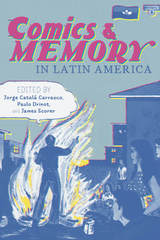 Comics and Memory in Latin America
Jorge Catala Carrasco
University of Pittsburgh Press, 2016 Latin American comics and graphic novels have a unique history of addressing controversial political, cultural, and social issues. This volume presents new perspectives on how comics on and from Latin America both view and express memory formation on major historical events and processes. The contributors, from a variety of disciplines including literary theory, cultural studies, and history, explore topics including national identity construction, narratives of resistance to colonialism and imperialism, the construction of revolutionary traditions, and the legacies of authoritarianism and political violence. The chapters offer a background history of comics and graphic novels in the region, and survey a range of countries and artists such as Joaquín Salvador Lavado (a.k.a Quino), Héctor G. Oesterheld, and Juan Acevedo. They also highlight the unique ability of this art and literary form to succinctly render memory. In sum, this volume offers in-depth analysis of an understudied, yet key literary genre in Latin American memory studies and documents the essential role of comics during the transition from dictatorship to democracy.
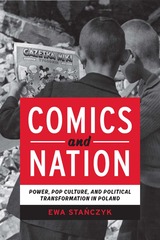 Comics and Nation: Power, Pop Culture, and Political Transformation in Poland
Ewa Stanczyk
Ohio State University Press, 2022 Winner, 2023 Comics Studies Society Charles Hatfield Book PrizeWinner, BASEES George Blazyca Award in East European StudiesComics and Nation offers a fresh perspective on the role of popular culture in the one-hundred-year history of the Polish state, from its foundation in 1918 to the present. Drawing on dozens of press articles, interviews, and readers’ letters, Ewa Stanczyk discusses how journalists, artists, and audiences used comics to probe the boundaries of national culture and scrutinize the established notions of Polishness. Critical moments of Poland’s political transformation ––the establishment of the interwar Polish Republic, the Cold War, the liberalization of the 1970s, the 1989 democratic transition, the turn to memory politics in the 2000s––have all been reflected in the history of Polish comics. Stanczyk offers new insights into how the production of homegrown comics and the influx of foreign works enabled commentators to express their fears, hopes, and disillusionment with political, economic, and cultural changes in Poland and beyond. At its core, Comics and Nation rethinks the impact of popular culture and transnational exchange on Polish nation building, citizenship formation, and the legitimation of power.
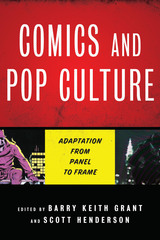 Comics and Pop Culture: Adaptation from Panel to Frame
By Barry Keith Grant and Scott Henderson
University of Texas Press, 2019 It is hard to discuss the current film industry without acknowledging the impact of comic book adaptations, especially considering the blockbuster success of recent superhero movies. Yet transmedial adaptations are part of an evolution that can be traced to the turn of the last century, when comic strips such as “Little Nemo in Slumberland” and “Felix the Cat” were animated for the silver screen. Representing diverse academic fields, including technoculture, film studies, theater, feminist studies, popular culture, and queer studies, Comics and Pop Culture presents more than a dozen perspectives on this rich history and the effects of such adaptations. Examining current debates and the questions raised by comics adaptations, including those around authorship, style, and textual fidelity, the contributors consider the topic from an array of approaches that take into account representations of sexuality, gender, and race as well as concepts of world-building and cultural appropriation in comics from Modesty Blaise to Black Panther. The result is a fascinating re-imagination of the texts that continue to push the boundaries of panel, frame, and popular culture.
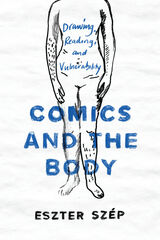 Comics and the Body: Drawing, Reading, and Vulnerability
Eszter Szép
Ohio State University Press, 2020 Eszter Szép’s Comics and the Body is the first book to examine the roles of the body in both drawing and reading comics within a single framework. With an explicit emphasis on the ethical dimensions of bodily vulnerability, Szép takes her place at the forefront of scholars examining comics as embodied experiences, pushing this line of inquiry into bold new territory. Focusing on graphic autobiography and reportage, she argues that the bodily performances of creators and readers produce a dialogue that requires both parties to experience and engage with vulnerability, thus presenting a crucial opportunity for ethical encounters between artist and reader. Szép considers visceral representations of bulimia, pregnancy, the effects of STIs, the catastrophic injuries of war, and more in the works of Lynda Barry, Ken Dahl, Katie Green, Miriam Katin, and Joe Sacco. She thus extends comics theory into ethical and psychological territory that finds powerful intersections and resonances with the studies of affect, trauma, gender, and reader response.
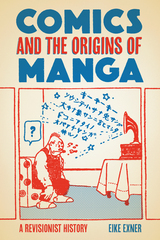 Comics and the Origins of Manga: A Revisionist History
Eike Exner
Rutgers University Press, 2022 2022 Eisner Award Winner for Best Academic/Scholarly Work
Japanese comics, commonly known as manga, are a global sensation. Critics, scholars, and everyday readers have often viewed this artform through an Orientalist framework, treating manga as the exotic antithesis to American and European comics. In reality, the history of manga is deeply intertwined with Japan’s avid importation of Western technology and popular culture in the early twentieth century.
Comics and the Origins of Manga reveals how popular U.S. comics characters like Jiggs and Maggie, the Katzenjammer Kids, Felix the Cat, and Popeye achieved immense fame in Japan during the 1920s and 1930s. Modern comics had earlier developed in the United States in response to new technologies like motion pictures and sound recording, which revolutionized visual storytelling by prompting the invention of devices like speed lines and speech balloons. As audiovisual entertainment like movies and record players spread through Japan, comics followed suit. Their immediate popularity quickly encouraged Japanese editors and cartoonists to enthusiastically embrace the foreign medium and make it their own, paving the way for manga as we know it today.
By challenging the conventional wisdom that manga evolved from centuries of prior Japanese art and explaining why manga and other comics around the world share the same origin story, Comics and the Origins of Manga offers a new understanding of this increasingly influential artform.
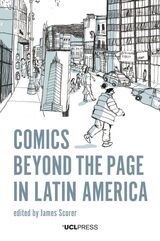 Comics Beyond the Page in Latin America
Edited by James Scorer
University College London, 2019 Comics Beyond the Page in Latin America is a cutting-edge study of the expanding worlds of Latin American comics. Despite lack of funding and institutional support, not since the mid-twentieth century have comics in the region been so dynamic, so diverse and so engaged with pressing social and cultural issues. Comics are being used as essential tools in debates about digital cultures, gender identities, and political disenfranchisement, as well as a whole range of other social issues. Rather than analyzing the current boom in comics by focusing just on the printed text, however, this book looks at diverse manifestations of comics 'beyond the page'. Contributors look at digital comics and social media networks; comics as graffiti and stencil art in public spaces; comics as a tool for teaching architecture or processing social trauma; and comics consumption and publishing as forms of shaping national, social, and political identities.
Comics Studies: A Guidebook
Charles Hatfield
Rutgers University Press, 2020 Nominee for the 2021 Eisner Awards Best Academic/Scholarly Work
In the twenty-first century, the field of comics studies has exploded. Scholarship on graphic novels, comic books, comic strips, webcomics, manga, and all forms of comic art has grown at a dizzying pace, with new publications, institutions, and courses springing up everywhere. The field crosses disciplinary and cultural borders and brings together myriad traditions. Comics Studies: A Guidebook offers a rich but concise introduction to this multifaceted field, authored by leading experts in multiple disciplines. It opens diverse entryways to comics studies, including history, form, audiences, genre, and cultural, industrial, and economic contexts. An invaluable one-stop resource for veteran and new comics scholars alike, this guidebook represents the state of the art in contemporary comics scholarship.
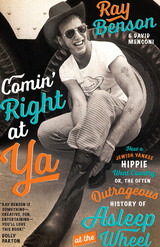 Comin' Right at Ya: How a Jewish Yankee Hippie Went Country, or, the Often Outrageous History of Asleep at the Wheel
By Ray Benson, and David Menconi
University of Texas Press, 2015 A who’s who of American popular music fills this lively memoir, in which Ray Benson recalls how a Philadelphia Jewish hippie and his bandmates in Asleep at the Wheel turned on generations of rock and country fans to Bob Wills–style Western swing.
A six-foot-seven-inch Jewish hippie from Philadelphia starts a Western swing band in 1970, when country fans hate hippies and Western swing. It sounds like a joke but—more than forty years, twenty-five albums, and ten Grammy Awards later—Asleep at the Wheel is still drawing crowds around the world. The roster of musicians who’ve shared a stage with the Wheel is a who’s who of American popular music—Van Morrison, Willie Nelson, Dolly Parton, Emmylou Harris, George Strait, Vince Gill, Lyle Lovett, and so many more. And the bandleader who’s brought them all together is the hippie that claimed Bob Wills’s boots: Ray Benson. In this hugely entertaining memoir, Benson looks back over his life and wild ride with Asleep at the Wheel from the band’s beginning in Paw Paw, West Virginia, through its many years as a Texas institution. He vividly recalls spending decades in a touring band, with all the inevitable ups and downs and changes in personnel, and describes the making of classic albums such as Willie and the Wheel and Tribute to the Music of Bob Wills and the Texas Playboys. The ultimate music industry insider, Benson explains better than anyone else how the Wheel got rock hipsters and die-hard country fans to love groovy new-old Western swing. Decades later, they still do.
Coming After: Essays on Poetry
Alice Notley
University of Michigan Press, 2005 Coming After gathers critical pieces by acclaimed poet Alice Notley, author of Mysteries of Small Houses and Disobedience.
Notley explores the work of second-generation New York School poets and their allies: Ted Berrigan, Anne Waldman, Joanne Kyger, Ron Padgett, Lorenzo Thomas, and others. These essays and reviews are among the first to deal with a generation of poets notorious for their refusal to criticize and theorize, assuming the stance that "only the poems matter." The essays are characterized by Notley's strong, compelling voice, which transfixes the reader even in the midst of professional detail. Coming After revives the possibility of the readable book of criticism.
Coming after Oprah: Cultural Fallout in the Age of the TV Talk Show
Vicki Abt and Leonard Mustazza
University of Wisconsin Press, 1997 More than just a commentary on the aesthetics of the genre, this book looks at the evolution and cultural significance of these programs, disputing claims that they are nothing more than harmless entertainment. In the work’s revealing first half, Vicki Abt and Leonard Mustazza uncover the mechanics of the talk-show game. The second half examines the behind-the-scenes economic games and their implications, revealing a web of complex commercial and political interests that influence their production. A detailed description of the corporate players and the revenues they are generating is also provided. The study concludes with suggestions for what we as a culture might do to protect ourselves from its inherent deceptions and misinformation.
Coming and Going: New and Selected Poems
James McAuley
University of Arkansas Press, 1989 Exile—with its sense of suspended or impending motion, of change, loss, acceptance—gives James J. McAuley’s poems their need to be, their means of surviving the exigencies of the displaced spirit. Ancestors on both sides of his family were bards in Celtic Ireland. Although a naturalized United States citizen, McAuley has maintained his connections with his native land: the Irish times listed him among one hundred “significant Irish writers.” Although the poet writes of the familial and the domestic, he is writing at the same time of journeys out and back, of losses and recoveries. McAuley is as much at ease with the solemnity of elegy as with the invective of political satire or the sensual metaphysics of the love-poem.
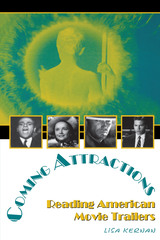 Coming Attractions: Reading American Movie Trailers
By Lisa Kernan
University of Texas Press, 2004 Movie trailers—those previews of coming attractions before the start of a feature film—are routinely praised and reviled by moviegoers and film critics alike: "They give away too much of the movie." "They're better than the films." "They only show the spectacular parts." "They lie." "They're the best part of going to the movies." But whether you love them or hate them, trailers always serve their purpose of offering free samples of a film to influence moviegoing decision-making. Indeed, with their inclusion on videotapes, DVDs, and on the Internet, trailers are more widely seen and influential now than at any time in their history. Starting from the premise that movie trailers can be considered a film genre, this pioneering book explores the genre's conventions and offers a primer for reading the rhetoric of movie trailers. Lisa Kernan identifies three principal rhetorical strategies that structure trailers: appeals to audience interest in film genres, stories, and/or stars. She also analyzes the trailers for twenty-seven popular Hollywood films from the classical, transitional, and contemporary eras, exploring what the rhetorical appeals within these trailers reveal about Hollywood's changing conceptions of the moviegoing audience. Kernan argues that movie trailers constitute a long-standing hybrid of advertising and cinema and, as such, are precursors to today's heavily commercialized cultural forms in which art and marketing become increasingly indistinguishable.
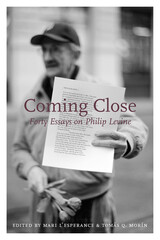 Coming Close: Forty Essays on Philip Levine
Mari L'Esperance and Tomas Morin
University of Iowa Press, 2013 This collection of essays pays tribute to Philip Levine as teacher and mentor. Throughout his fifty-year teaching career, the Pulitzer Prize–winning Levine taught scores of younger poets, many of whom went on to become famous in their own right. These forty essays honor and celebrate one of our most vivid and gifted poets.
Whether in Fresno, New York, Boston, Detroit, or any of the other cities where Levine taught, his students benefited from his sharp, humorous honesty in the classroom. In these personal essays, poets spanning a number of generations reveal how their lives and work were forever altered by studying with Levine. The heartfelt tributes illuminate how one dedicated teacher’s intangible gifts can make a vast difference in the life of a developing poet, as well as providing insight into the changing tenor of the poetry workshop in the American university setting.
Here, poets as diverse as Nick Flynn and David St. John, Sharon Olds and Larry Levis, Ada Limon and Mark Levine, Malena Morling and Lawson Fusao Inada are united in their deep regard for Philip Levine. The voices echo and reverberate as each strikes its own honoring tone. Contributors: Aaron Belz, Ciaran Berry, Paula Bohince, Shane Book, B. H. Boston, Xochiquetzal Candelaria, Colin Cheney, Michael Clifton, Michael Collier, Nicole Cooley, Kate Daniels, Blas Manuel De Luna, Kathy Fagan, Andrew Feld, Nick Flynn, Edward Hirsch, Sandra Hoben, Ishion Hutchinson, Lawson Fusao Inada, Dorianne Laux, Joseph O. Legaspi, Mark Levine, Larry Levis, Ada Limón, Elline Lipkin, Jane Mead, Dante Micheaux, Malena Mörling, John Murillo, Daniel Nester, Sharon Olds, January Gill O’Neil, Greg Pape, Kathleen Peirce, Sam Pereira, Jeffrey Skinner, Tom Sleigh, David St. John, Brian Turner, Robert Wrigley
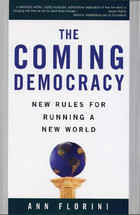 The Coming Democracy: New Rules For Running A New World
Ann Florini
Island Press, 2003 National governments are proving ill-equipped to manage an increasingly complicated suite of global problems, from infectious diseases to climate change to conflicts over international trade. In The Coming Democracy, leading political analyst Ann Florini sets forth a compelling new paradigm for transnational governance, one based on the concept of “transparency”— the idea that the free flow of information (on topics ranging from corporate and government behavior to nuclear proliferation to biodiversity protection) provides powerful ways to hold decision makers accountable and to give ordinary people meaningful voice in shaping the policies that affect them. Dramatic breakthroughs in information technology of the past decade have made such transparency possible on a global scale. Florini offers a clear and comprehensive assessment of the possibilities for using transparency to develop effective approaches to transnational governance. She shows how this new form of governance promises real hope for managing global problems, and provides a compelling scenario that demonstrates how existing conventions and institutions can lead the way in the evolution of a better system of global governance.
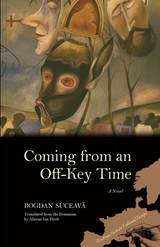 Coming from an Off-Key Time: A Novel
Bogdan Suceava
Northwestern University Press, 2011 The fall of communism in Eastern Europe in 1989 marked, in one famous formulation, the "end of history." In his apocalyptic novel Coming from an Off-Key Time, Bogdan Suceavă satirizes the events in his native Romania since the violent end of the Ceauşescu regime that fateful year. Suceavă uses three interrelated narratives to illustrate the destructive power of Romanian society’s most powerful mythologies. He depicts madness of all kinds but especially religious beliefs and their perversion by all manner of outrageous sects. Here horror and humor reside impossibly in the same time and place, and readers experience the vertiginous feeling of living in the middle of a violent historical upheaval. Even as Coming from an Off-Key Time suggests the influence of such writers as Mikhail Bulgakov, the fantastic satirist of the early Soviet Union, Suceavă engages the complexities of a quickly changing country in search of its bearings and suspicious of its past. Bogdan Suceavă is an associate professor of mathematics at California State University, Fullerton. One of Romanian literature’s most promising and original young writers, he is the author of four novels, two books of short stories, and several collections of poems. Alistair Ian Blyth’s previous translations include Filip Florian, Little Fingers (2009); Lucian Dan Teodorovici, Our Circus Presents (2009); and Catalin Avramescu’s An Intellectual History of Cannibalism (2009).
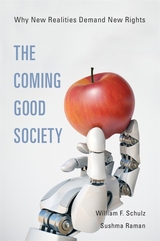 The Coming Good Society: Why New Realities Demand New Rights
William F. Schulz and Sushma Raman
Harvard University Press, 2020 Two authors with decades of experience promoting human rights argue that, as the world changes around us, rights hardly imaginable today will come into being.
A rights revolution is under way. Today the range of nonhuman entities thought to deserve rights is exploding—not just animals but ecosystems and even robots. Changes in norms and circumstances require the expansion of rights: What new rights, for example, are needed if we understand gender to be nonbinary? Does living in a corrupt state violate our rights? And emerging technologies demand that we think about old rights in new ways: When biotechnology is used to change genetic code, whose rights might be violated? What rights, if any, protect our privacy from the intrusions of sophisticated surveillance techniques?
Drawing on their vast experience as human rights advocates, William Schulz and Sushma Raman challenge us to think hard about how rights evolve with changing circumstances, and what rights will look like ten, twenty, or fifty years from now. Against those who hold that rights are static and immutable, Schulz and Raman argue that rights must adapt to new realities or risk being consigned to irrelevance. To preserve and promote the good society—one that protects its members’ dignity and fosters an environment in which people will want to live—we must at times rethink the meanings of familiar rights and consider the introduction of entirely new rights.
Now is one of those times. The Coming Good Society details the many frontiers of rights today and the debates surrounding them. Schulz and Raman equip us with the tools to engage the present and future of rights so that we understand their importance and know where we stand.
 The Coming Health Crisis: Who Will Pay for Care for the Aged in the 21st Century?
John R. Wolfe
University of Chicago Press, 1993 By the turn of the century, the largest generation of Americans in history, the "Baby Boomers," will be approaching 65 years old. But as the demand for health and long-term care is growing dramatically, health care programs have been shrinking instead of expanding to meet the older generation's needs. In this timely book, John R. Wolfe offers practical solutions to the coming health crisis, exploring innovative ways of developing insurance plans for the care of the large, aging "Baby Boom" generation and beyond.
In previous decades, when younger Americans far outnumbered older ones, retirees could depend on financial support through taxes from the population at large. But as "Boomers" retire and the work force begins to shrink, there will be a disproportionately large population of retirees to workers. With such a big jump in the percentage of older Americans in the population, fewer workers will be able to to transfer funds, through taxes, to retirees. Moreover, other traditionally reliable sources of financial assistance—Social Security, Medicare, and Medicaid—have faced serious financial difficulties in recent years. Who will the aged turn to for assistance?
The Coming Health Crisis suggests that as funds from all quarters dwindle, older Americans will have to look to alternative programs for financial assistance. Wolfe urges immediate action to develop new saving programs and increase existing transfer schemes to head off an imminent crisis. Although tax increases might provide some resources, he demonstrates that it is more important to accumulate capital to create solid reserves for the future. Wolfe also explores two roles for government: prefunding new or existing social insurance programs and promoting private insurance options. By exempting insurance fund income from corporate taxation and permitting people at all income levels to defer income tax on accounts earmarked for long-term care, he shows how government could greatly encourage and expand personal saving.
Finally, this work assesses the value of other recent health and long-term-care innovations: social/health maintenance organizations, long-term-care individual retirement accounts, and reverse annuity mortgages, in addition to vouchers, care rationing, mandatory public insurance, and expanded private coverage. Through this wide-ranging survey, Wolfe demonstrates that, through a combination of these programs, we can care for the aging "Baby Boom" generation by anticipating their needs and saving now.
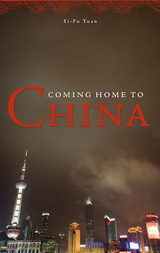 Coming Home to China
Yi-Fu Tuan
University of Minnesota Press, 2007 In the summer of 2005, distinguished geographer Yi-Fu Tuan ventured to China to speak at an international architectural conference, returning for the first time to the place he had left as a child sixty-four years before. He traveled from Beijing to Shanghai, addressing college audiences, floating down the Yangtze River on a riverboat, and visiting his former home in Chongqing. In this enchanting volume, Tuan’s childhood memories and musings on the places encountered during this homecoming are interspersed with new lectures, engaging overarching principles of human geography as well as the changing Chinese landscape. Throughout, Tuan’s interactions with his hosts, with his colleague’s children, and even with a garrulous tour guide, offer insights into one who has spent his life studying place, culture, and self. At the beginning of his trip, Tuan wondered if he would be a stranger among people who looked like him. By its end, he reevaluates his own self-definition as a hyphenated American and sheds new light on human identity’s complex roots in history, geography, and language. Yi-Fu Tuan is author of Cosmos and Hearth, Dear Colleague, and Space and Place, all from Minnesota. He retired from the University of Wisconsin-Madison in 1998.
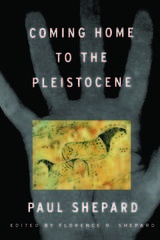 Coming Home to the Pleistocene
Paul Shepard; Edited by Florence R. Shepard
Island Press, 1998 "When we grasp fully that the best expressions of our humanity were not invented by civilization but by cultures that preceded it, that the natural world is not only a set of constraints but of contexts within which we can more fully realize our dreams, we will be on the way to a long overdue reconciliation between opposites which are of our own making." --from Coming Home to the Pleistocene Paul Shepard was one of the most profound and original thinkers of our time. Seminal works like The Tender Carnivore and the Sacred Game, Thinking Animals, and Nature and Madness introduced readers to new and provocative ideas about humanity and its relationship to the natural world. Throughout his long and distinguished career, Paul Shepard returned repeatedly to his guiding theme, the central tenet of his thought: that our essential human nature is a product of our genetic heritage, formed through thousands of years of evolution during the Pleistocene epoch, and that the current subversion of that Pleistocene heritage lies at the heart of today's ecological and social ills. Coming Home to the Pleistocene provides the fullest explanation of that theme. Completed just before his death in the summer of 1996, it represents the culmination of Paul Shepard's life work and constitutes the clearest, most accessible expression of his ideas. Coming Home to the Pleistocene pulls together the threads of his vision, considers new research and thinking that expands his own ideas, and integrates material within a new matrix of scientific thought that both enriches his original insights and allows them to be considered in a broader context of current intellectual controversies. In addition, the book explicitly addresses the fundamental question raised by Paul Shepard's work: What can we do to recreate a life more in tune with our genetic roots? In this book, Paul Shepard presents concrete suggestions for fostering the kinds of ecological settings and cultural practices that are optimal for human health and well-being. Coming Home to the Pleistocene is a valuable book for those familiar with the life and work of Paul Shepard, as well as for new readers seeking an accessible introduction to and overview of his thought.
 Coming of Age as a Poet: Milton, Keats, Eliot, Plath
Helen Vendler
Harvard University Press, 2003 “Brilliant...full of perceptions and rewards that send one scurrying back to the text.” —John Bayley, New York Review of Books
The finest reader of her generation retraces four great poets’ first steps across the threshold of genius.
To find a personal style is, for a writer, to become an adult; and to write one’s first “perfect” poem—a poem that wholly and successfully embodies that style—is to come of age as a poet. By looking at the precedents, circumstances, and artistry of the first perfect poems composed by John Milton, John Keats, T. S. Eliot, and Sylvia Plath, Coming of Age as a Poet offers rare insight into this mysterious process, and into the indispensable period of learning and experimentation that precedes such poetic achievement.
Milton’s “L’Allegro,” Keats’s “On First Looking into Chapman’s Homer,” Eliot’s “The Love Song of J. Alfred Prufrock,” and Plath’s “The Colossus” are the poems that Helen Vendler considers, exploring each as an accession to poetic confidence, mastery, and maturity. In meticulous and sympathetic readings of the poems, and with reference to earlier youthful compositions, she delineates the context and the terms of each poet’s self-discovery—illuminating the private, intense, and ultimately heroic effort and endurance that precede the creation of any memorable poem.
With characteristic precision, authority, and grace, Vendler helps us to appreciate anew the conception and the practice of poetry, and to observe firsthand the living organism that breathes through the lines of a great poem.
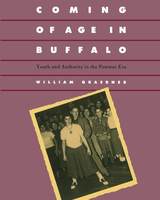 Coming Of Age In Buffalo: Youth and Authority in the Postwar Era
William Graebner
Temple University Press, 1993 Pegged pants poodle skirts, record hops, rock ‘n’ roll, soda shops: in the interval between the bombing of Hiroshima and the assassination of John F. Kennedy, these were distinguishing marks of the "typical" postwar teenager-if there was a "typical" teenager. In this richly illustrated account of Youth in postwar Buffalo, William Graebner argues that the so-called Youth culture was really a variety of "disparate subcultures, united by age but in conflict over class, race, ethnicity, and gender." Using scrap books, oral histories, school Yearbooks, and material culture, he shows how Buffalo teenagers were products of diverse and often antagonistic subcultures. The innocuous strains of "Rock Around the Clock" muffled the seething gang loyalties and countercultural influence of James Dean, Marlon Brando, and Buffalo’s own "Hound Dog" Lorenz. Racial antipathies once held in check spilled out on Memorial Day, 1956, when white and black Youth clashed on board a take Erie pleasure boat in a "riot" that recast the city’s race relations for decades to come. While exploring the diversity within Youth subcultures, Graebner examines the ways in which adults—educators, clergy, representatives of the media, and other authorities—sought to contain this generation. The Hi-Teen Club, Buffalo Plan dress code, record hops, graduation ceremonies, film censorship, and restrictions on secret societies and on corner lounging were all forms of social engineering that reinforced social and economic boundaries that were at the heart of the dominant culture. The prevailing adult influence on activities, attitudes, and style served to redirect the "misguided Youth" of the fifties and to obliterate their image from public memory. Although the media still portrays this decade as the golden age of cultural homogeneity, the diversity in musical preferences, hair and clothing styles, and allegiances to disc jockeys suggest the wide diversity of Youth experiences and challenges to adult authority that were part of coming of age in postwar America.
 Coming of Age in Chinese Literature and Cinema: Sinophone Variations of the Bildungsroman
Andrea Riemenschnitter
Amsterdam University Press, 2025 With the inclusion of twelve original articles by established and emerging international scholars, this volume offers critical reading of literary and cinematic texts produced in China and Sinophone communities between the 1950s and 2010s. The articles portray the lineage and mutations of the Chinese Bildungsroman, providing insights into the tensions between individual and society; nation and the world; and the multiple social, ecological, and virtual realities of recent decades. Concerned with how coming-of-age narratives have persistently returned and evolved over time, the book addresses themes such as family and social change; gender, class, and generational divides, local/global politics, and the ecological and posthuman turns in Chinese/Sinophone culture. It offers a fresh look on how the transnational and transgenerational journeys of Bildungsroman and coming-of-age narratives continuously transform and reinvigorate generic conventions, to explore adolescence as a formative social force and aesthetic experience in Chinese/Sinophone literature and film.
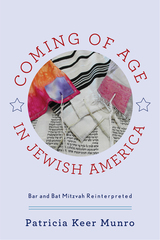 Coming of Age in Jewish America: Bar and Bat Mitzvah Reinterpreted
Patricia Keer Munro
Rutgers University Press, 2016 The Jewish practice of bar mitzvah dates back to the twelfth century, but this ancient cultural ritual has changed radically since then, evolving with the times and adapting to local conditions. For many Jewish-American families, a child’s bar mitzvah or bat mitzvah is both a major social event and a symbolic means of asserting the family’s ongoing connection to the core values of Judaism. Coming of Age in Jewish America takes an inside look at bar and bat mitzvahs in the twenty-first century, examining how the practices have continued to morph and exploring how they serve as a sometimes shaky bridge between the values of contemporary American culture and Judaic tradition. Interviewing over 200 individuals involved in bar and bat mitzvah ceremonies, from family members to religious educators to rabbis, Patricia Keer Munro presents a candid portrait of the conflicts that often emerge and the negotiations that ensue. In the course of her study, she charts how this ritual is rife with contradictions; it is a private family event and a public community activity, and for the child, it is both an educational process and a high-stakes performance. Through detailed observations of Conservative, Orthodox, Reform, and independent congregations in the San Francisco Bay Area, Munro draws intriguing, broad-reaching conclusions about both the current state and likely future of American Judaism. In the process, she shows not only how American Jews have forged a unique set of bar and bat mitzvah practices, but also how these rituals continue to shape a distinctive Jewish-American identity.
Coming of Age in Madrid: An Oral History of Unaccompanied Moroccan Migrant Minors
Susan Plann
Sussex Academic Press, 2022 Coming of Age in Madrid; is a longitudinal study of twenty-seven Moroccan youth who migrated to Madrid as unaccompanied minors, passed their adolescence in the Spanish child-care system, and embarked on their lives as young adults. Using qualitative interviews to capture narrators accounts in their own words, this oral history examines their identity trans/formation, integration, and acculturation in Spain. Unaccompanied minor migration is on the rise throughout the world. As Spain and other nations grapple with increasing numbers of unaccompanied children on their borders, the importance of this study has immediate relevance for government policies and migration research.
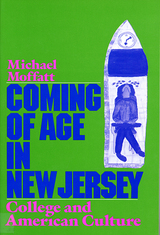 Coming of Age in New Jersey: College and American Culture
Moffatt, Michael
Rutgers University Press, 1989 "With Kinseyesque diligence [Moffatt] catalogues the sexual habits and fantasies of his students. . . . His book vibrates with quirky authenticity." --New York Times Book Review "Useful for understanding the student experience . . . throughout the United States. . . . Beautifully written, carefully researched . . . a classic."--John Thelin, Educational Studies "Michael Moffatt is a multitalented, multidisciplinary scholar . . . who writes without a trace of gobbledygook. He deserves a wide following." --Rupert Wilkinson, Journal of American Studies "One of the most thoughtfully crafted case studies of undergraduate culture . . . ever written . . . a book every professor should read." --Paul J. Baker, Academe Coming of Age is about college as students really know it and--often--love it. To write this remarkable account, Michael Moffatt did what anthropologists usually do in more distant cultures: he lived among the natives. His findings are sometimes disturbing, potentially controversial, but somehow very believable. Coming of Age is a vivid slice of life of what Moffatt saw and heard in the dorms of a typical state university, Rutgers, in the 1980s. It is full of student voices: naive and worldy-wise, vulgar and polite, cynical, humorous, and sometimes even idealistic. But it is also about American culture more generally: individualism, friendship, community, bureaucracy, diversity, race, sex, gender, intellect, work, and play. As an example of an ethnography written about an anthropologist's own culture, this book is an uncommon one. As a new and revealing perspective on the much-studied American college student, it is unique.
 Coming of Age in Post-Soviet Russia
Fran Markowitz
University of Illinois Press, 2000 Anthropologist Fran Markowitz interviewed more than one hundred Russian teenagers to discover how adolescents have been coping with their country's seismic transitions. Her findings present a substantive challenge to near-axiomatic theories of human development that regard cultural stability as indispensable to the successful navigation of adolescence.
Markowitz's fieldwork leads to the surprising conclusion that the disruptions brought by glasnost, perestroika, and the fragmentation of the USSR exerted a greater impact on Western political hopes and on many of Russia's adults than on young people's perceptions of their lives. In their remarks on topics ranging from being Russian to religion, sex, music, and military service, the teenagers convey a flexible and optimistic approach to the future and a sense of security deriving from strong family, school, and neighborhood ties. Their perspectives suggest that culture change and social instability may be seen as positive forces, allowing for expressive opportunities, the establishment of individualized identities, and creative, pragmatic planning.
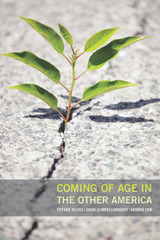 Coming of Age in the Other America
Stefanie DeLuca
Russell Sage Foundation, 2016 Recent research on inequality and poverty has shown that those born into low-income families, especially African Americans, still have difficulty entering the middle class, in part because of the disadvantages they experience living in more dangerous neighborhoods, going to inferior public schools, and persistent racial inequality. Coming of Age in the Other America shows that despite overwhelming odds, some disadvantaged urban youth do achieve upward mobility. Drawing from ten years of fieldwork with parents and children who resided in Baltimore public housing, sociologists Stefanie DeLuca, Susan Clampet-Lundquist, and Kathryn Edin highlight the remarkable resiliency of some of the youth who hailed from the nation’s poorest neighborhoods and show how the right public policies might help break the cycle of disadvantage. Coming of Age in the Other America illuminates the profound effects of neighborhoods on impoverished families. The authors conducted in-depth interviews and fieldwork with 150 young adults, and found that those who had been able to move to better neighborhoods—either as part of the Moving to Opportunity program or by other means—achieved much higher rates of high school completion and college enrollment than their parents. About half the youth surveyed reported being motivated by an “identity project”—or a strong passion such as music, art, or a dream job—to finish school and build a career. Yet the authors also found troubling evidence that some of the most promising young adults often fell short of their goals and remained mired in poverty. Factors such as neighborhood violence and family trauma put these youth on expedited paths to adulthood, forcing them to shorten or end their schooling and find jobs much earlier than their middle-class counterparts. Weak labor markets and subpar postsecondary educational institutions, including exploitative for-profit trade schools and under-funded community colleges, saddle some young adults with debt and trap them in low-wage jobs. A third of the youth surveyed—particularly those who had not developed identity projects—were neither employed nor in school. To address these barriers to success, the authors recommend initiatives that help transform poor neighborhoods and provide institutional support for the identity projects that motivate youth to stay in school. They propose increased regulation of for-profit schools and increased college resources for low-income high school students. Coming of Age in the Other America presents a sensitive, nuanced account of how a generation of ambitious but underprivileged young Baltimoreans has struggled to succeed. It both challenges long-held myths about inner-city youth and shows how the process of “social reproduction”—where children end up stuck in the same place as their parents—is far from inevitable.
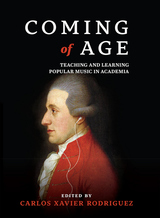 Coming of Age: Teaching and Learning Popular Music in Academia
Edited by Carlos Rodriguez
Michigan Publishing, 2017 As the twenty-first century’s third decade approaches, popular music study has achieved greater scope, depth, and prominence in academic departments of music conservatories than ever before. Musicology, music theory, and music education scholars have recognized the significant role and influence of popular music in contemporary society, and also in their own lives, utilizing their personal insights to broaden disciplinary boundaries while more directly addressing the needs for musical understanding in the communities they serve.
This book is a collection of essays originally presented at Ann Arbor Symposium IV, Teaching and Learning Popular Music, at the University of Michigan. Organized into four sections of similar-themed writings, the essays trace numerous discourses, principles, methods, and prospects for popular music education in academia. Additionally, the book contains several features that are useful for modern-day scholars and their institutions. First, it acknowledges the gradual liquidation of traditional disciplinary boundaries, signaling the likely future dominance of interdisciplinary research and collaborations. Second, it values international perspectives of music teaching and learning. Third, the selected topics, methodologies, and predictions provide a working agenda for the future development and success of popular music teaching and learning.
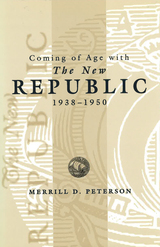 Coming of Age with the New Republic, 1938-1950
Merrill D. Peterson
University of Missouri Press, 1999
In this absorbing memoir, Merrill D. Peterson traces his progress from a young Kansas Republican to a "Left Liberal," Democrat by reconstructing how the New Republic singularly influenced his intellectual development and academic career during some of the most turbulent years in American history—the final years of the Great Depression through World War II and the beginnings of the Cold War. Peterson recalls how, as a young man, he was guided to intellectual maturity by such extraordinary individuals as Max Lerner, Archibald MacLeish, Vincent Sheean, Alfred Kazin, Lewis Mumford, and Malcolm Cowley—all contributors to this important magazine. We look back, with Peterson, and see how their views are inextricably reflected in his own developing worldview.
Peterson was introduced to this liberal weekly by one of his teachers during his senior year of high school (1938-1939). For the next ten years, the magazine served as his principal guide to the politics and culture of the times. Now, at seventy-eight years of age, Peterson revisits the magazine that he read so eagerly during those early, impressionable years. With considerable skill and charm, Peterson weaves together the fresh reading, the history of the country during the 1940s, and his own personal history to give us the heart of the book. In addition, he includes brief essays on Vernon L. Parrington, Lewis Mumford, and Max Lerner, the three American writers and intellectuals he believes had the most influence on him.
Peterson discusses several turning points in his young life, but he focuses primarily on his education and the role the magazine played in it. The book concludes when Peterson, with a Ph.D. in the history of American civilization, accepts his first academic appointment, at Brandeis University, and approaches the publication of his first book. Thus, a critical chapter in his life comes to a close.
 Coming of Age(ncy) on the Migrant Trail: Adolescent Journeys in Contemporary Latinx Young Adult Literature
Susana S. Martínez
Ohio State University Press, 2025 Susana S. Martínez’s Coming of Age(ncy) on the Migrant Trail maps the contours of agency in young adult literature involving Latine/x migrant youth—a project that could not be timelier given anti-immigrant hostility, LGBTQ+ book bans, and intense scrutiny of how we teach about race. Martínez leads readers chronologically and geographically from the 1980s Central American civil wars north through Mexico during the war on drugs to the recent experiences of those living undocumented in the United States, showing that YA is an ideal medium through which to tease out those stories of Central American migration that are often subsumed within Latine/x studies and to combat stereotypes of young migrants. Viewed through the lenses of intersectionality and racialized capitalism’s politics of disposability, the novels in question contribute to timely antiracist pedagogical discussions where youth emerge as catalysts for social change. By including non-Latinx authors who wrote about the Guatemalan and Salvadoran civil conflicts alongside authors from the Central American diaspora—Marcia Argueta Mickelson, Jennifer De Leon, and Bessie Flores Zaldívar among them—Martínez invites us to reflect on solidarity in contentious times.
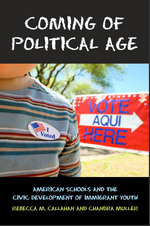 Coming of Political Age: American Schools and the Civic Development of Immigrant Youth
Rebecca M. Callahan
Russell Sage Foundation, 2013 As one of the fastest-growing segments of the American population, the children of immigrants are poised to reshape the country’s political future. The massive rallies for immigration rights in 2006 and the recent push for the DREAM Act, both heavily supported by immigrant youth, signal the growing political potential of this crucial group. While many studies have explored the political participation of immigrant adults, we know comparatively little about what influences civic participation among the children of immigrants. Coming of Political Age persuasively argues that schools play a central role in integrating immigrant youth into the political system. The volume shows that the choices we make now in our educational system will have major consequences for the country’s civic health as the children of immigrants grow and mature as citizens. Coming of Political Age draws from an impressive range of data, including two large surveys of adolescents in high schools and interviews with teachers and students, to provide an insightful analysis of trends in youth participation in politics. Although the children of both immigrant and native-born parents register and vote at similar rates, the factors associated with this likelihood are very different. While parental educational levels largely explain voting behavior among children of native-born parents, this volume demonstrates that immigrant children’s own education, in particular their exposure to social studies, strongly predicts their future political participation. Learning more about civic society and putting effort into these classes may encourage an interest in politics, suggesting that the high school civics curriculum remains highly relevant in an increasingly disconnected society. Interestingly, although their schooling predicts whether children of immigrants will vote, how they identify politically depends more on family and community influences. As budget cuts force school administrators to realign academic priorities, this volume argues that any cutback to social science programs may effectively curtail the political and civic engagement of the next generation of voters. While much of the literature on immigrant assimilation focuses on family and community, Coming of Political Age argues that schools—and social science courses in particular—may be central to preparing the leaders of tomorrow. The insights and conclusions presented in this volume are essential to understand how we can encourage more participation in civic action and improve the functioning of our political system.
The Coming of the Civil War
Avery O. Craven
University of Chicago Press, 1966 "In recent years a highly industrious school of historians has begun asking whether the war should have been fought at all and whether it was perhaps not more the fault of the North than of the South. Seeking to revise earlier judgments they have become known as the revisionists, and one of the most gifted and studious of them all is Avery Craven, whose The Coming of the Civil War . . . is one of the landmarks of revisionist literature."—Bruce Catton, American Heritage
". . . those who would examine the democratic process during a period of progressive breakdown, in order to understand the dangers it embodies within itself, will find The Coming of the Civil War a classic analysis."—Louis D. Rubin, Jr., Sewanee Review
"The book has always been recognized, even by its most severe critics, as a work of consummate scholarship."—T. Harry Williams, Baton Rouge Morning Advocate
The Coming of the Frontier Press: How the West Was Really Won
Barbara Cloud
Northwestern University Press, 2008 From the first story about the discovery of gold in California in 1848 to features on today’s western boomtowns, western expansion and journalism have had a symbiotic relationship. By examining this relationship along its entire timeline, this book argues that newspapers played a crucial role in pushing aside both wildlife and Native Americans to make room for the settlers who would become their readers. The western news sheets not only shaped reader attitudes but also undertook innovations in content and appearance that would affect newspapers nationwide.
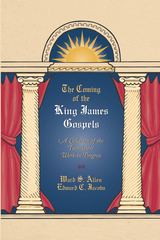 The Coming of the King James Gospels: A Collection of the Translators’ Work-in-Progress
Ward S. Allen
University of Arkansas Press, 1994 The Coming of the King James Gospels is a primary publication exploring the handwritten annotations of the Oxford New Testament Company, made as members completed Matthew, Mark, Luke, and John. Their original edited pages, gathered into one binding as the Bodleian Bishops’ Bible ([1602] b.1), offer us the only known surviving record of their monumental work. Ward Allen’s painstakingly produced collation of this Bishops’ Bible is available for the first time in acessible visual layout. It allows a reader to study simultaneously the three texts, that of the original Bishops’ Bible, the revisions suggested for the 1602 text, and the final King James version of the Gospels. Rejected readings reveal the reasoning which led to the wording of the final text. Beautifully produced, The Coming of the King James Gospels is now a prime resource for all students of the Bible and the English language.
 The Coming of the Terror in the French Revolution
Timothy Tackett
Harvard University Press, 2015 Between 1793 and 1794, thousands of French citizens were imprisoned and hundreds sent to the guillotine by a powerful dictatorship that claimed to be acting in the public interest. Only a few years earlier, revolutionaries had proclaimed a new era of tolerance, equal justice, and human rights. How and why did the French Revolution’s lofty ideals of liberty, equality, and fraternity descend into violence and terror?
“By attending to the role of emotions in propelling the Terror, Tackett steers a more nuanced course than many previous historians have managed…Imagined terrors, as…Tackett very usefully reminds us, can have even more political potency than real ones.”
—David A. Bell, The Atlantic
“[Tackett] analyzes the mentalité of those who became ‘terrorists’ in 18th-century France…In emphasizing weakness and uncertainty instead of fanatical strength as the driving force behind the Terror…Tackett…contributes to an important realignment in the study of French history.”
—Ruth Scurr, The Spectator
“[A] boldly conceived and important book…This is a thought-provoking book that makes a major contribution to our understanding of terror and political intolerance, and also to the history of emotions more generally. It helps expose the complexity of a revolution that cannot be adequately understood in terms of principles alone.”
—Alan Forrest, Times Literary Supplement
 Coming on Strong: Gender and Sexuality in Twentieth-Century Women’s Sports
Susan K. Cahn
Harvard University Press Today, there are women athletes who are media celebrities and a source of inspiration for many. But not long ago, being serious about sport was considered appropriate only for men and boys. Throughout the twentieth century, women's increasing participation in sport has challenged our conception of womanhood. Some celebrated the female athlete as the embodiment of modern womanhood, but others branded her "mannish" or lesbian. Ultimately, she altered the perception of sport as an exclusively male domain.
Susan Cahn's story of how sport has changed women's lives and women have transformed sport is an important chapter in the wider history of women's struggles to define their role in the twentieth century. For the women who dared to compete, participation in sport enabled them to expand the boundaries of women's activities and to claim that strength, skill, physicality, and competitiveness could be authentic attributes of womanhood. This is the legacy they passed on to the new generation of women for whom athleticism is becoming a way of life.
Coming On Strong: Gender and Sexuality in Women's Sport
Susan K. Cahn
University of Illinois Press, 2015 Acclaimed since its original publication, Coming on Strong has become a much-cited touchstone in scholarship on women and sports. In this new edition, Susan K. Cahn updates her detailed history of women's sport and the struggles over gender, sexuality, race, class, and policy that have often defined it. A new chapter explores the impact of Title IX and how the opportunities and interest in sports it helped create reshaped women's lives even as the legislation itself came under sustained attack.
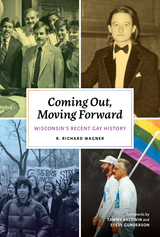 Coming Out, Moving Forward: Wisconsin’s Recent Gay History
R. Richard Wagner
Wisconsin Historical Society Press, 2020 Coming Out, Moving Forward, the second volume in R. Richard Wagner’s groundbreaking work on gay history in Wisconsin, outlines the challenges that LGBT Wisconsinites faced in their efforts to right past oppressions and secure equality in the post-Stonewall period between 1969 and 2000. During this era, Wisconsin made history as the first state to enact a gay rights law prohibiting discrimination in employment, housing, and public accommodations on the basis of sexual orientation. It also became the first state to elect three openly gay/lesbian persons to Congress.
In this volume, R. Richard Wagner draws on historical research and materials from his extensive personal archive to not only chronicle an important movement, but also to tell the stories of the state’s LGBT pioneers—from legislators and elected officials to activists, businesspeople, and everyday citizens. Coming Out, Moving Forward documents the rich history of Wisconsin’s LGBT individuals and communities as they pushed back against injustice and found ways to live openly and proudly as themselves.
Coming Out, Moving Forward is a continuation to the first volume in this series, We’ve Been Here All Along.
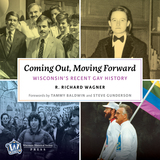 Coming Out, Moving Forward: Wisconsin's Recent Gay History
R. Richard Wagner
Wisconsin Historical Society Press, 2020 Coming Out, Moving Forward, the second volume in R. Richard Wagner’s groundbreaking work on gay history in Wisconsin, outlines the challenges that LGBT Wisconsinites faced in their efforts to right past oppressions and secure equality in the post-Stonewall period between 1969 and 2000. During this era, Wisconsin made history as the first state to enact a gay rights law prohibiting discrimination in employment, housing, and public accommodations on the basis of sexual orientation. It also became the first state to elect three openly gay/lesbian persons to Congress.
In this volume, R. Richard Wagner draws on historical research and materials from his extensive personal archive to not only chronicle an important movement, but also to tell the stories of the state’s LGBT pioneers—from legislators and elected officials to activists, businesspeople, and everyday citizens. Coming Out, Moving Forward documents the rich history of Wisconsin’s LGBT individuals and communities as they pushed back against injustice and found ways to live openly and proudly as themselves.
Coming Out, Moving Forward is a continuation to the first volume in this series, We’ve Been Here All Along.
 Coming Out of My Skin
Jean-Baptiste Phou
Seagull Books, 2023 A compelling memoir that focuses on the intersectionality of race and sexuality experienced by a gay Asian man living in a white world.
Born to Chinese-Cambodian parents in France, Jean-Baptiste Phou has pursued a diverse artistic career since 2008. Through his public views and artistic works, he has focused mainly on the experiences of Asians in France. Up until now, he’s always been careful not to raise issues of sexuality—in particular, his homosexuality.
In this searing memoir, Phou faces his fears and shame to examine the role his ethnic origin has played in the construction of his sexual identity and his romantic relationships in a predominantly white environment. An astute observer of the various ways in which his body has been perceived, Phou explores how these perceptions have shaped his relationship with himself and others. How does a marginalized person develop emotionally and build, reclaim, and express their sexuality? Drawing on various works of history, sociology, gender studies, literature, and popular culture, Phou sensitively examines various strategies developed in response to this question.
Being gay in a largely straight world is difficult but being Asian within this sexual minority can be a doubly oppressive experience. Coming Out of My Skin deftly tackles this challenge and aspires for a reconciliation that can empower people of sexual and racial minorities to joyfully inhabit their bodies.
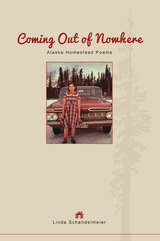 Coming Out of Nowhere: Alaska Homestead Poems
Linda Schandelmeier
University of Alaska Press, 2018 “The earth near our place/ was cradle, / it rocked us— / became our skin. / House doors opened, / spilled us out, / we disappeared into trees— / they clothed us in delirious green. /. . . We knew the song / of this place, made it up, / sang it—”
Homestead life is often romanticized as a valiant, resilient family persisting in the clean isolation of pristine wilderness, living off the land and depending only on each other. But there can be a darker side to this existence.
Linda Schandelmeier was raised on a family homestead six miles south of the fledgling town of Anchorage, Alaska in the 1950s and ’60s. But hers is not a typical homestead story. In this book, part poetic memoir and part historical document, a young girl comes of age in a family fractured by divorce and abuse. Schandelmeier does not shy away from these details of her family history, but she also recognizes her childhood as one that was unique and nurturing, and many of her poems celebrate homestead life. Her words hint at her way of surviving and even transcending the remoteness by suggesting a deeper level of human experience beyond the daily grind of homestead life; a place in which the trees and mountains are almost members of the family. These are poems grounded in the wilds that shimmer with a mythic quality. Schandelmeier’s vivid descriptions of homesteading will draw in readers from all types of lives.
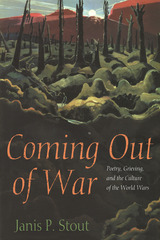 Coming Out of War: Poetry, Grieving, and the Culture of the World Wars
Janis P. Stout
University of Alabama Press, 2005 World War I is widely considered “the Great War” and World War II, “the Good War.” Janis Stout thinks of them as two parts of a whole that continues to engage historians and literary scholars searching for an understanding of both the actual war experiences and the modern culture of grief they embody. In Coming Out of War: Poetry, Grieving, and the Culture of the World Wars Stout argues that poetry, of all the arts, most fully captures and conveys those cultural responses. While probing the work of such well known war poets as Rupert Brooke, Wilfred Owen, and Randall Jarrell, Stout also highlights the impact of the wars on lesser studied, but equally compelling, sources such as the music of Charles Ives and Cole Porter, Aaron Copland and Irving Berlin. She challenges the commonplace belief that war poetry came only from the battlefield and was written only by men by examining the wartime writings of women poets such as Rose Macaulay, Marianne Moore, Elizabeth Bishop, and Gwendolyn Brooks. She also challenges the assumption that World War II did not produce poetry of distinction by studying the work of John Ciardi, Karl Shapiro, Louis Simpson, Robert Frost, and Wallace Stevens. While emphasizing aesthetic continuity between the wars, Stout stresses that the poetry that emerged from each displays a greater variety than is usually recognized. A final chapter considers Benjamin Britten’s War Requiem as a culmination and embodiment of the anti-war tradition in 20th-century poetry and music, and speculates on the reasons why, despite their abundance and eloquence, these expressions of grief and opposition to war have effected so little change.
 Coming Out Republican: A History of the Gay Right
Neil J. Young
University of Chicago Press, 2024 A revelatory and comprehensive history of the gay Right from incisive political commentator Neil J. Young.
One of the most maligned, misunderstood, and even mocked constituencies in American politics, gay Republicans regularly face condemnation from both the LGBTQ+ community and their own political party. Yet they’ve been active and influential for decades. Gay conservatives were instrumental, for example, in ending “Don’t Ask, Don’t Tell” and securing the legalization of same-sex marriage—but they also helped lay the groundwork for the rise of Donald Trump.
In Coming Out Republican, political historian and commentator Neil J. Young provides the first comprehensive history of the gay Right. From the 1950s up to the present day, Young excavates the multifarious origins, motivations, and evolutions of LGBTQ+ people who found their way to the institutions and networks of modern conservatism. Many on the gay Right have championed conservative values—like free markets, a strong national defense, and individual liberty—and believed that the Republican Party therefore offered LGBTQ+ people the best pathway to freedom. Meanwhile, that same party has actively and repeatedly demonized them. With his precise and provocative voice, Young details the complicated dynamics of being in—and yet never fully accepted into—the Republican Party.
Coming Out Republican provides striking insight into who LGBTQ+ conservatives are, what they want, and why many of them continue to align with a party whose rank and file largely seem to hate them. As the Republican Party renews its assaults on LGBTQ+ rights, understanding the significant history of the gay Right has never been more critical.
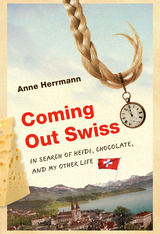 Coming Out Swiss: In Search of Heidi, Chocolate, and My Other Life
Anne Herrmann
University of Wisconsin Press, 2014 Anne Herrmann, a dual citizen born in New York to Swiss parents, offers in Coming Out Swiss a witty, profound, and ultimately universal exploration of identity and community. “Swissness”—even on its native soil a loose confederacy, divided by multiple languages, nationalities, religion, and alpen geography—becomes in the diaspora both nowhere (except in the minds of immigrants and their children) and everywhere, reflected in pervasive clichés.
In a work that is part memoir, part history and travelogue, Herrmann explores all our Swiss clichés (chocolate, secret bank accounts, Heidi, Nazi gold, neutrality, mountains, Swiss Family Robinson) and also scrutinizes topics that may surprise (the “invention” of the Alps, the English Colony in Davos, Switzerland’s role during World War II, women students at the University of Zurich in the 1870s). She ponders, as well, marks of Swissness that have lost their identity in the diaspora (Sutter Home, Helvetica, Dadaism) and the enduring Swiss American community of New Glarus, Wisconsin. Coming Out Swiss will appeal not just to the Swiss diaspora but also to those drawn to multi-genre writing that blurs boundaries between the personal and the historical.
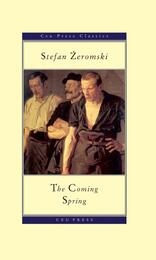 The Coming Spring
Stefan Zeromski
Central European University Press, 2007 The Coming Spring (Przedwiosnie), Zeromski's last novel, tells the story of Cezary Baryka, a young Pole who finds himself in Baku, Azerbaijan, then a predominantly Armenian city, as the Russian Revolution breaks out. He becomes embroiled in the chaos caused by the revolution, and barely escapes with his life. Then, he and his father set off on a horrendous journey west to reach Poland. His father dies en route, but Cezary makes it to the newly independent Poland. Cezary sees the suffering of the poor, yet his experiences in the newly formed Soviet Union make him suspicious of socialist and communist solutions. He is an outsider among both the gentry and the working classes, and he cannot find where he belongs. Furthermore, he has unsuccessful and tragic love relations. The novel ends when, despite his profound misgivings, he takes up political action on behalf of the poor. Zeromski, whose vivid, assured style is instantly recognizable, was a writer with a strong social conscience, taking up the concerns of the poor and downtrodden.
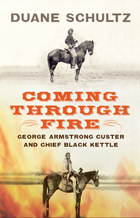 Coming Through Fire: George Armstrong Custer and Chief Black Kettle
Duane Schultz
Westholme Publishing, 2012 The Attack Along the Washita River, Custer’s Last Victory and the Action That Led to the Plains Indians’ United Quest for Retribution
The cold dawn of November 27, 1868, was the moment George Armstrong Custer had longed for ever since the Civil War ended three years before. It was also the moment Black Kettle of the Cheyenne nation had feared ever since he had survived the deadly attack on his people at Sand Creek, Colorado Territory. Custer, who gloried in battle, was no longer the national hero, the celebrity he had been in wartime. He was a forgotten man who had failed in his first Indian campaign the year before. He needed a resounding victory to resurrect the attention he craved, and the sleepy Cheyenne village along the banks of the Washita River—ironically near present-day Cheyenne, Oklahoma—proved irresistible. Custer led his 7th U.S. Cavalry in an early morning charge that wiped out the encampment, killing those who resisted and some of those who fled. Black Kettle’s Cheyenne had signed documents of peace with the U.S. Government as they had done before Sand Creek, but once again that did not protect them. Custer ordered his troops to capture women and children and traveled with these prisoners as a way to shield his column from a retaliatory strike on their way back to their post. Called both a massacre and a battle, the action at the Washita River returned Custer to national prominence as the “greatest Indian fighter of all.”
Coming Through Fire: George Armstrong Custer and Chief Black Kettle tells the converging stories of a Civil War hero and a native warrior who met along the Washita River. Black Kettle had given up fighting—he had “come through the fire”— and made his mark on treaty after treaty to try to save the Cheyenne and their way of life from the encroachments of the U.S. government and white settlers. He watched the government breach the terms of each treaty, yet he continued to work for a compromise, knowing that negotiations were the only way his people could survive. But the flood of wagon trains and settlements, the killing of the great buffalo herds, the new diseases and broken promises, political ambition, naked greed, and continuing restrictions on land, food, and shelter persisted. As the U.S. Army, including Custer, continued to attack and forceably move Indians to reservations despite treaties indicating otherwise, Black Kettle’s dreams of peace were shattered. He ended his life face down in the freezing waters of the Washita River, shot by one of Custer’s troopers. The “greatest Indian fighter” would not survive the Indian Wars either, cut down near the Little Big Horn River, in part for his actions against Black Kettle and the Cheyenne.
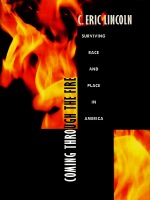 Coming through the Fire: Surviving Race and Place in America
C. Eric Lincoln
Duke University Press, 1996 In Coming through the Fire, prominent scholar and writer C. Eric Lincoln addresses the most important issue of our time with insights forged by a lifetime of confronting racial oppression in America. Born in a small rural town in northern Alabama, raised by his grandparents, Lincoln portrays in rich detail the nuances of racial conflict and control that characterized the community of Athens, personal experiences which would lead him to dedicate his life to illuminating issues of race and social identity. The contradictions and calamities of being black and poor in the United States become a purifying fire for his searing analyses of the contemporary meanings of race and color.
Coming through the Fire, with its fiercely intelligent, passionate, and clear-eyed view of race and class conflict, makes a major contribution to understanding—and thereby healing—the terrible rift that has opened up in the heart of America. Lincoln explores the nature of biracial relationships, the issue of transracial adoption, violence—particularly black-on-black violence—the “endangered” black male, racism as power, the relationship between Blacks and Jews, our multicultural melting pot, and Minister Louis Farrakhan.Without sidestepping painful issues, or sacrificing a righteous anger, the author argues for “no-fault reconciliation,” for mutual recognition of the human endowment we share regardless of race, preparing us as a nation for the true multiculture tomorrow will demand.
Readers familiar with Lincoln’s earlier groundbreaking work on the Black Muslims and on the black church will be eagerly awaiting the publication of Coming through the Fire. Others will simply find C. Eric Lincoln’s personal story and his exploration of survival and race in America to be absorbing and compelling reading.
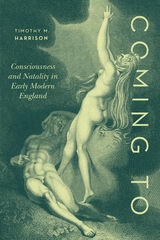 Coming To: Consciousness and Natality in Early Modern England
Timothy M. Harrison
University of Chicago Press, 2020 In Coming To, Timothy M. Harrison uncovers the forgotten role of poetry in the history of the idea of consciousness. Drawing our attention to a sea change in the English seventeenth century, when, over the course of a half century, “conscience” made a sudden shift to “consciousness,” he traces a line that leads from the philosophy of René Descartes to the poetry of John Milton, from the prenatal memories of theologian Thomas Traherne to the unresolved perspective on natality, consciousness, and ethics in the philosophy of John Locke. Each of these figures responded to the first-person perspective by turning to the origins of how human thought began. Taken together, as Harrison shows, this unlikely group of thinkers sheds new light on the emergence of the concept of consciousness and the significance of human natality to central questions in the fields of literature, philosophy, and the history of science.
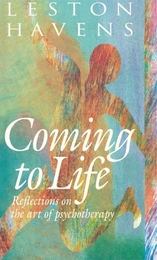 Coming to Life: Reflections on the Art of Psychotherapy
Leston Havens
Harvard University Press, 1993 To penetrate the opaque, to lift the weight and let the self escape its frozen image—this is the essence of psychotherapy, a process described with extraordinary grace and warmth in this book. In remarkably candid portraits of patients at odds with themselves, Leston Havens takes us through the wonders and rigors of psychological healing and shows us what it really means, in immediate, human terms, to come to life.
We are all captives of the images we carry with us—and those we inspire—and therapy seeks to expose the relation of these images to a deeper psychological life, to free the captive from labels and crippling assumptions. Havens views this process through the multiple lenses of literature, art, and psychiatry. In rich clinical portraits, short on jargon and rigid techniques and long on empathy and wisdom, we encounter ordinary people struggling with the trials of their own existence: marriage and divorce, sexual identity and fulfillment, illness and death. We meet a woman imprisoned by eager responses to her beauty and helpfulness, a proud lawyer in thrall to conventional expectations, a dying man becoming more and more alive as he approaches death.
Through these very personal stories, Havens explores the meaning of psychological health—how it can be recognized through the filter of images and ideas, protected from their distorting power, and encouraged to flourish. The result is a revealing and deeply moving explication of the process of self-discovery as it emerges from the life story that therapy can tell.
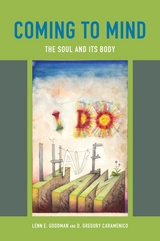 Coming to Mind: The Soul and Its Body
Lenn E. Goodman and D. Gregory Caramenico
University of Chicago Press, 2013 How should we speak of bodies and souls? In Coming to Mind, Lenn E. Goodman and D. Gregory Caramenico pick their way through the minefields of materialist reductionism to present the soul not as the brain’s rival but as its partner. What acts, they argue, is what is real. The soul is not an ethereal wisp but a lively subject, emergent from the body but inadequately described in its terms.
Rooted in some of the richest philosophical and intellectual traditions of Western and Eastern philosophy, psychology, literature, and the arts and the latest findings of cognitive psychology and brain science—Coming to Mind is a subtle manifesto of a new humanism and an outstanding contribution to our understanding of the human person. Drawing on new and classical understandings of perception, consciousness, memory, agency, and creativity, Goodman and Caramenico frame a convincing argument for a dynamic and integrated self capable of language, thought, discovery, caring, and love.
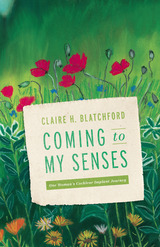 Coming to My Senses: One Woman's Cochlear Implant Journey
Claire H. Blatchford
Gallaudet University Press, 2014 Deafened at the age of six, Claire Blatchford was educated orally with speech lessons, speechreading, and hearing aids. Though successful both professionally and domestically, at the age of 67 Blatchford decided to undergo a cochlear implantation. In this memoir, she describes in prose and verse living with a cochlear implant for the past three years. At first, Blatchford feared losing the last of her hearing through the surgical process. Her audiologist explained that her hearing was worsening and that soon she would move from profound deafness into a state called “cosmic deafness.” Blatchford decided upon the surgery in hope of meeting her hearing family on their turf, and of again hearing the wind, rain, rivers, and crickets. After being implanted, however, she realized that amplification and comprehension were two different things: at first, all she heard was a soup of sound, a condition known as being brain deaf. Blatchford soon learned, however, that regaining her hearing was a journey of discovery. Gradually, the sound soup gave way to the ability to hear some sentences without speechreading. The sound of her own voice surprised her, and she could hear her grandchildren speak. The thrill of new things heard on one car trip to a friend’s house moved her to “try my first yodel as I pass by your house.” When asked by others if they should receive an implant, she cautions that it is an individual decision that each deaf person must make. For her, it was the right decision.
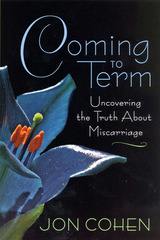 Coming to Term: Uncovering the Truth About Miscarriage
Cohen, Jon
Rutgers University Press, 2007 After his wife lost four pregnancies, Jon Cohen set out to gather the most comprehensive and accurate information on miscarriage-a topic shrouded in myth, hype, and uncertainty. The result of his mission is a uniquely revealing and inspirational book for every woman who has lost at least one pregnancy-and for her partner, family, and close friends. Approaching the topic from a reporter's perspective, Cohen takes us on an intriguing journey into the laboratories and clinics of researchers at the front, weaving together their cutting-edge findings with intimate portraits of a dozen families who have had difficulty bringing a baby to term. Couples who seek medical help for miscarriage often encounter conflicting information about the causes of pregnancy loss and ways to prevent it. Cohen's investigation synthesizes the latest scientific findings and unearths some surprising facts. We learn, for example, that nearly seven out of ten women who have had three or more miscarriages can still carry a child to term without medical intervention. Cohen also scrutinizes the full array of treatments, showing readers how to distinguish promising new options from the useless or even dangerous ones. Coming to Term is the first book to turn a journalistic spotlight on a subject that has remained largely in the shadows. With an unrelenting eye and the compassion that comes from personal experience, Jon Cohen offers a message that is both enlightening and unexpectedly hopeful.
 Coming To Terms: A Theory of Writing Assessment
Patricia Lynne
Utah State University Press, 2004 In a provocative book-length essay, Patricia Lynne argues that most programmatic assessment of student writing in U.S. public and higher education is conceived in the terms of mid-20th century positivism. Since composition as a field had found its most compatible home in constructivism, she asks, why do compositionists import a conceptual frame for assessment that is incompatible with composition theory? By casting this as a clash of paradigms, Lynne is able to highlight the ways in which each theory can and cannot influence the shape of assessment within composition. She laments, as do many in composition, that the objectively oriented paradigm of educational assessment theory subjugates and discounts the very social constructionist principles that empower composition pedagogy. Further, Lynne criticizes recent practice for accommodating the big business of educational testing—especially for capitulating to the discourse of positivism embedded in terms like "validity" and "reliability." These terms and concepts, she argues, have little theoretical significance within composition studies, and their technical and philosophical import are downplayed by composition assessment scholars. There is a need, Lynne says, for terms of assessment that are native to composition. To open this needed discussion within the field, she analyzes cutting-edge assessment efforts, including the work of Broad and Haswell, and she advances a set of alternate terms for evaluating assessment practices, a set of terms grounded in constructivism and composition. Coming to Terms is ambitious and principled, and it takes a controversial stand on important issues. This strong new volume in assessment theory will be of serious interest to assessment specialists and their students, to composition theorists, and to those now mounting assessments in their own programs.
“Coming to Writing” and Other Essays
Hélène Cixous
Harvard University Press, 1991 This collection presents six essays by one of France’s most remarkable contemporary authors. A notoriously playful stylist, here Hélène Cixous explores how the problematics of the sexes—viewed as a paradigm for all difference, which is the organizing principle behind identity and meaning—manifest themselves, write themselves, in texts. These superb translations do full justice to Cixous’s prose, to its songlike flow and allusive brilliance.
Coming Together: The Cinematic Elaboration of Gay Male Life, 1945-1979
Ryan Powell
University of Chicago Press, 2019 In Coming Together, Ryan Powell captures the social and political vitality of the first wave of movies made by, for, and about male-desiring men in the United States between World War II and the 1980s. From the underground films of Kenneth Anger and the Gay Girls Riding Club to the gay liberation-era hardcore films and domestic dramas of Joe Gage and James Bidgood, Powell illuminates how central filmmaking and exhibition were to gay socializing and worldmaking. Unearthing scores of films and a trove of film-related ephemera, Coming Together persuasively unsettles popular histories that center Stonewall as a ground zero for gay liberation and visibility. Powell asks how this generation of movie-making—which defiantly challenged legal and cultural norms around sexuality and gender—provided, and may still provide, meaningful models for living.
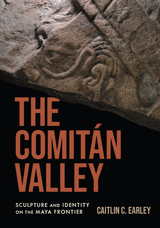 The Comitán Valley: Sculpture and Identity on the Maya Frontier
Caitlin C. Earley
University of Texas Press, 2023 A thousand years ago, the Comitán Valley, in the Mexican state of Chiapas, was the western edge of the Maya world. Far from the famous power centers of the Classic period, the valley has been neglected even by specialists. Here, Caitlin C. Earley offers the first comprehensive study of sculpture excavated from the area, showcasing the sophistication and cultural vigor of a region that has largely been ignored. Supported by the rulers of the valley’s cities, local artists created inventive works that served to construct civic identities. In their depictions of warrior kings, ballgames, rituals, and ancestors, the artists of Comitán made choices that reflected political and religious goals and distinguished the artistic production of the Comitán Valley from that of other Maya locales. After the Maya abandoned their powerful lowland centers, those in Comitán were maintained, a distinction from which Earley draws new insights concerning the Maya collapse. Richly illustrated with never-before-published photographs of sculptures unearthed from key archaeological sites, The Comitán Valley is an illuminating work of art historical recovery and interpretation.
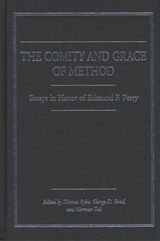 The Comity and Grace of Method: Essays in Honor of Edmund F. Perry
Thomas Ryba
Northwestern University Press, 2004 A work that at once celebrates and extends the formidable contributions of the late Edmund Perry to the study of religions, this comprehensive collection brings together three generations of distinguished scholars to consider the history, theory, and applications of the comparative method in religious study. Both the title and the content of this volume reflect Perry's conviction that the comparative religionist is morally bound to contribute to a comity of religions-the voluntary and courteous recognition of the dignity and truth present in all religions. Following the general framework advocated by Perry for this pursuit, the volume reveals the strengths of such a framework-and of Perry's lifelong interest in theory and method--for religious understanding,
The essays in the first section—"Theory and Method in the History and Study of Religion"—clarify the role of scientific, phenomenological, and comparative approaches within the history of the study of religion; collectively, they represent a multifaceted statement about recurring and subtle problems in the field. In the second section—"Theories and Methods in Application"—the authors move from overarching theoretical concerns to the application of these methods in specific religious traditions, Western and Eastern. The third section demonstrates the effectiveness of these theories and methods as guidelines for promoting global inter-religious comity.
More than a fitting tribute to a revered and highly influential scholar, this book gives even those who knew nothing of Perry and his work much to learn from and ponder about the study of religion.
Commager on Tocqueville
Henry Steele Commager
University of Missouri Press, 1993
Commager on Tocqueville is Henry Steele Commager's masterful interpretation of Alexis de Tocqueville's Democracy in America. Using Tocqueville's classic as a vehicle for discussing such contemporary issues as the environment, civil rights, and the military-industrial complex, Commager calls for a new vision of American leadership that trascends nationalism.
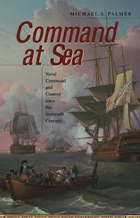 Command at Sea: Naval Command and Control since the Sixteenth Century
Michael A. Palmer
Harvard University Press, 2007 Commanders at sea struggle not only with the unpredictability of natural elements, but also with a shroud of uncertainty often referred to as the "fog of war." Over the centuries most admirals yielded to the natural temptation to find in new technologies a means to assert centralized control over their forces. But other commanders have recognized the fog for what it is: a constant level of uncertainty resistant to mere technological solution.
In this grand history of naval warfare, Michael Palmer observes five centuries of dramatic encounters under sail and steam. From reliance on signal flags in the seventeenth century to satellite communications in the twenty-first, admirals looked to the next advance in technology as the one that would allow them to control their forces. But while abilities to communicate improved, Palmer shows how other technologies simultaneously shrank admirals' windows of decision. The result was simple, if not obvious: naval commanders have never had sufficient means or time to direct subordinates in battle.
Successful commanders as distant as Horatio Nelson (1758-1805) and Arleigh Burke (1901-1996) accepted this reality. They sought solutions to the dilemmas of command in the personal indoctrination of subordinates through discussion, comradeship, and displays of trust and confidence. Such leaders created a commonality of vision and fostered a high degree of individual initiative. Their decentralized approach to command resulted in a resiliency that so often provided the key to success in battle.
Palmer's exciting and enlightening history reveals the myriad efforts of naval commanders to navigate the fog of war.
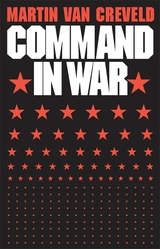 Command in War
Martin Van Creveld
Harvard University Press, 1985 Many books have been written about strategy, tactics, and great commanders. This is the first book to deal exclusively with the nature of command itself, and to trace its development over two thousand years from ancient Greece to Vietnam. It treats historically the whole variety of problems involved in commanding armies, including staff organization and administration, communications methods and technologies, weaponry, and logistics. And it analyzes the relationship between these problems and military strategy.
In vivid descriptions of key battles and campaigns—among others, Napoleon at Jena, Moltke’s Königgrätz campaign, the Arab–Israeli war of 1973, and the Americans in Vietnam—Martin van Creveld focuses on the means of command and shows how those means worked in practice. He finds that technological advances such as the railroad, breech-loading rifles, the telegraph and later the radio, tanks, and helicopters all brought commanders not only new tactical possibilities but also new limitations.
Although vast changes have occurred in military thinking and technology, the one constant has been an endless search for certainty—certainty about the state and intentions of the enemy’s forces; certainty about the manifold factors that together constitute the environment in which war is fought, from the weather and terrain to radioactivity and the presence of chemical warfare agents; and certainty about the state, intentions, and activities of one’s own forces. The book concludes that progress in command has usually been achieved less by employing more advanced technologies than by finding ways to transcend the limitations of existing ones.
The Command of the Air
Giulio Douhet, translated by Dino Ferrari
University of Alabama Press, 2009 The Italian General Giulio Douhet reigns as one of the twentieth century’s foremost strategic air power theorists. As such scholars as Raymond Flugel have pointed out, Douhet’s theories were crucial at a pivotal pre-World War II Army Air Force institution, the Air Corps Tactical School.
Command of the Waters: Iron Triangles, Federal Water Development, and Indian Water
Daniel McCool
University of Arizona Press, 1994 Much has been written about legal questions surrounding Indian water rights; this book now places them in the political framework that also includes water development. McCool analyzes the two conflicting doctrines relating to water use—one based on federal case law governing the rights of Indians on reservations, the other sanctioned by legislation and applied to non-Indians—based on the "iron triangles" of bureaucrats, legislators, and interest groups that dominate policy issues. He examines the way federal and BIA water development programs have reacted to conflict, competition, and opportunity from the turn of the century to the 1980s and updates the situation in an introduction written for this edition.
|
|




